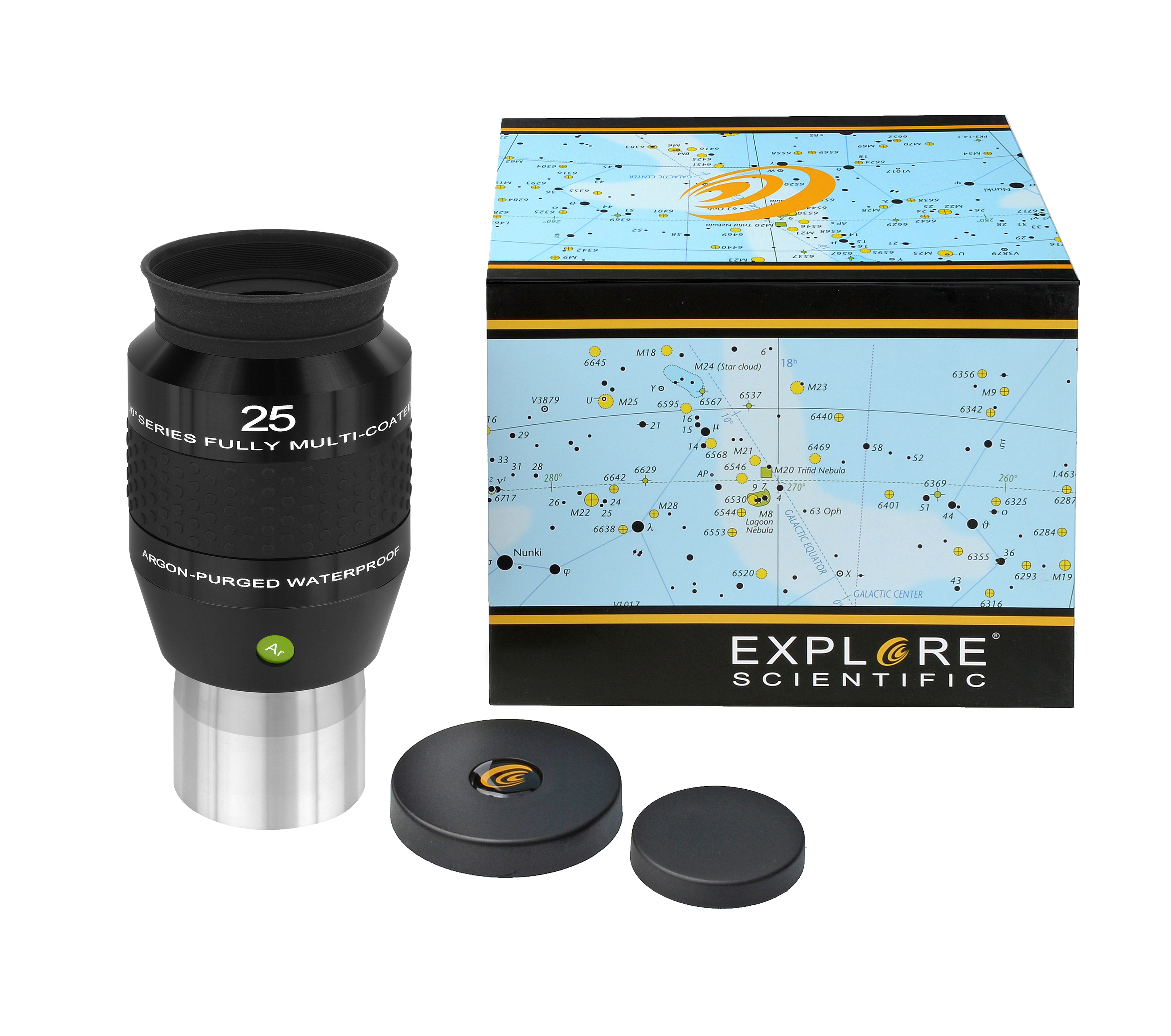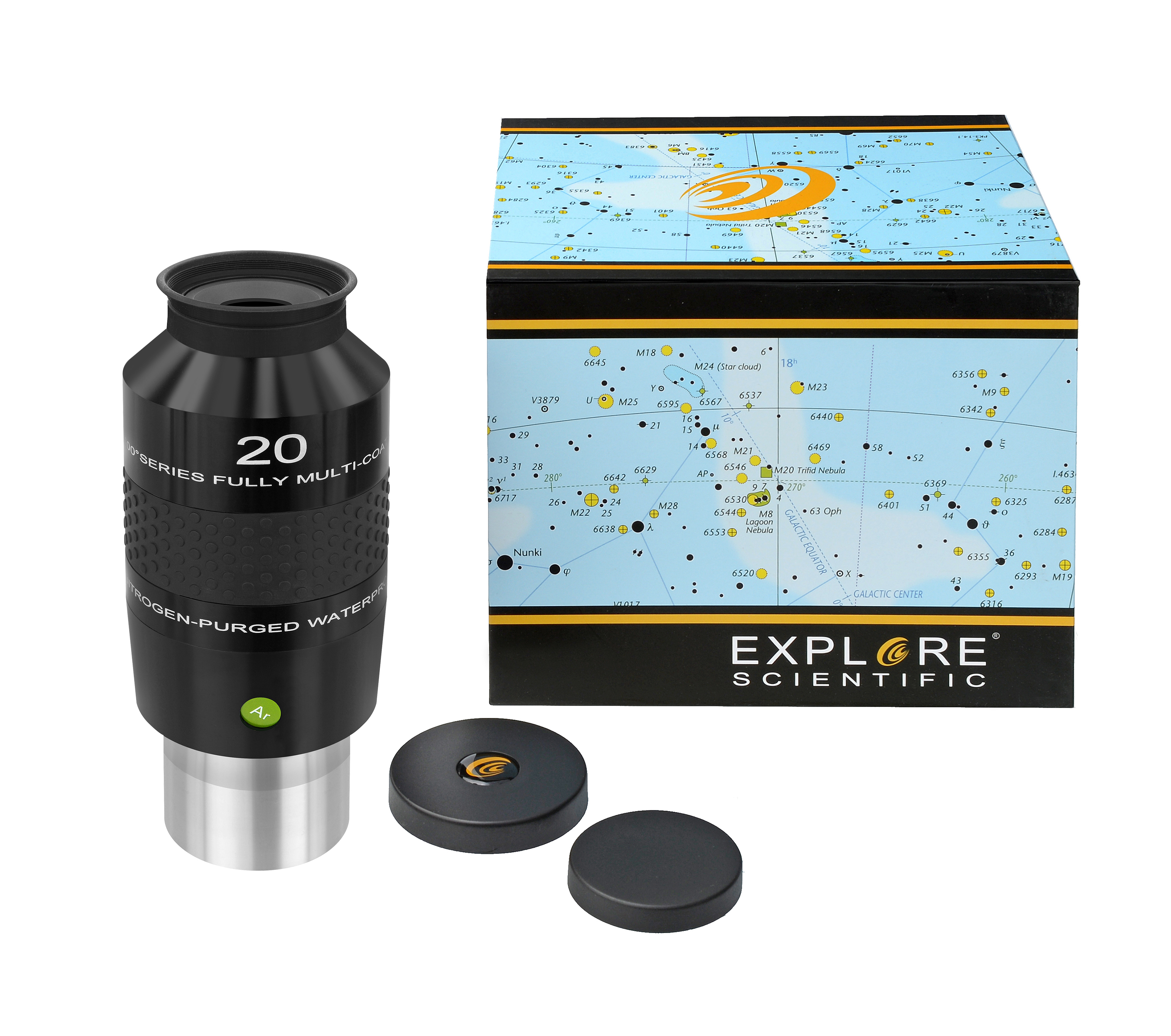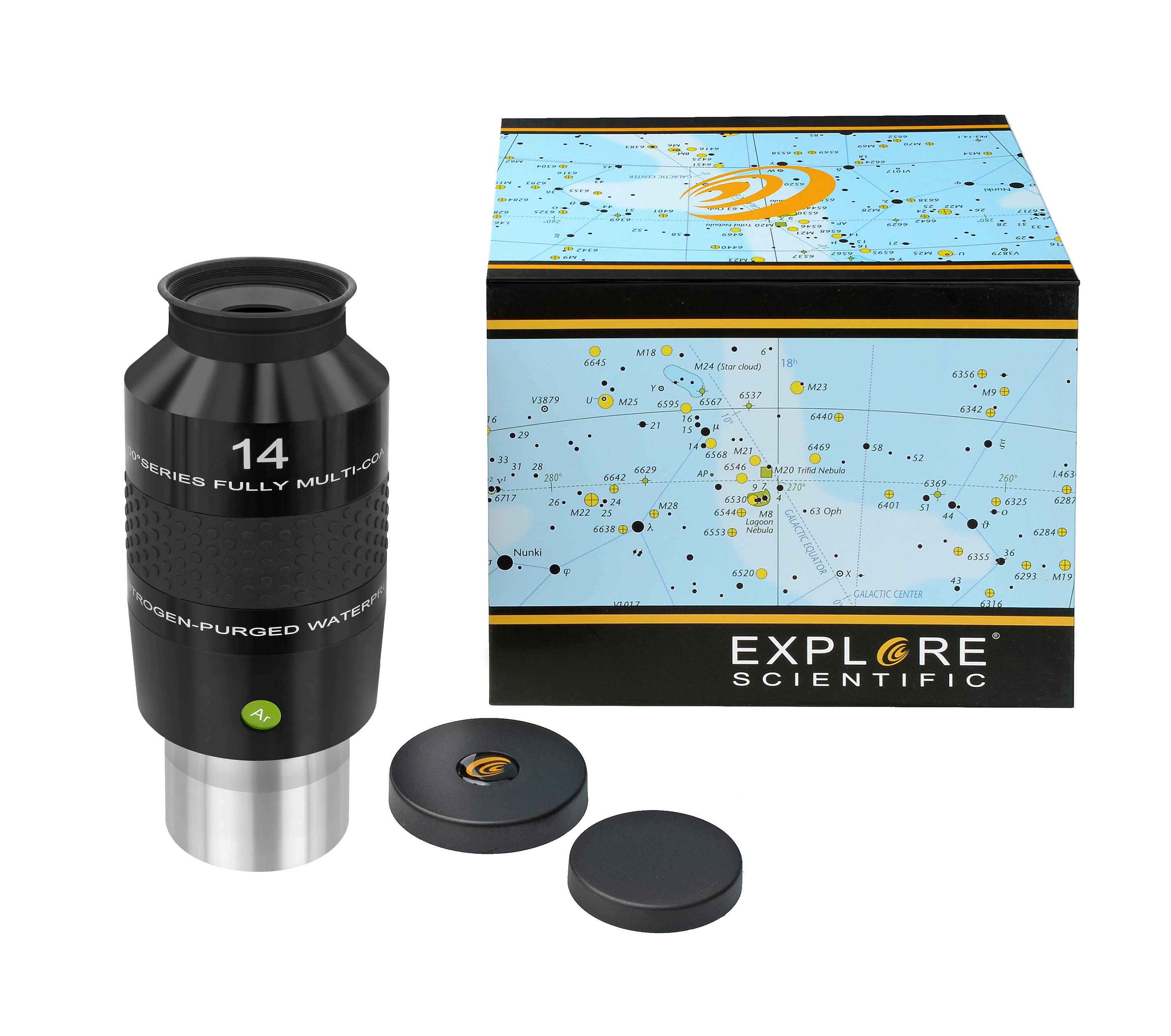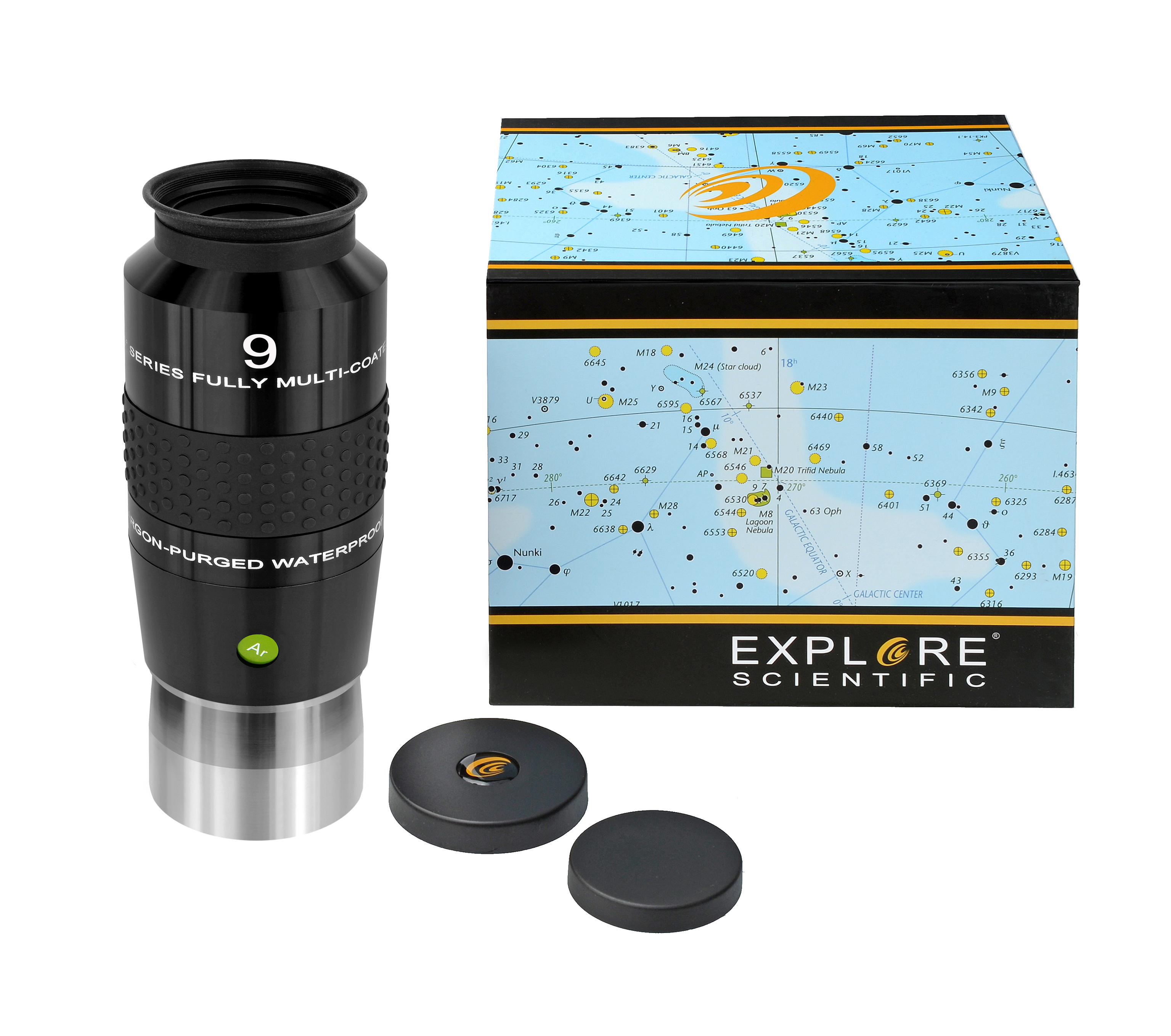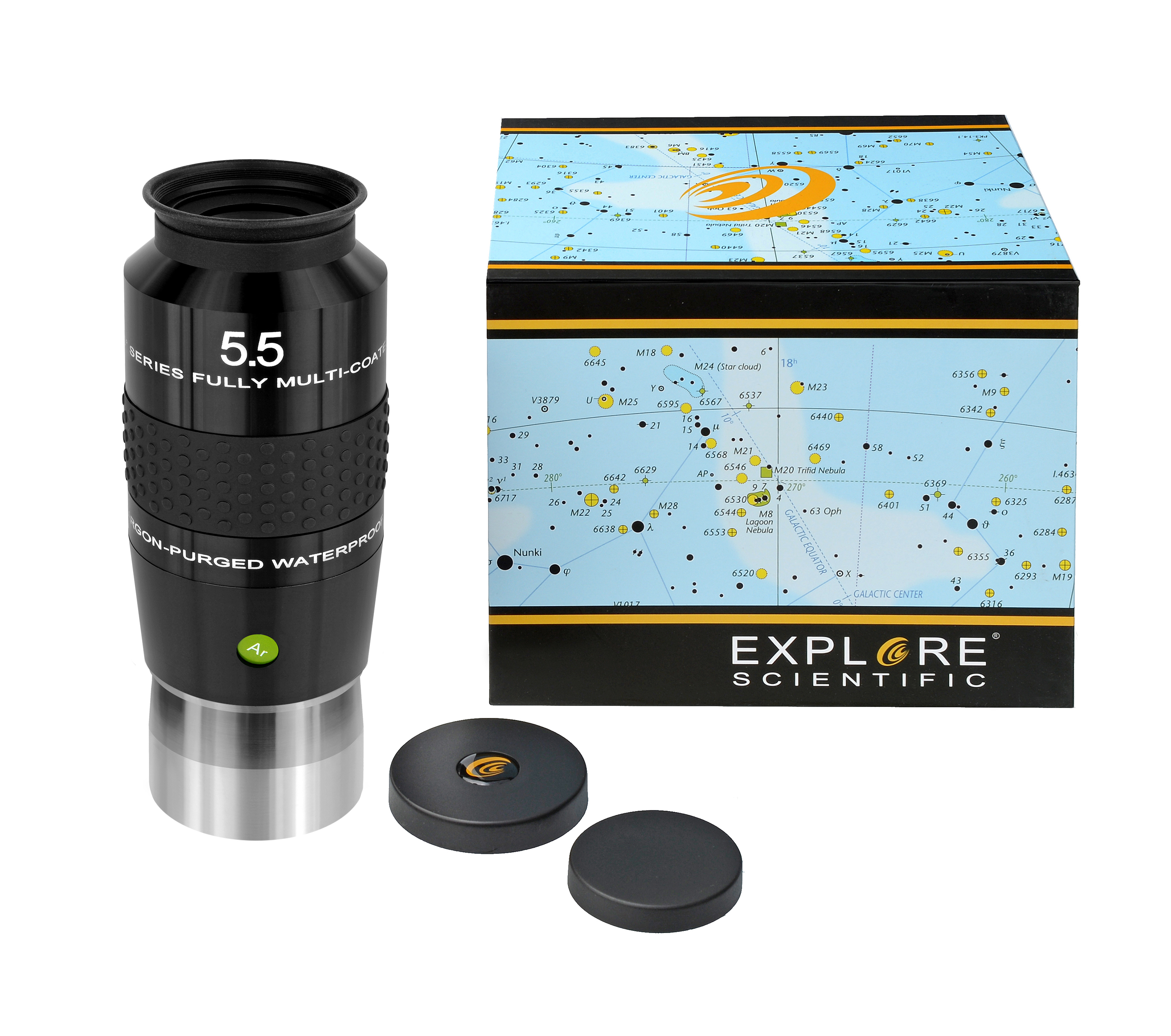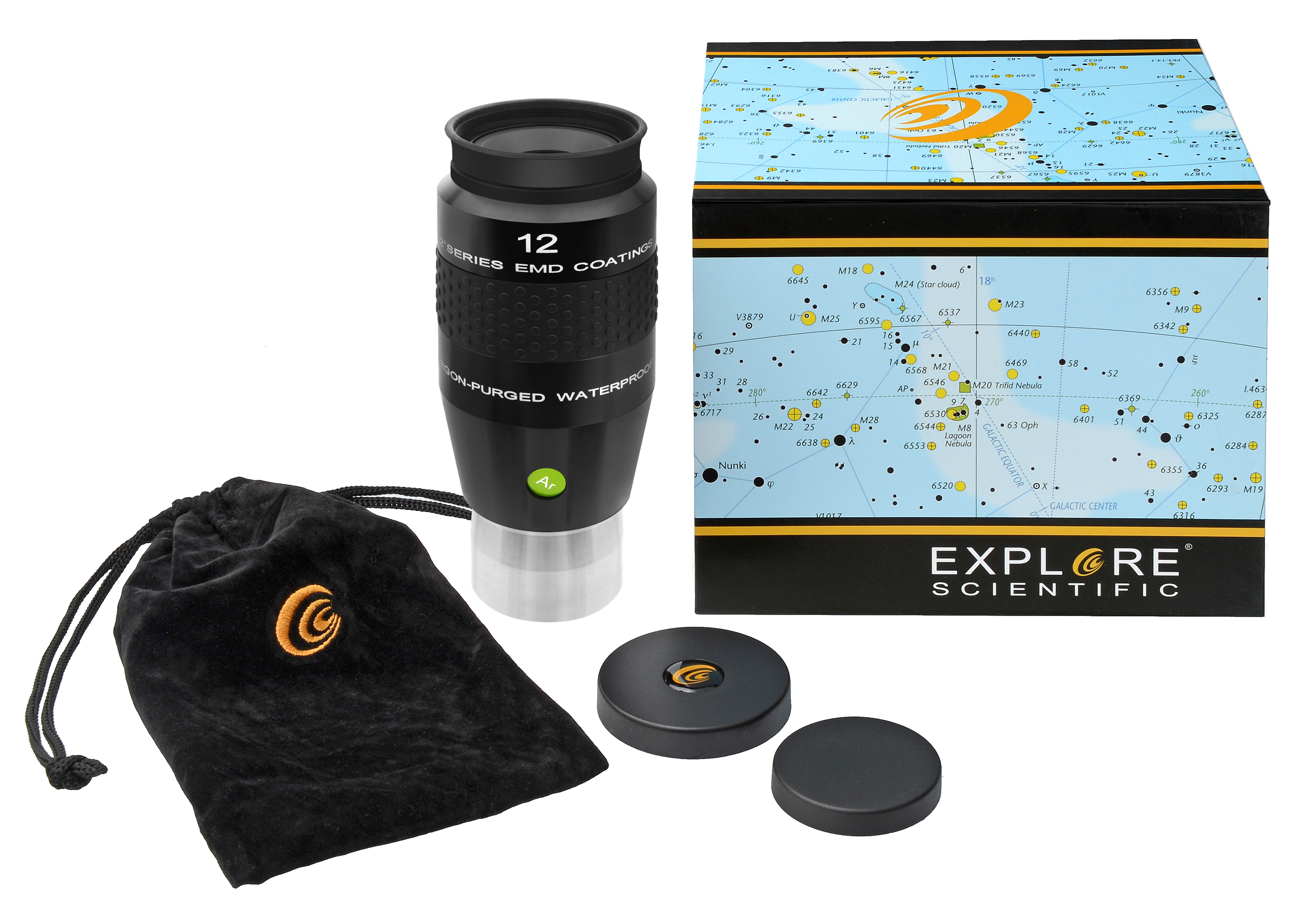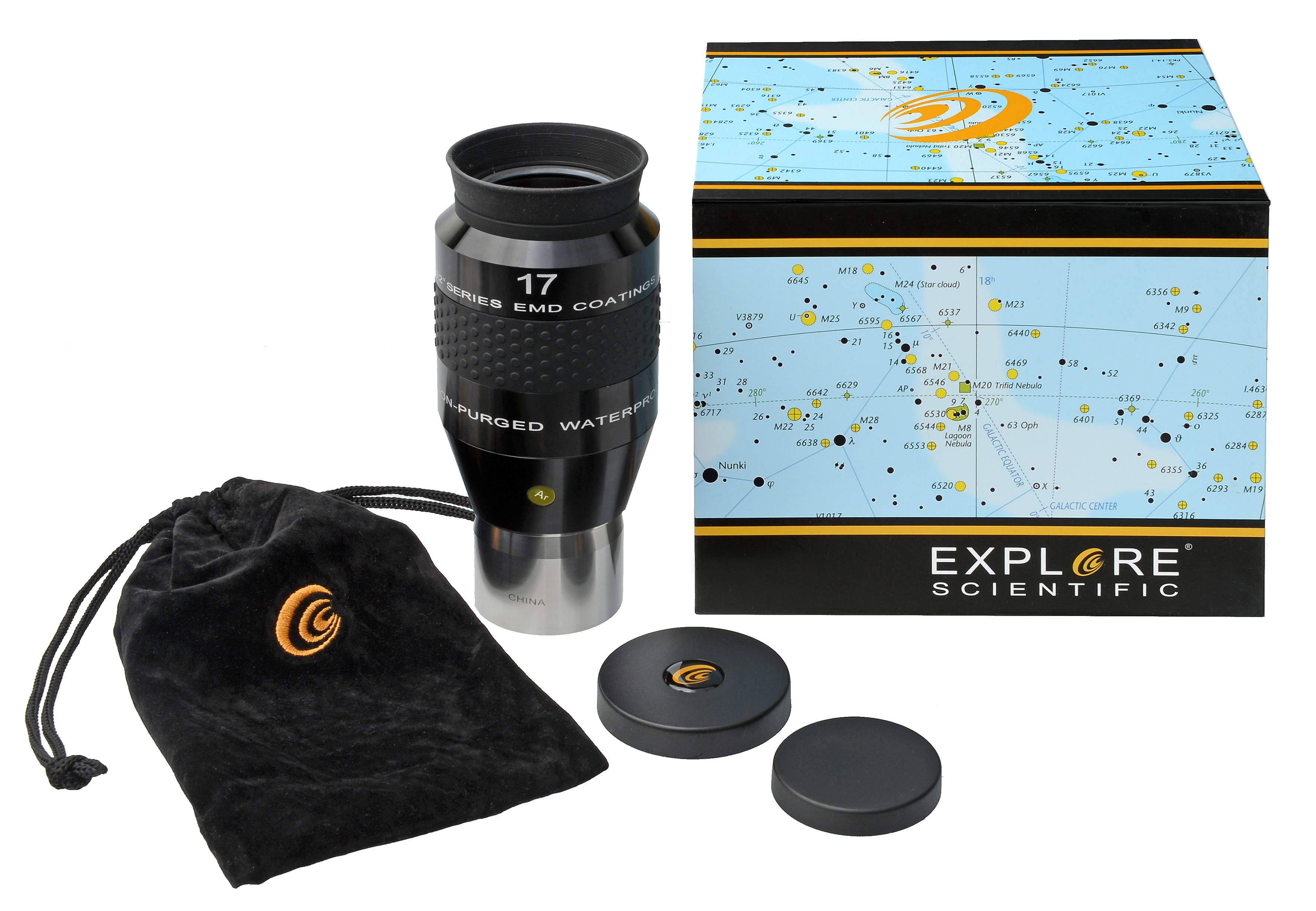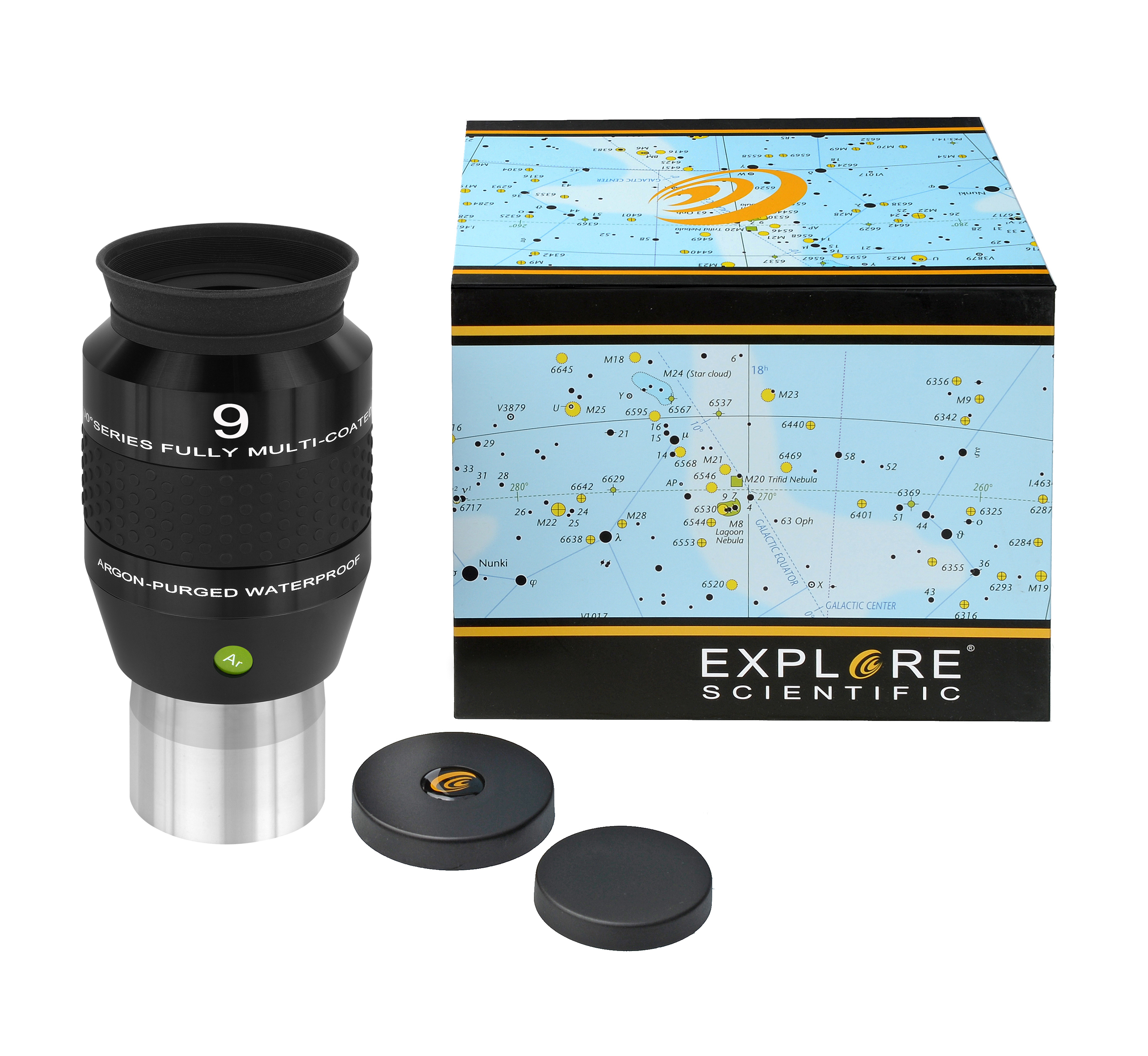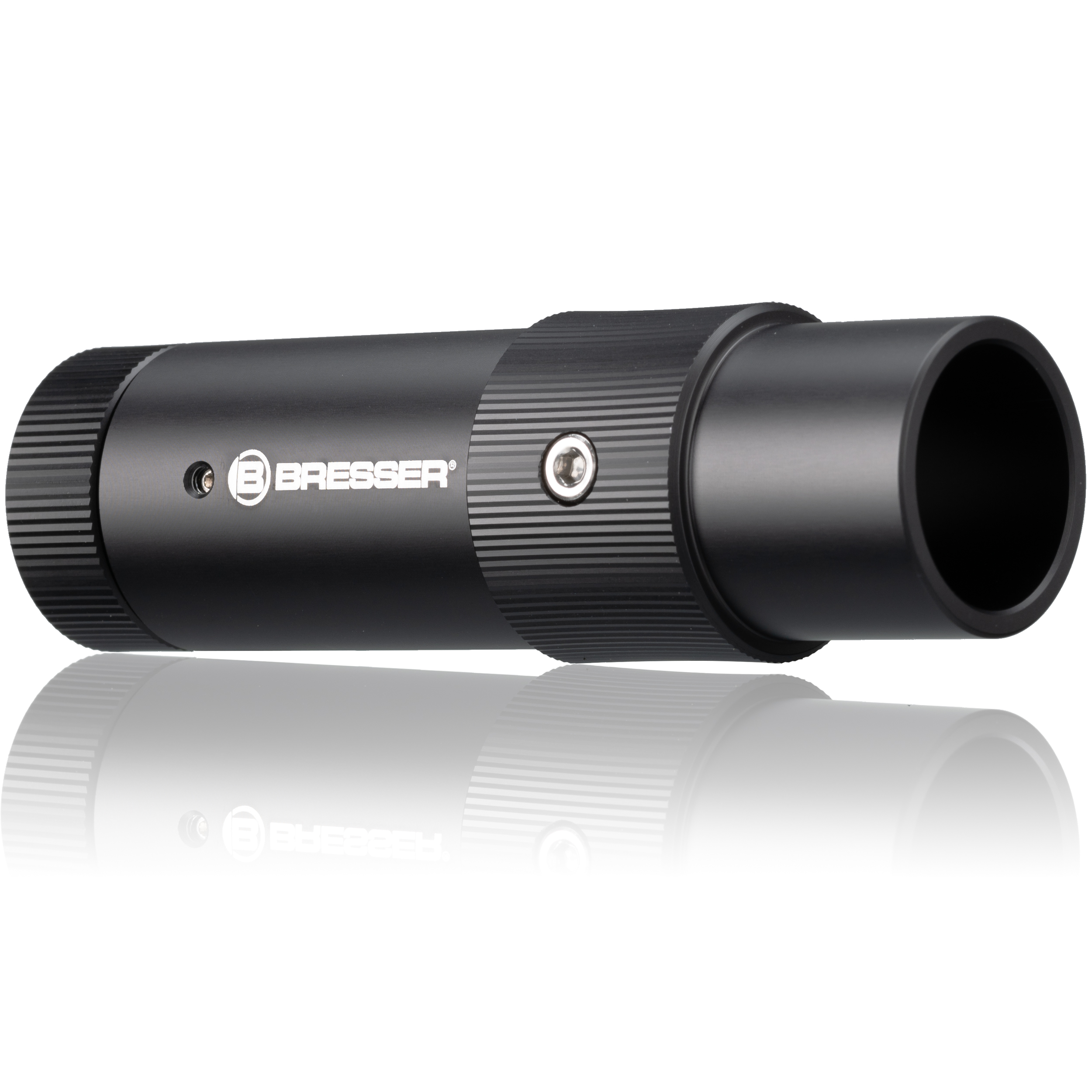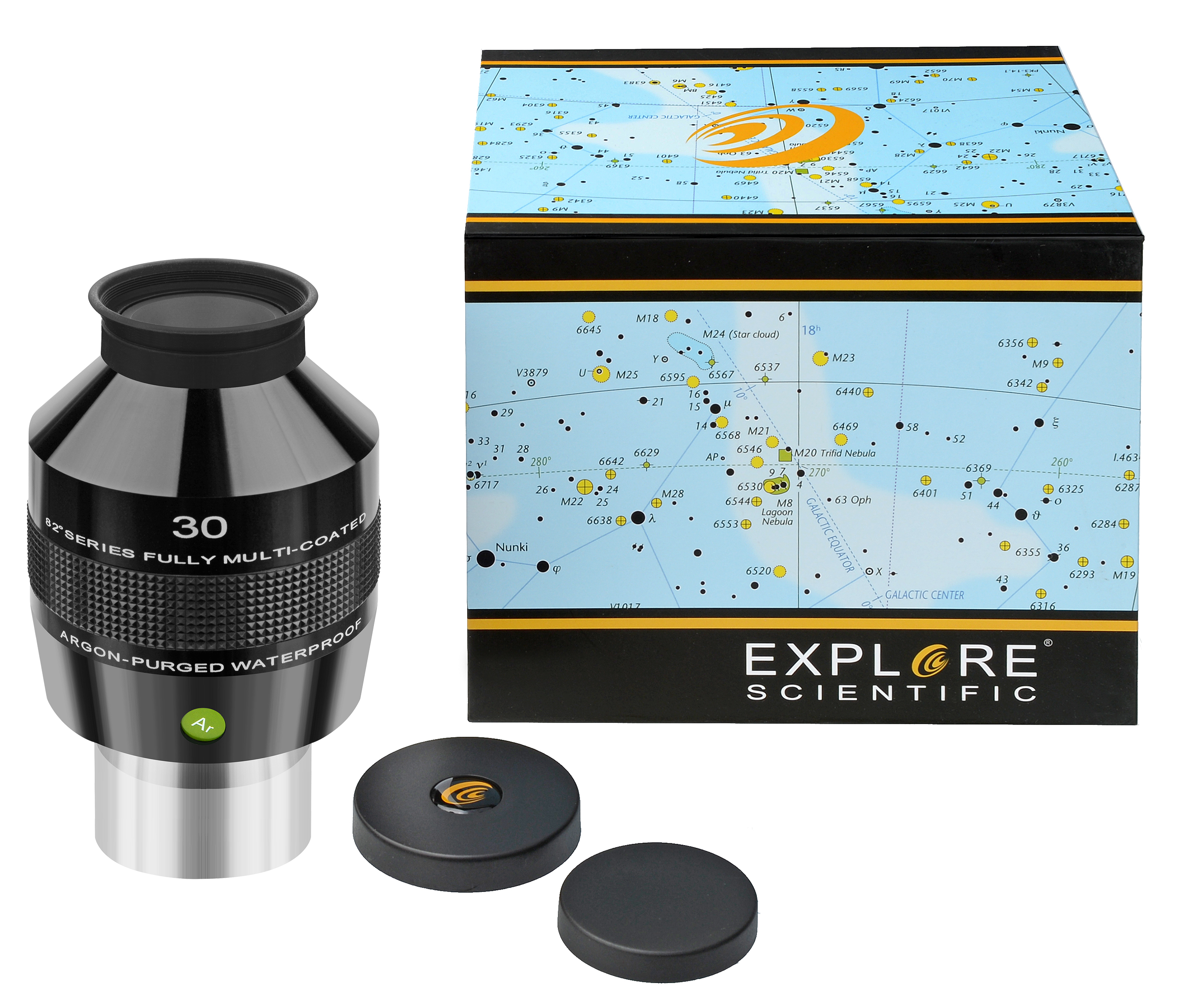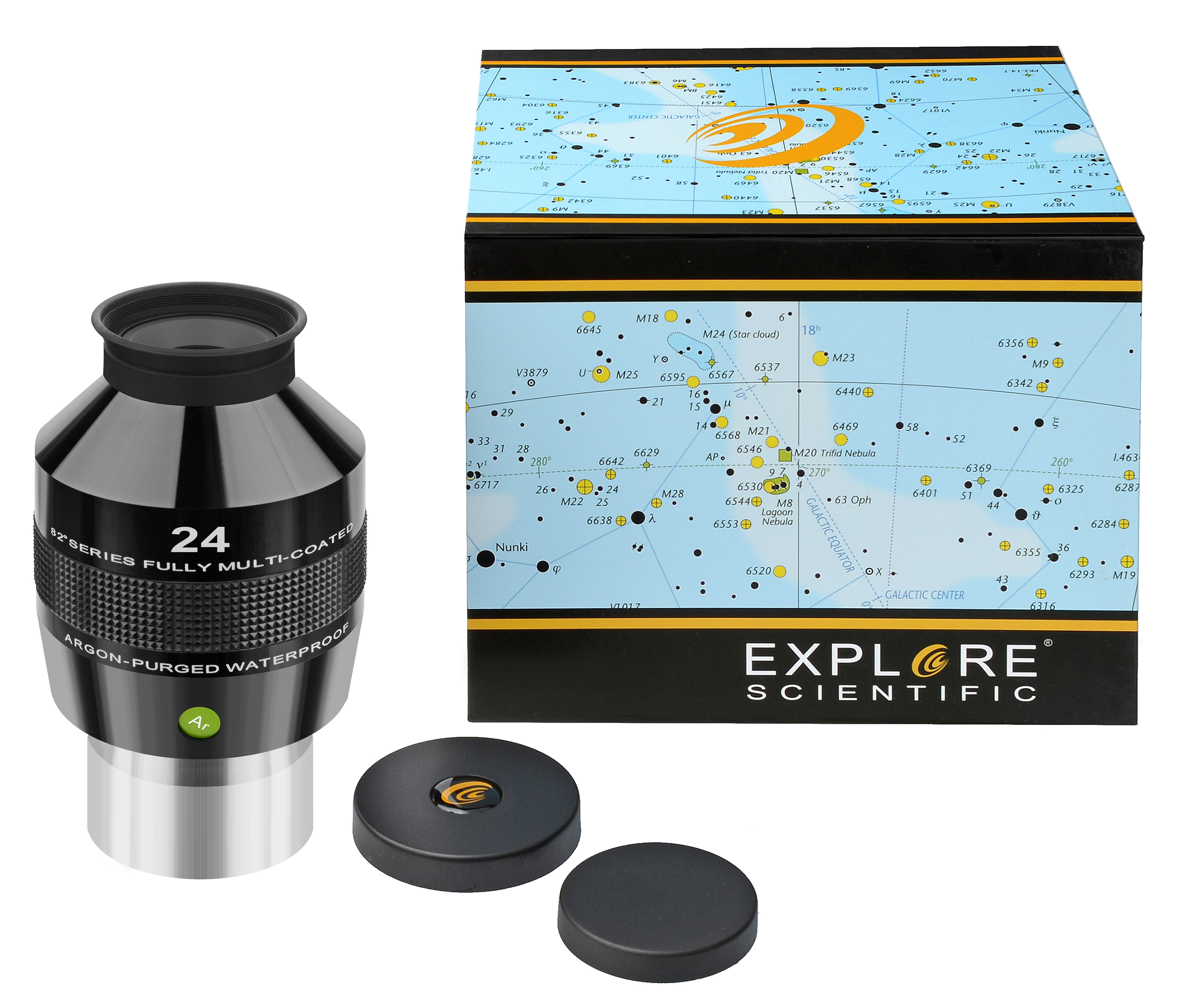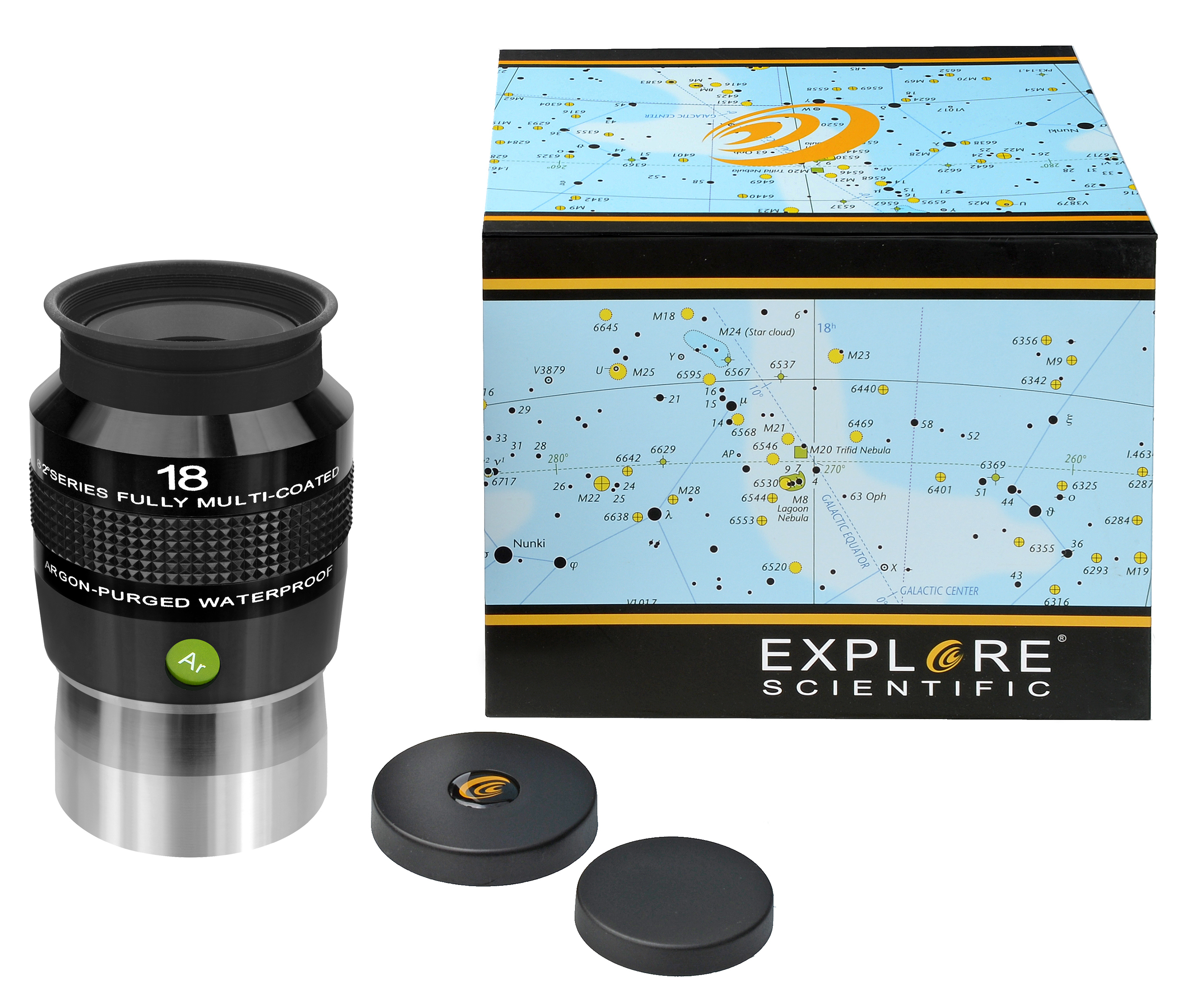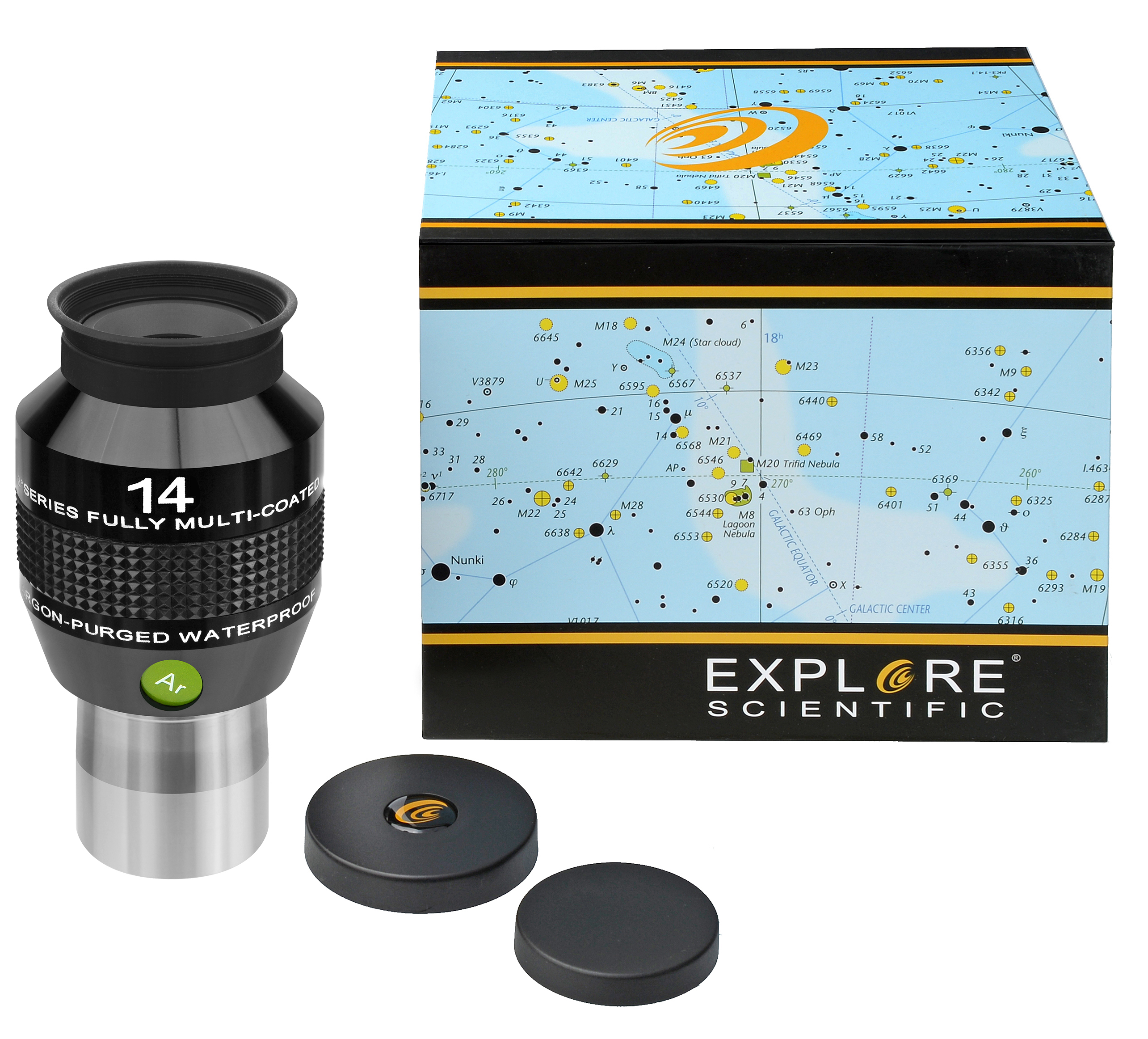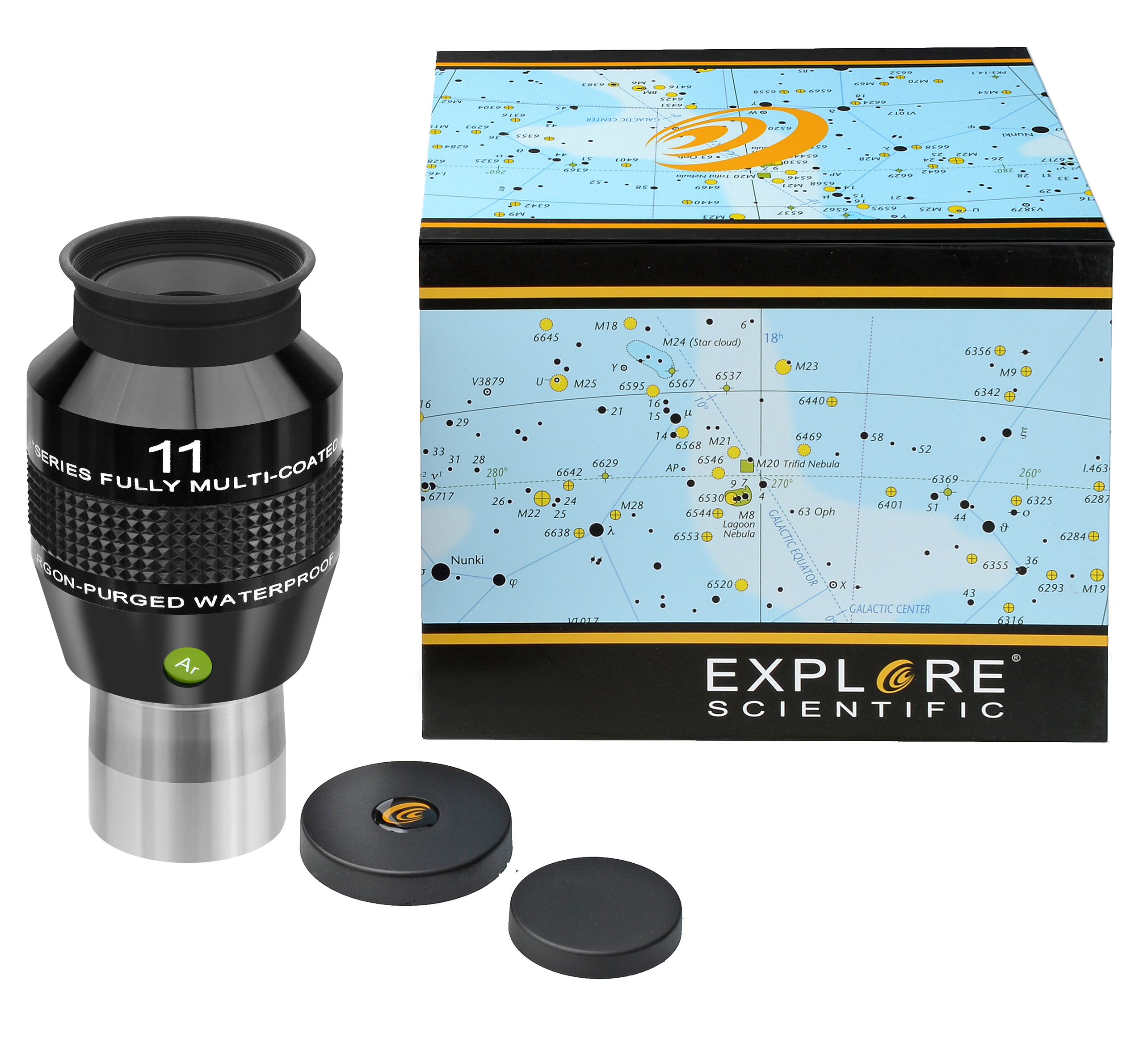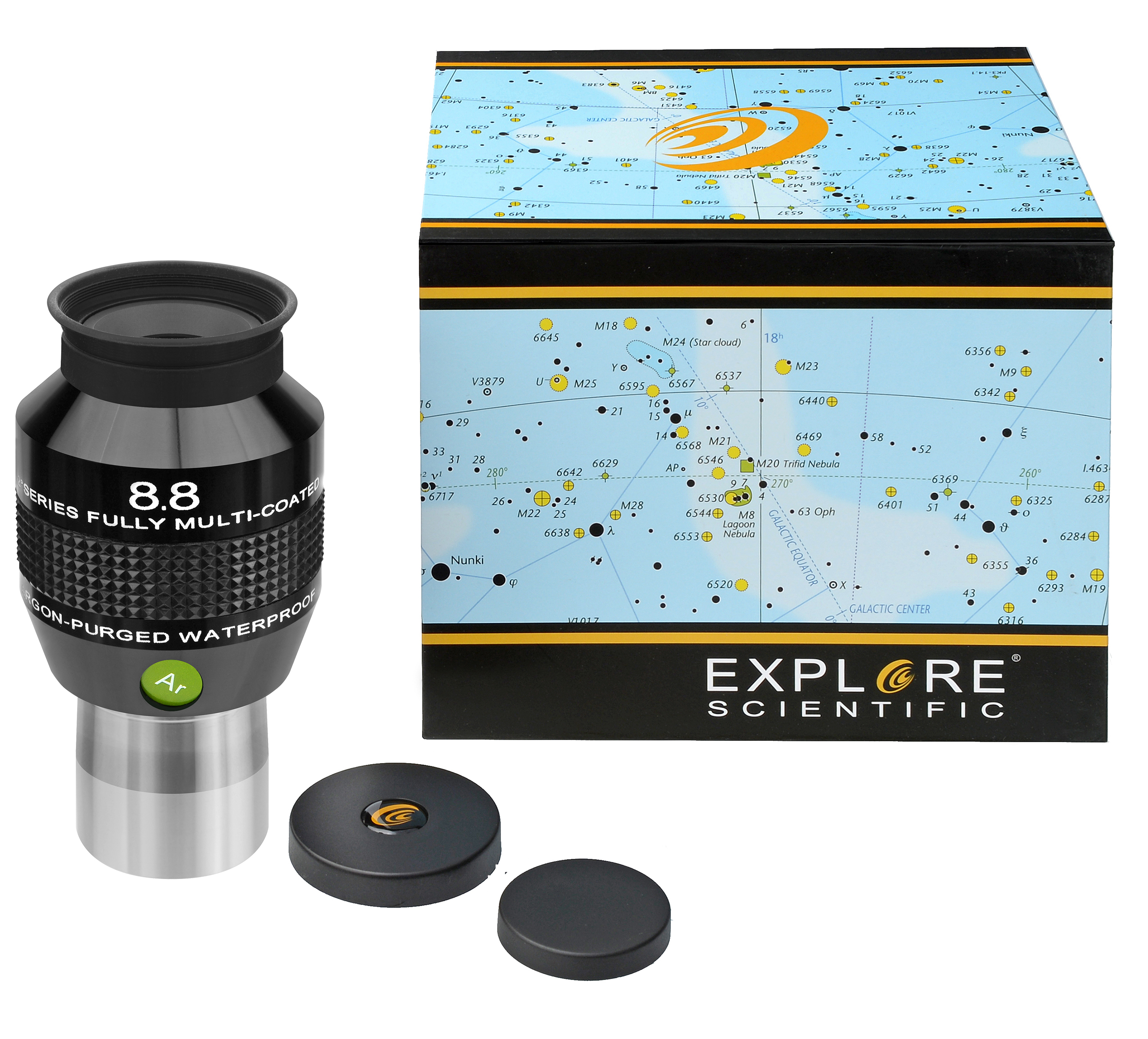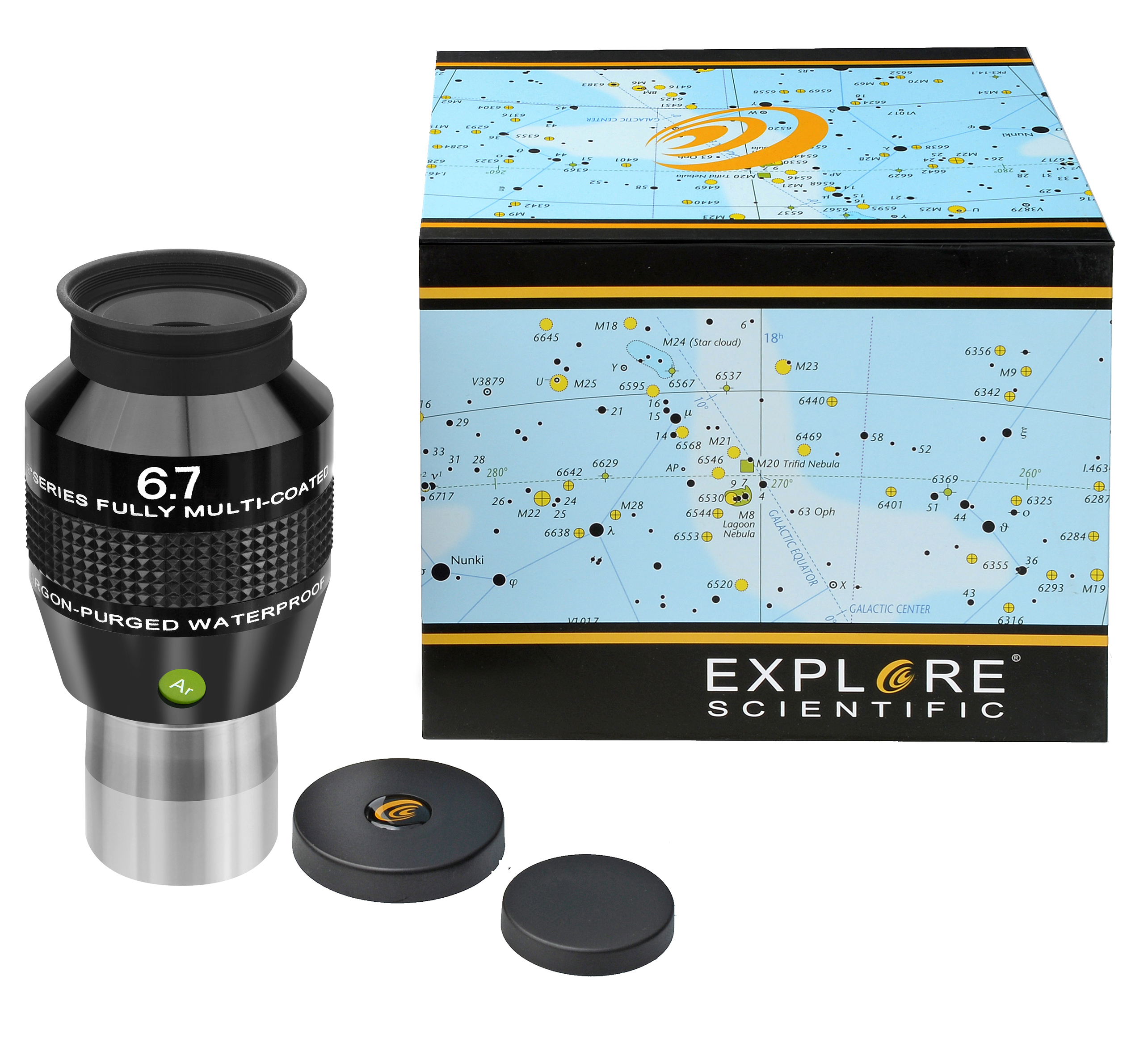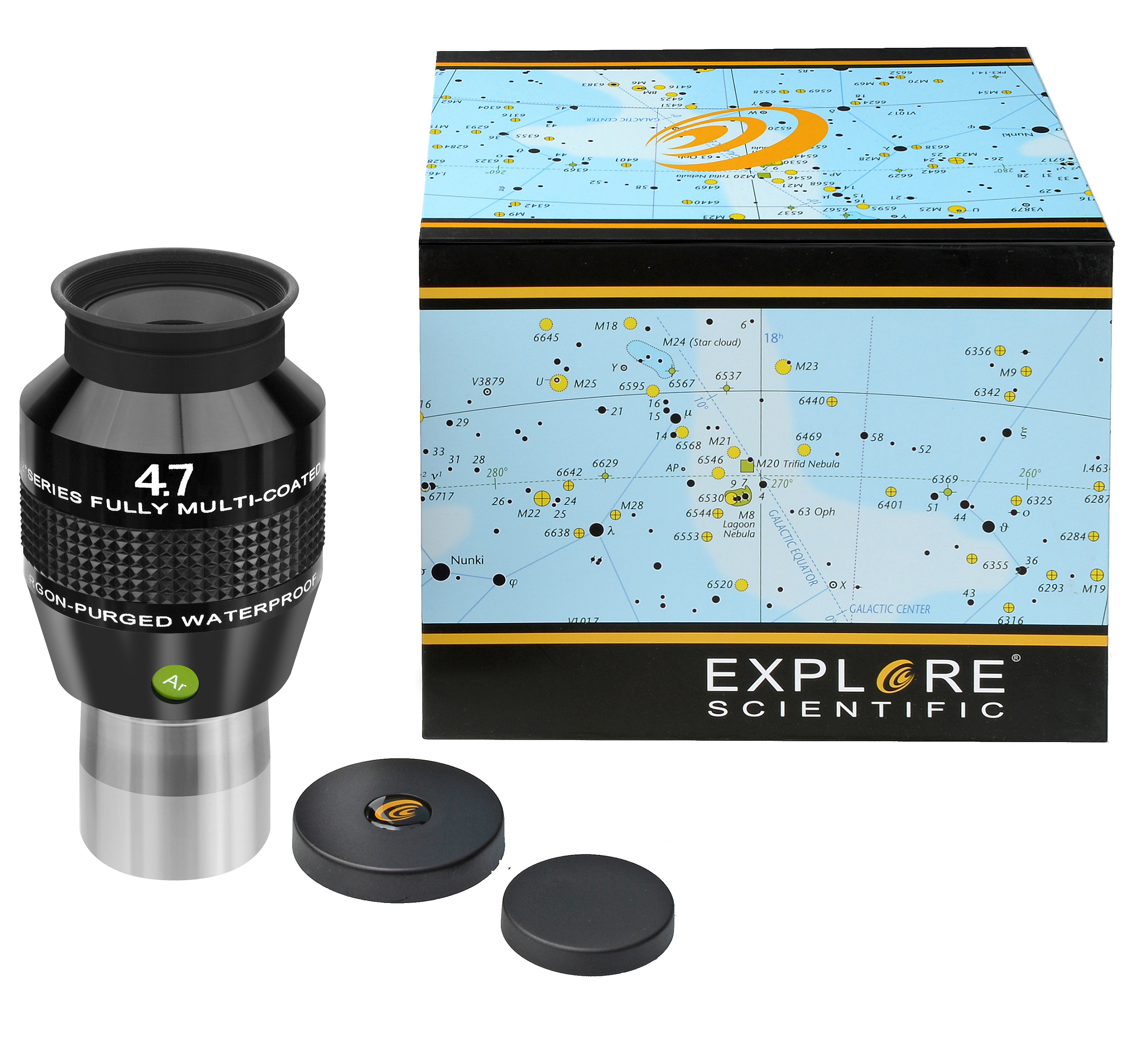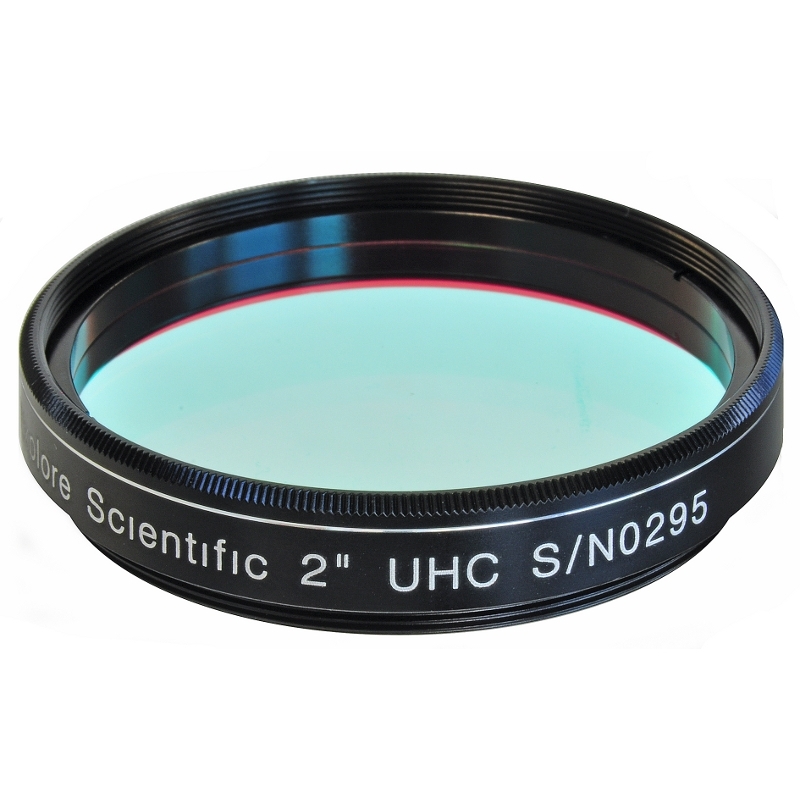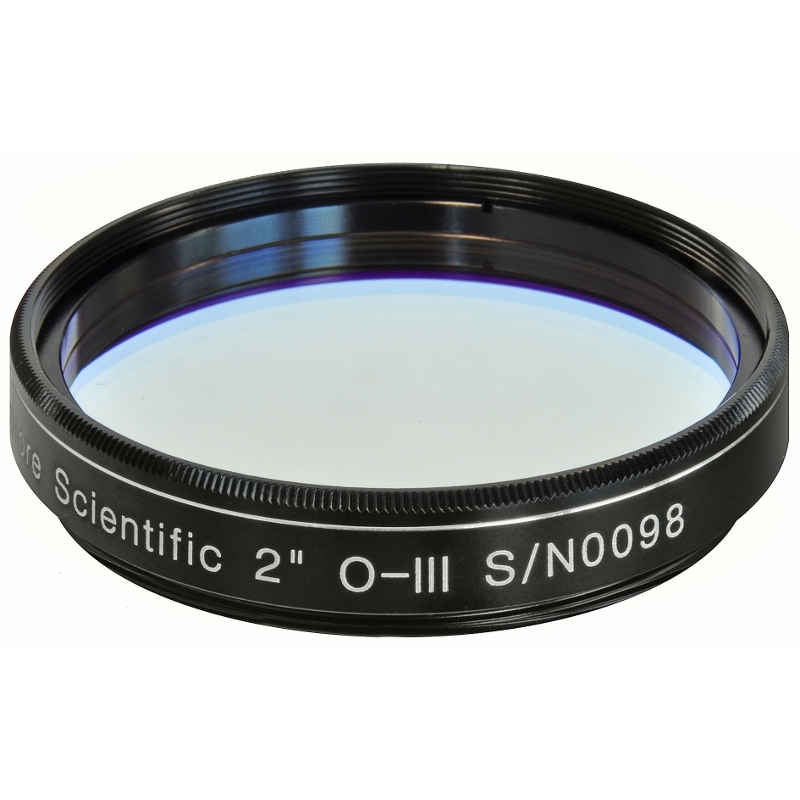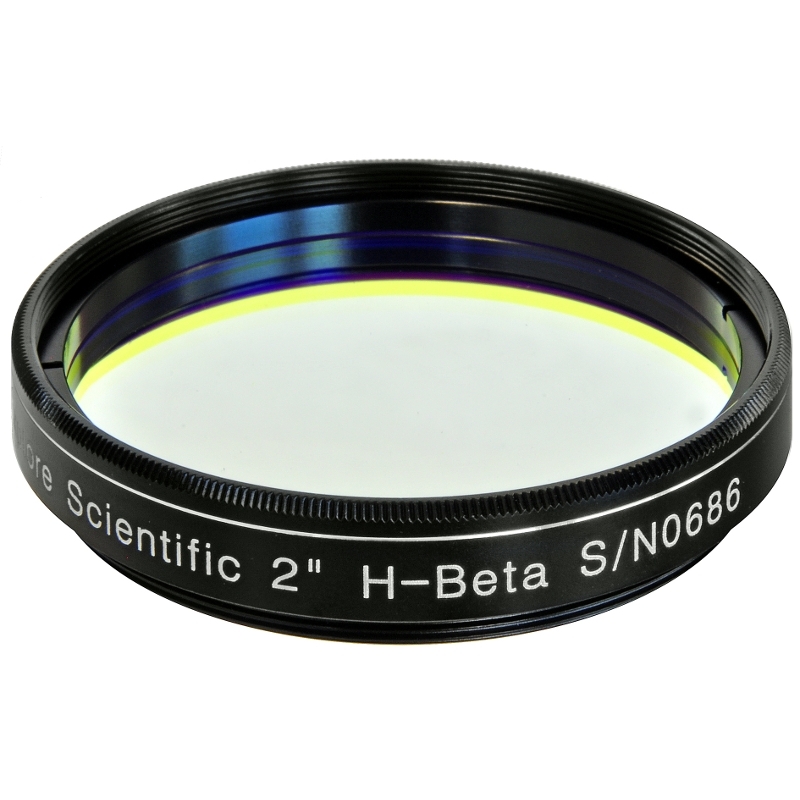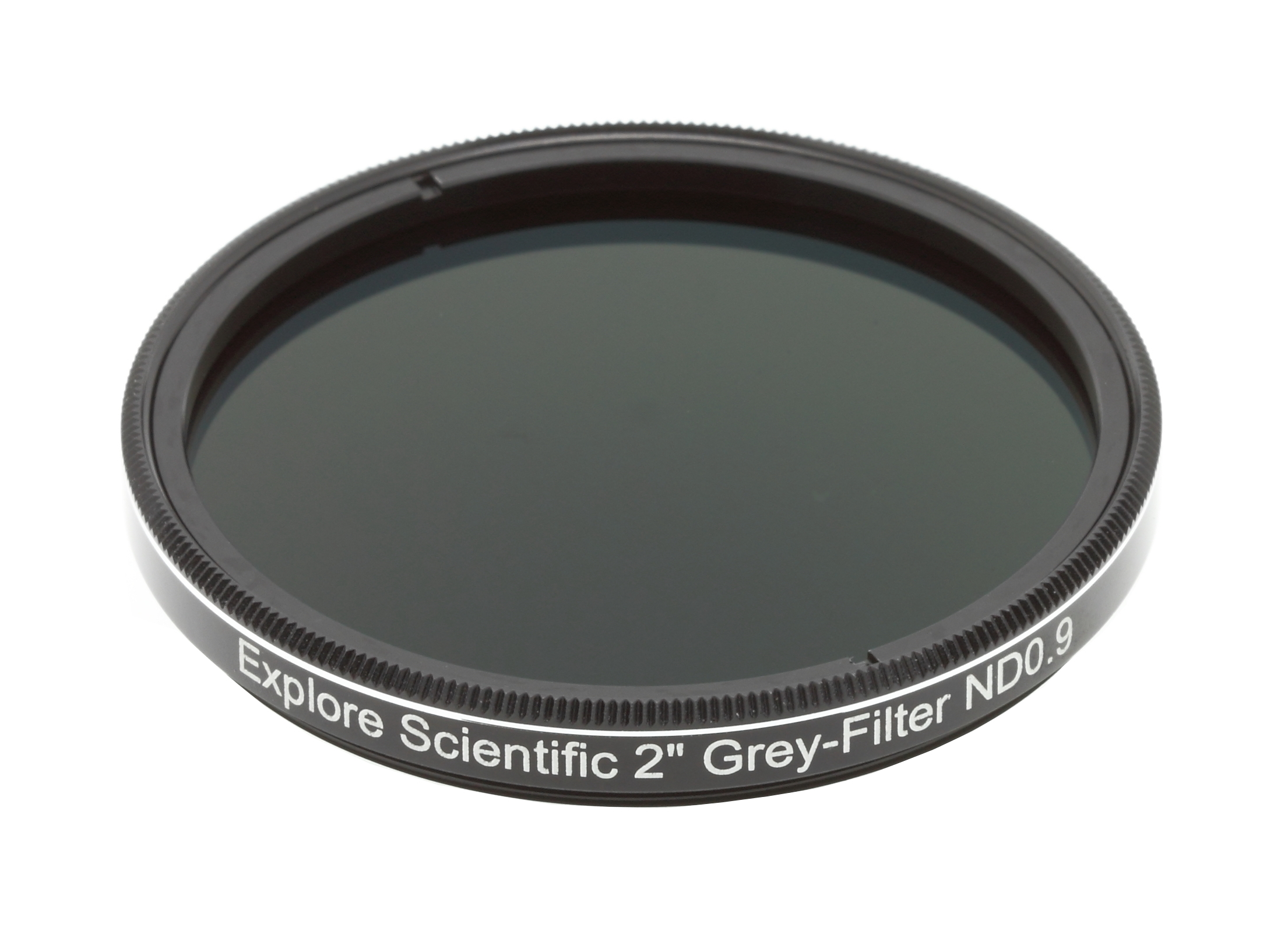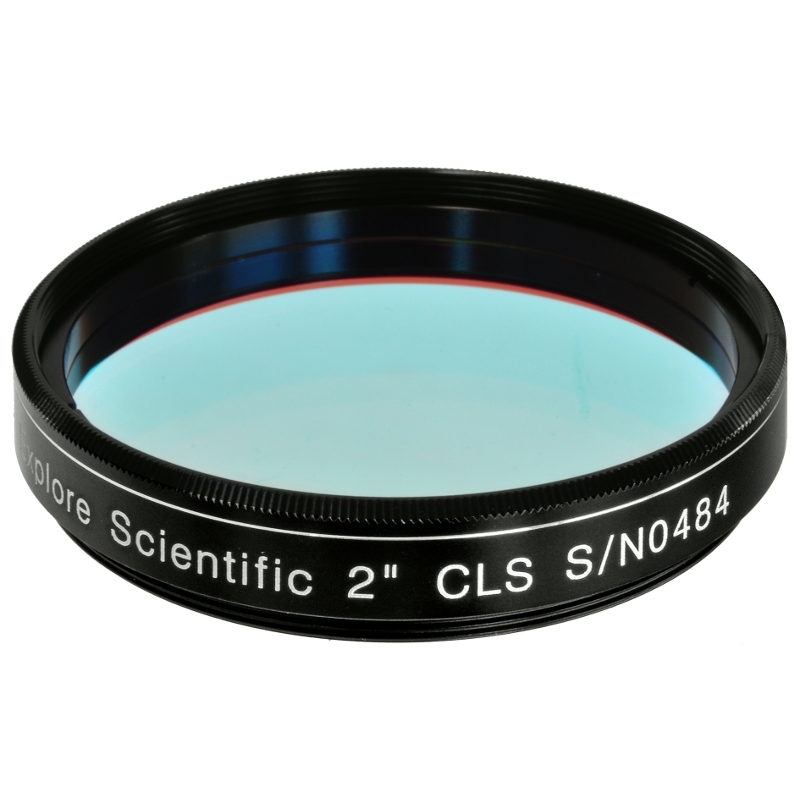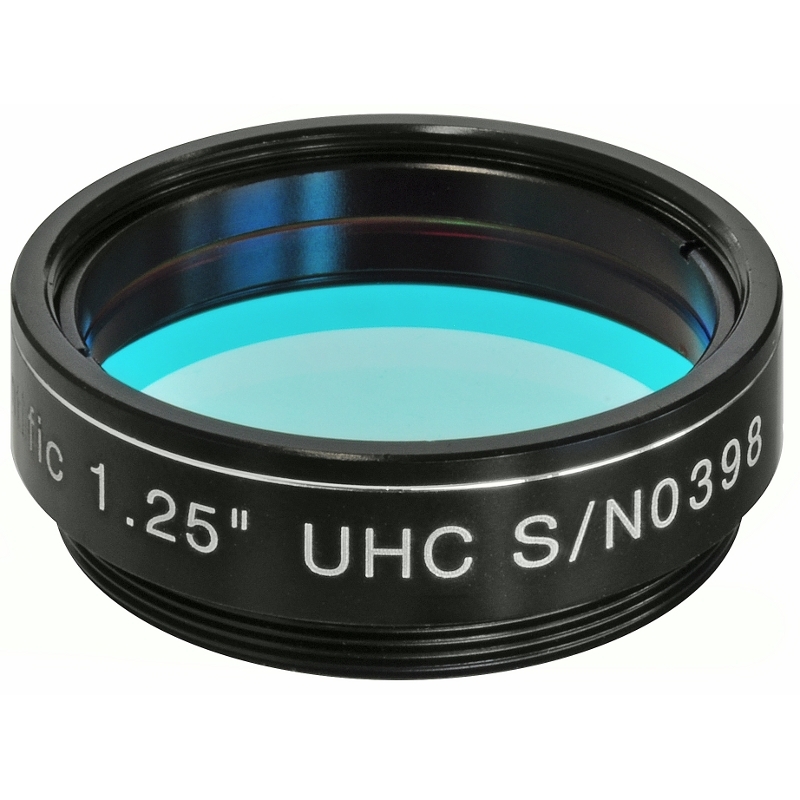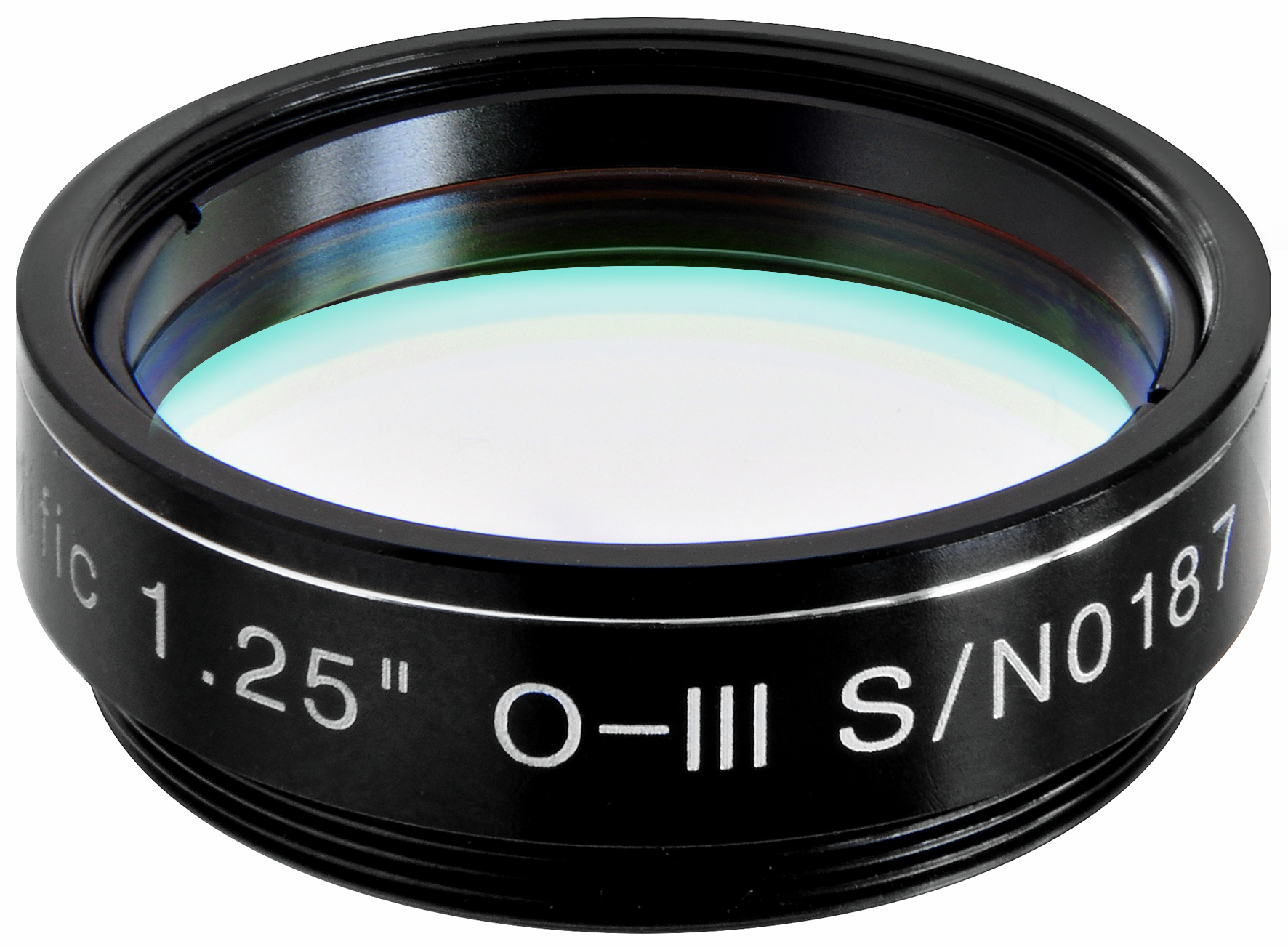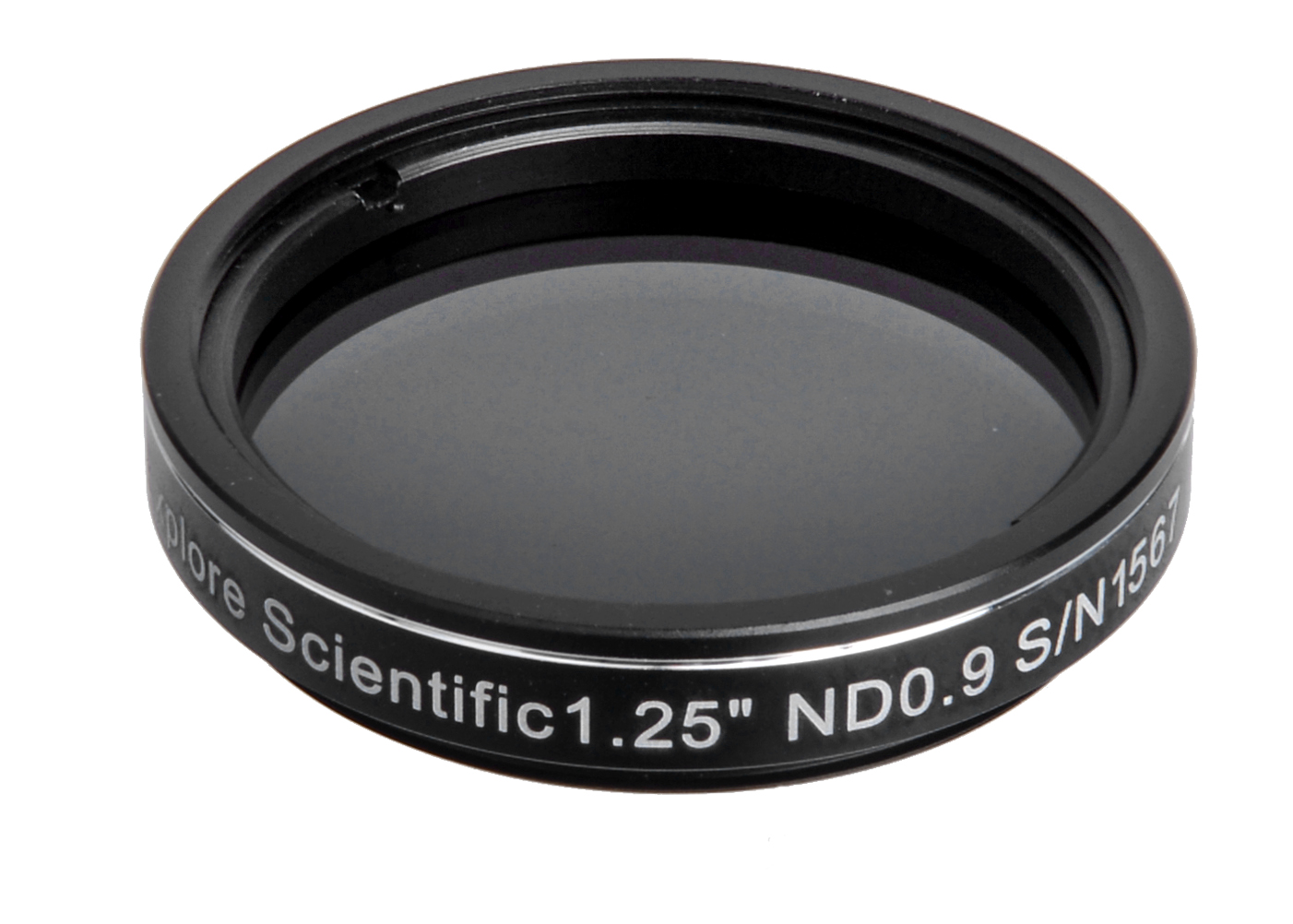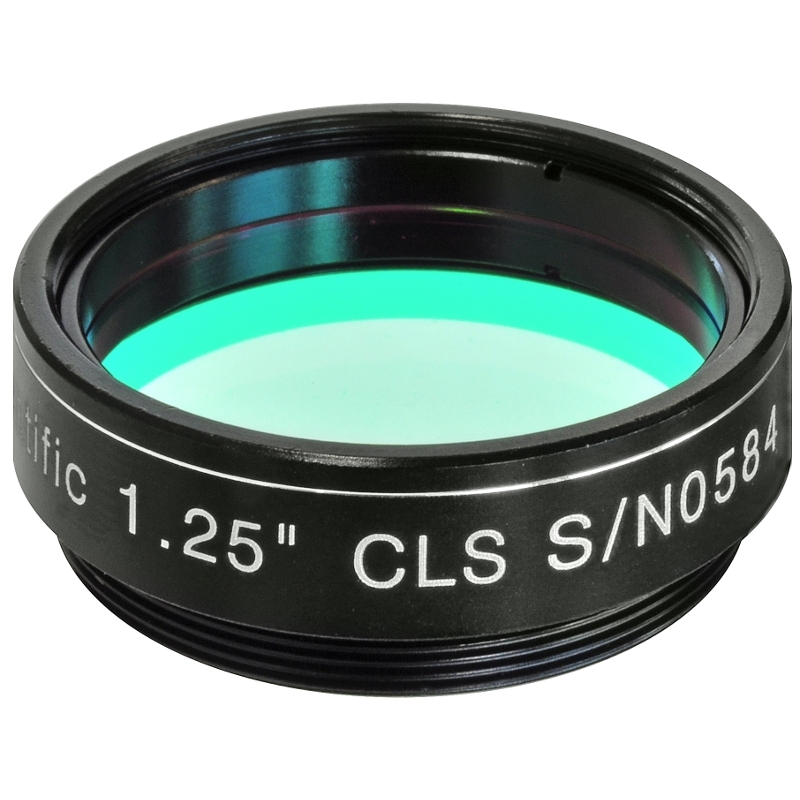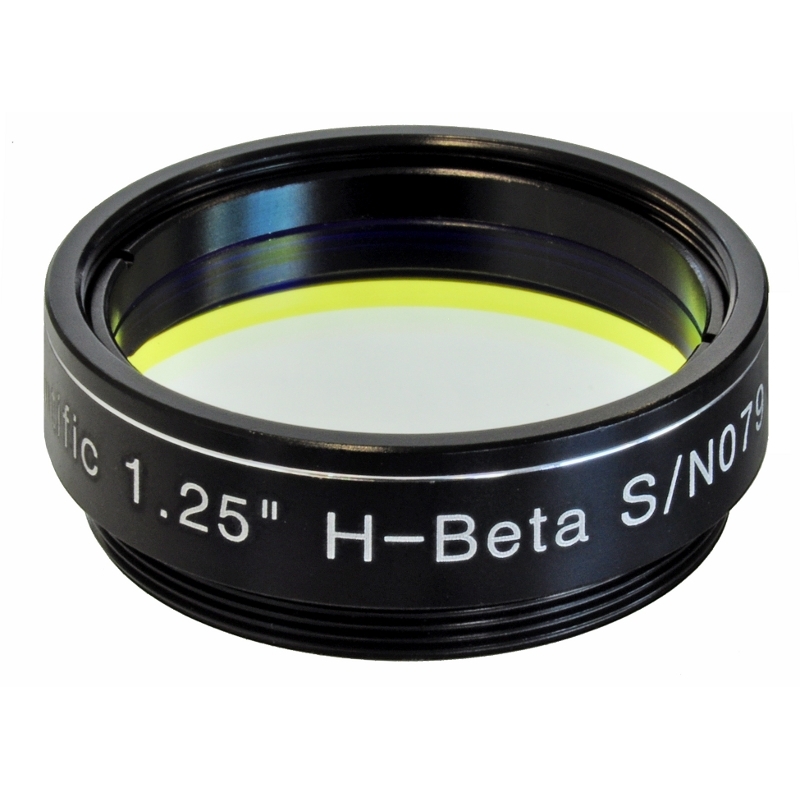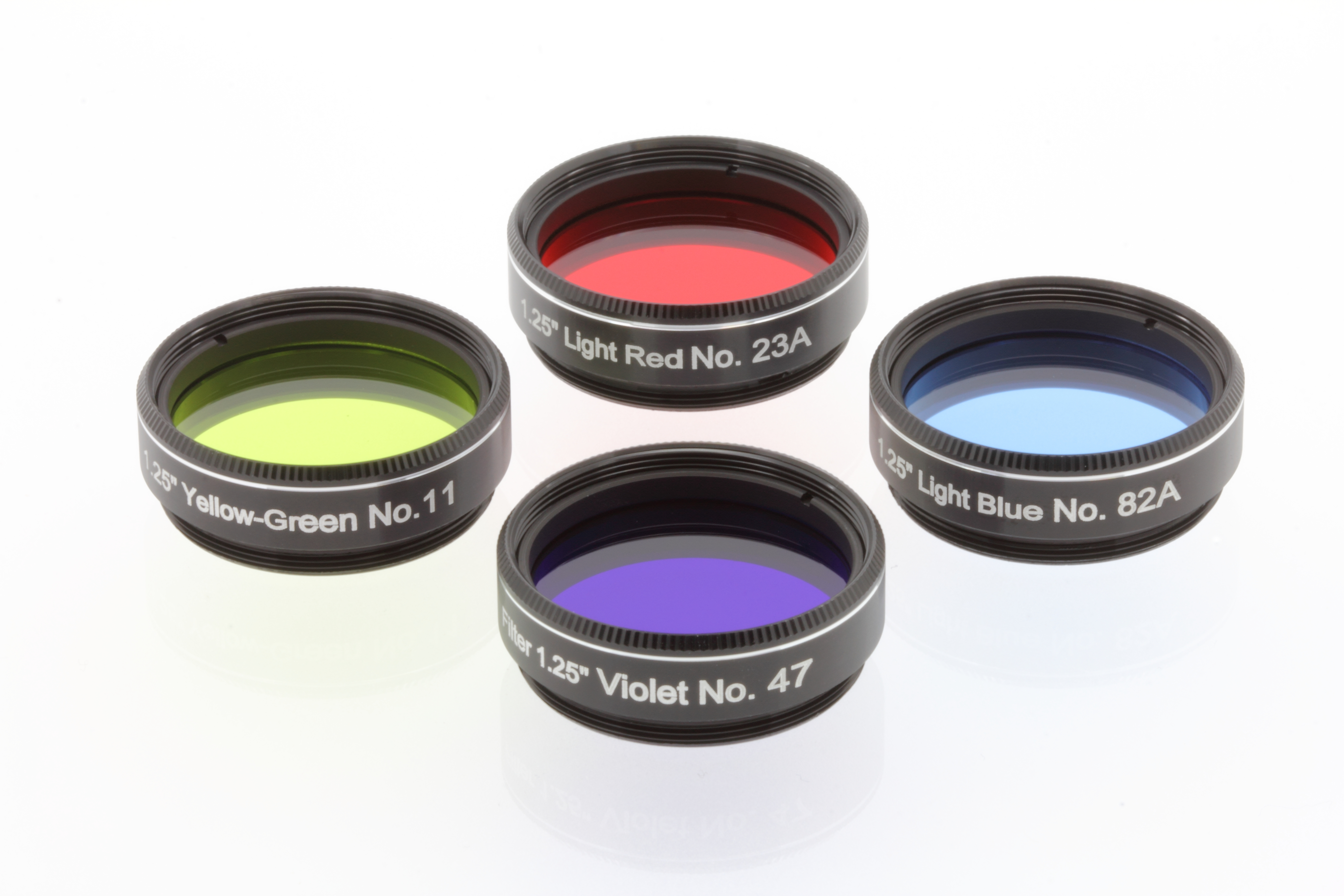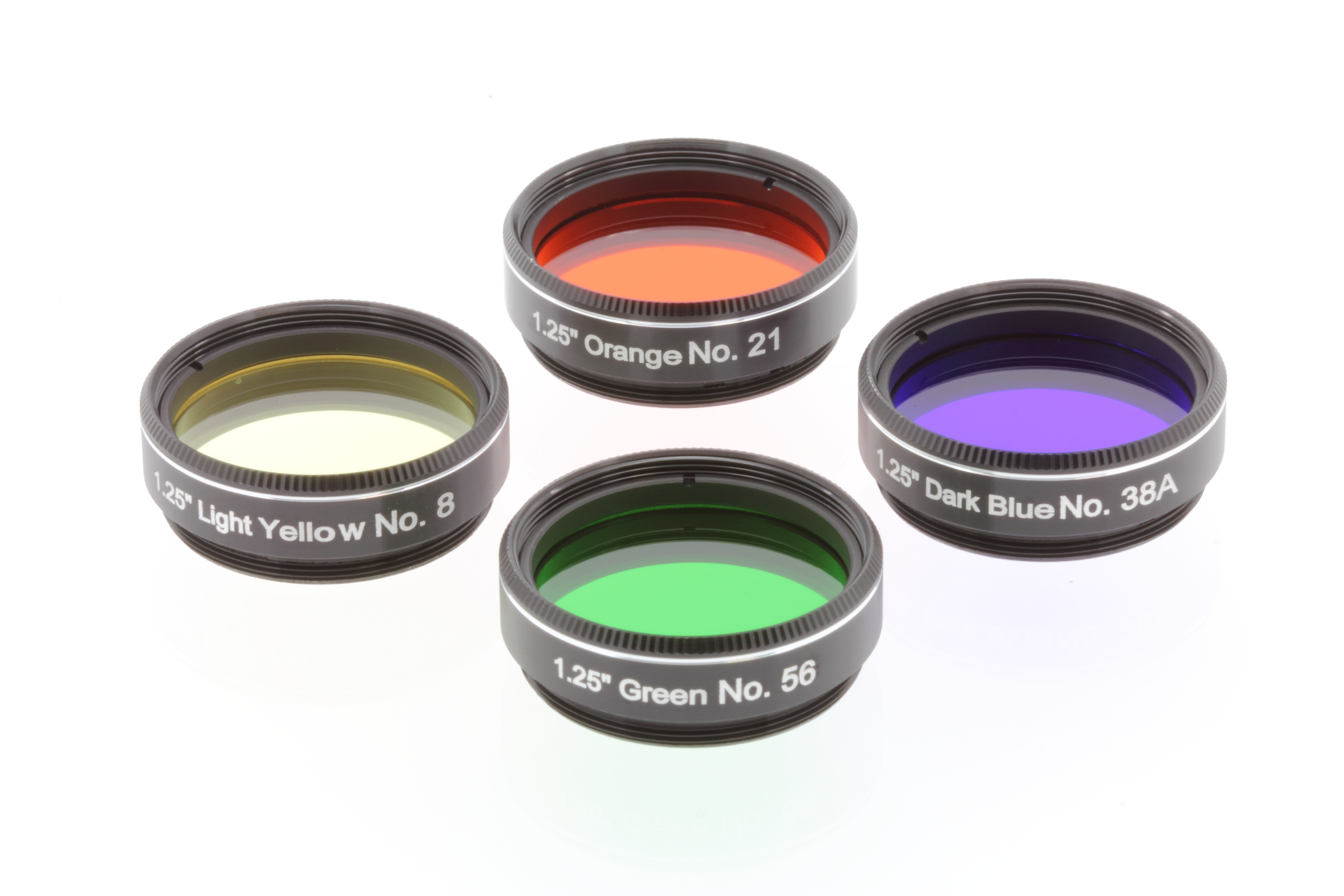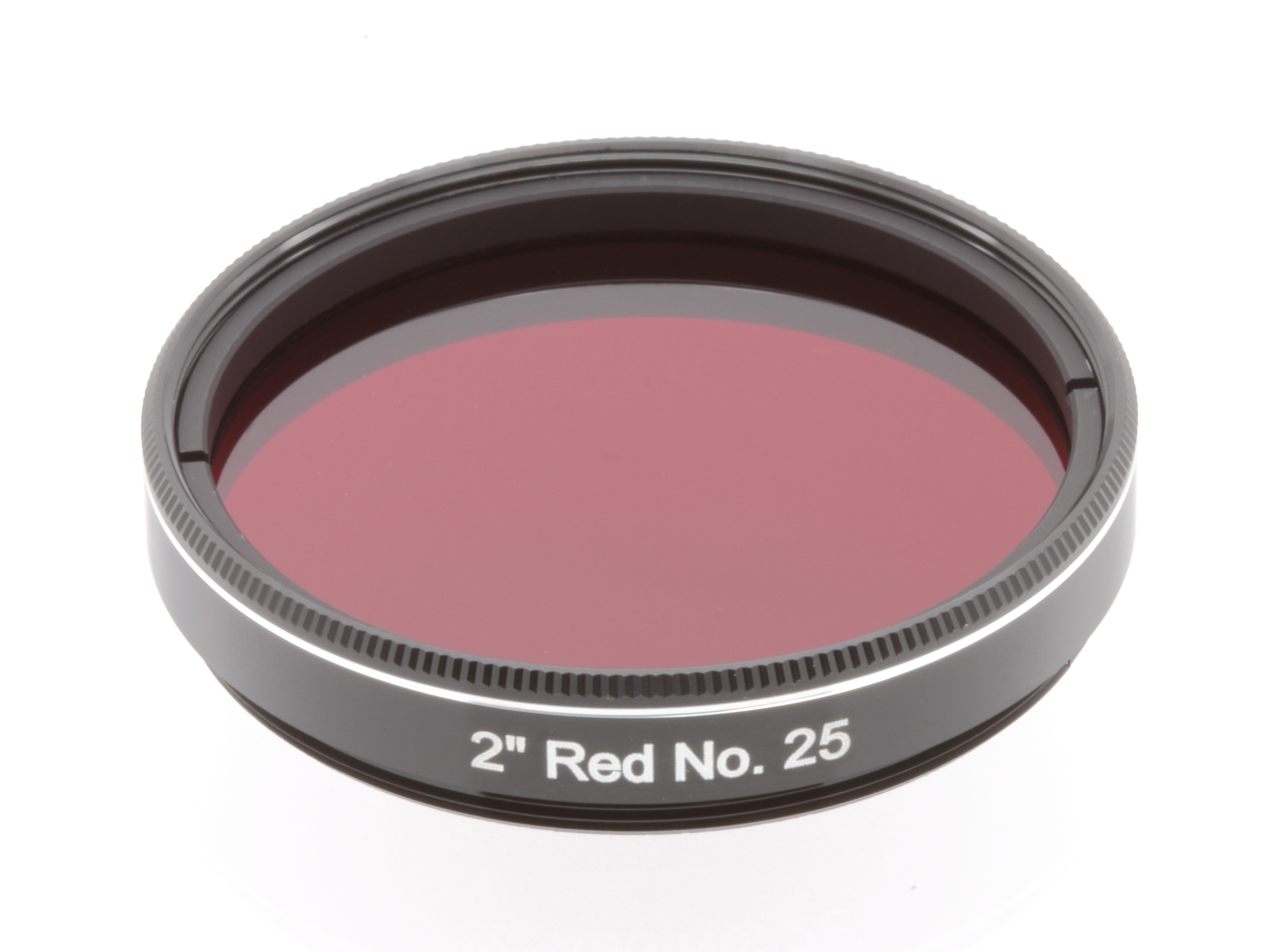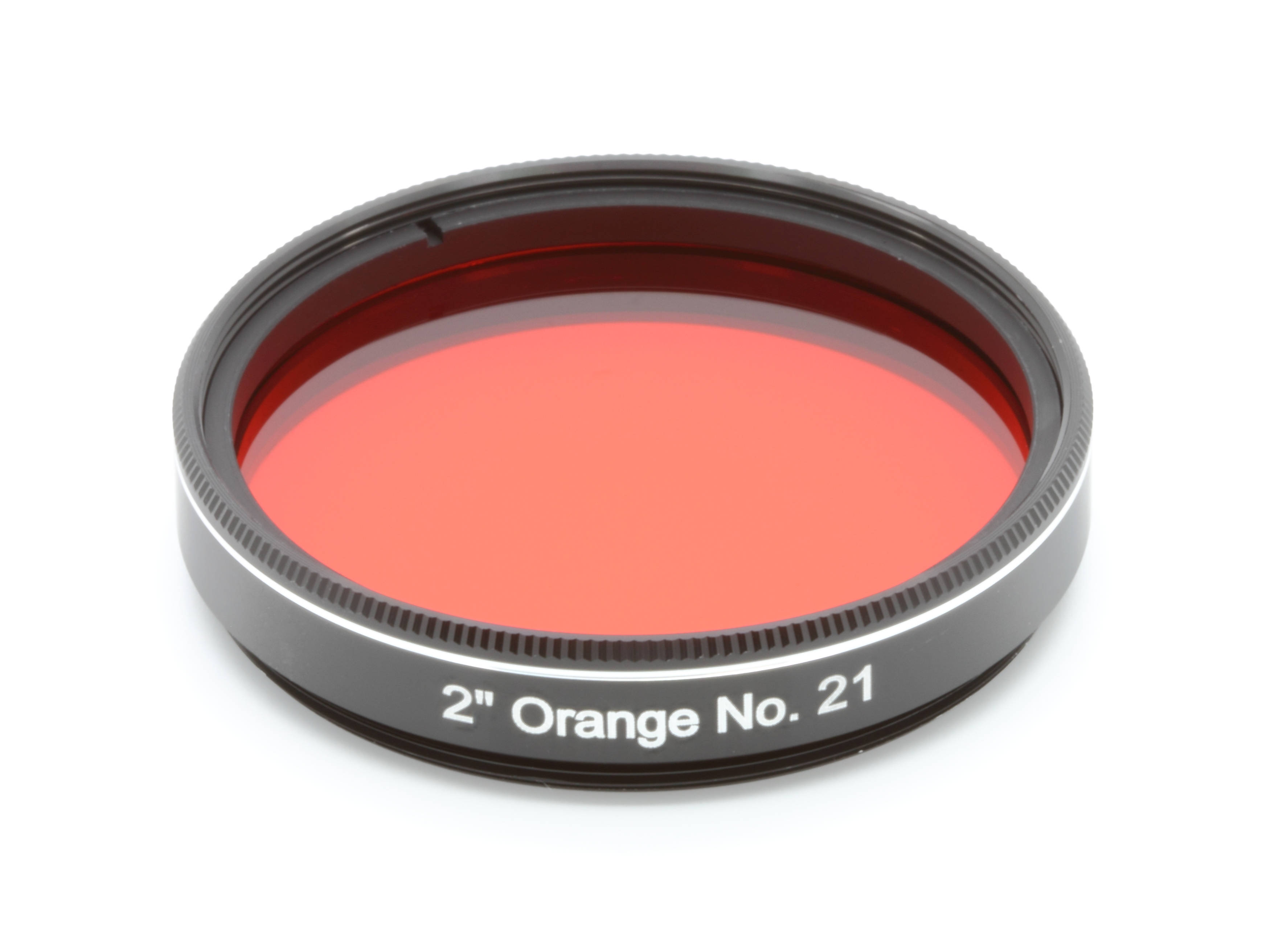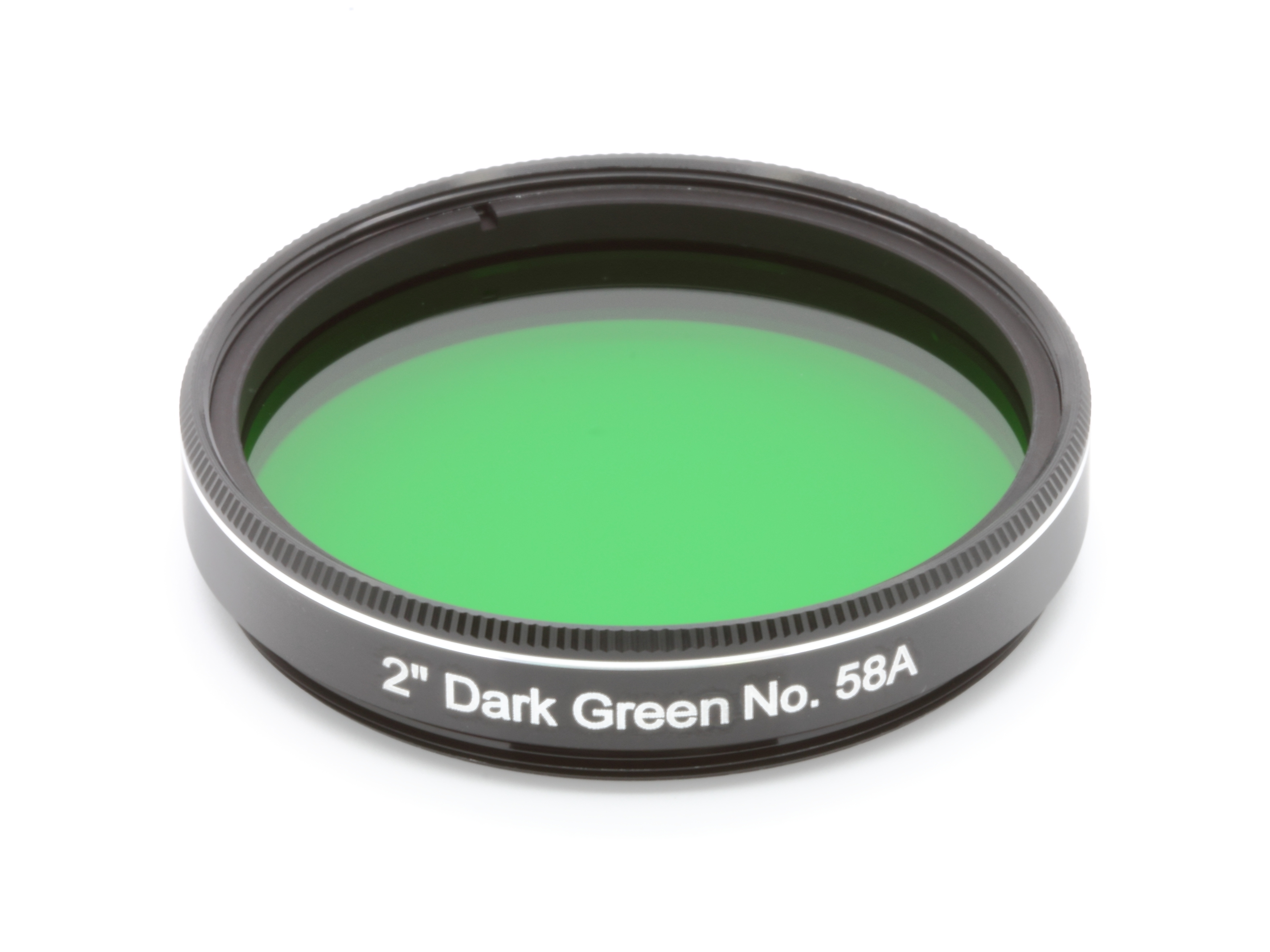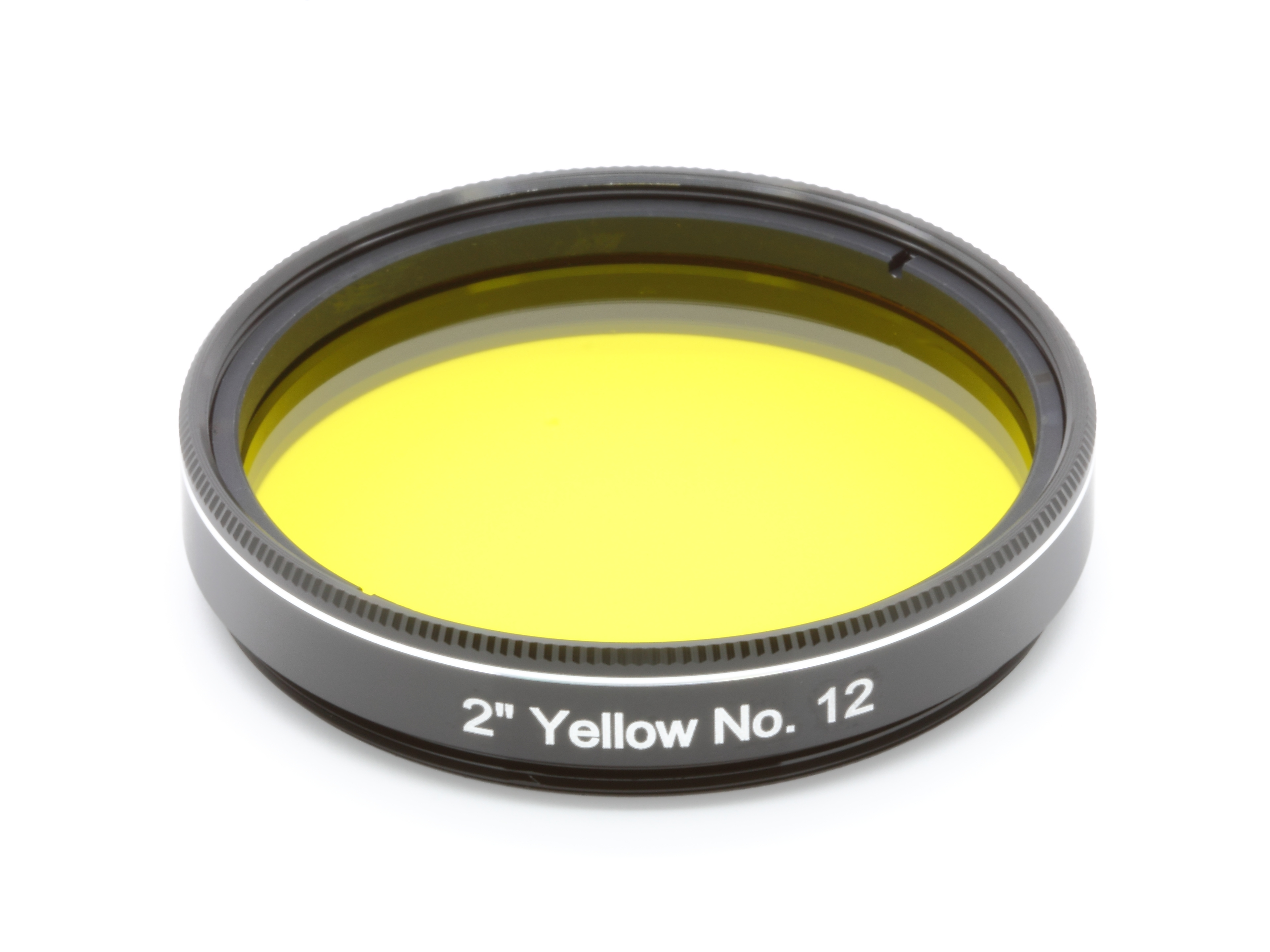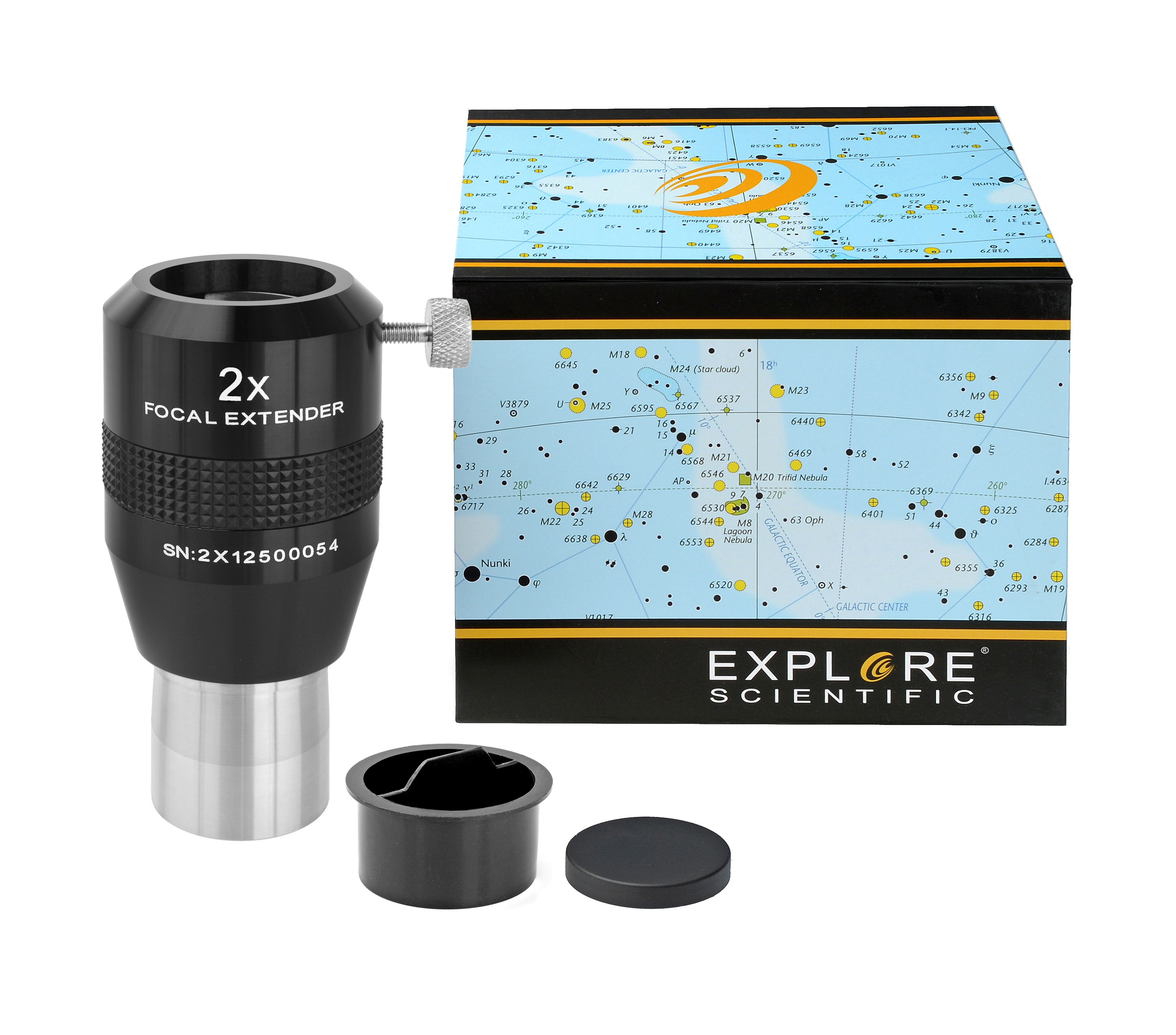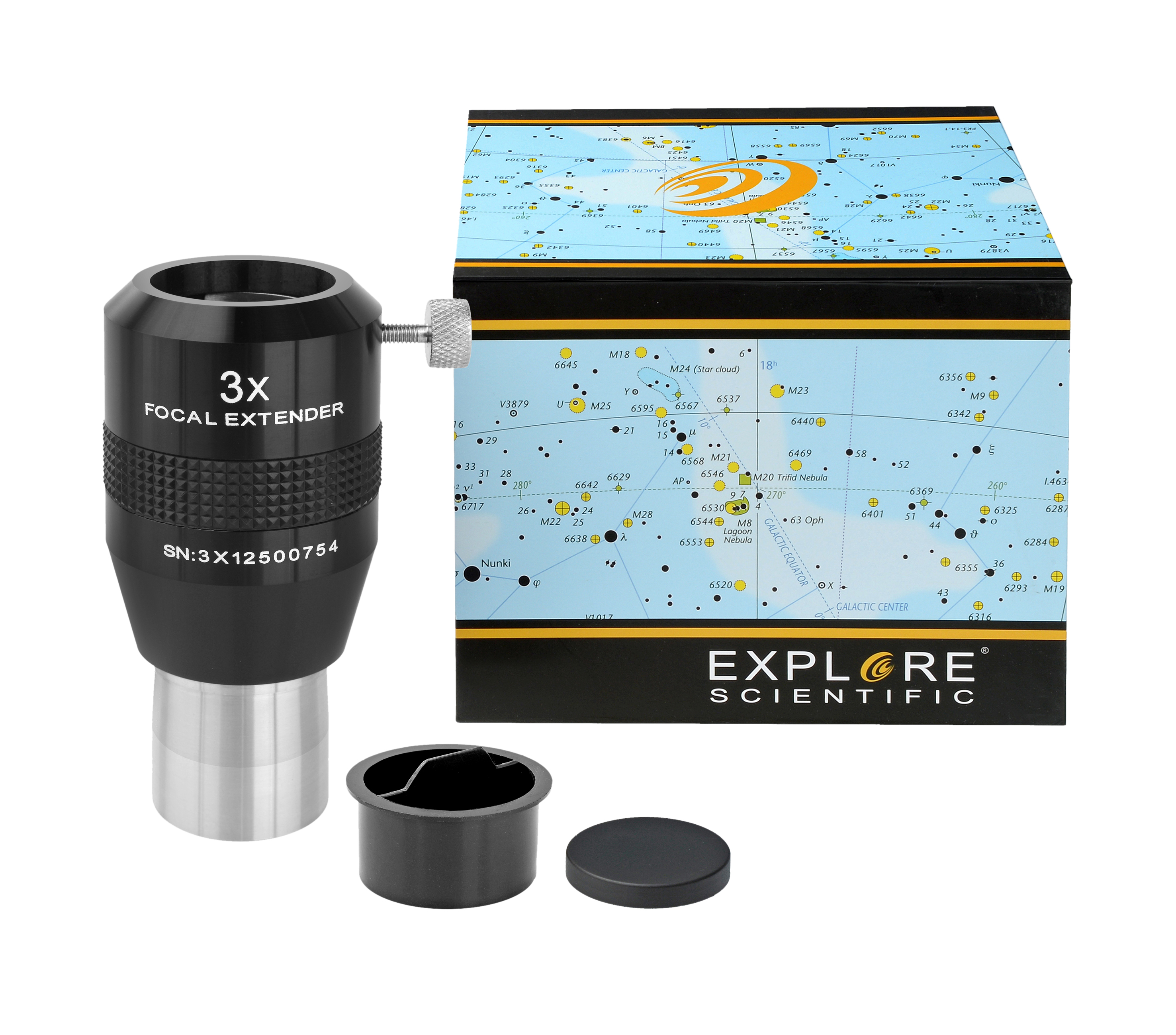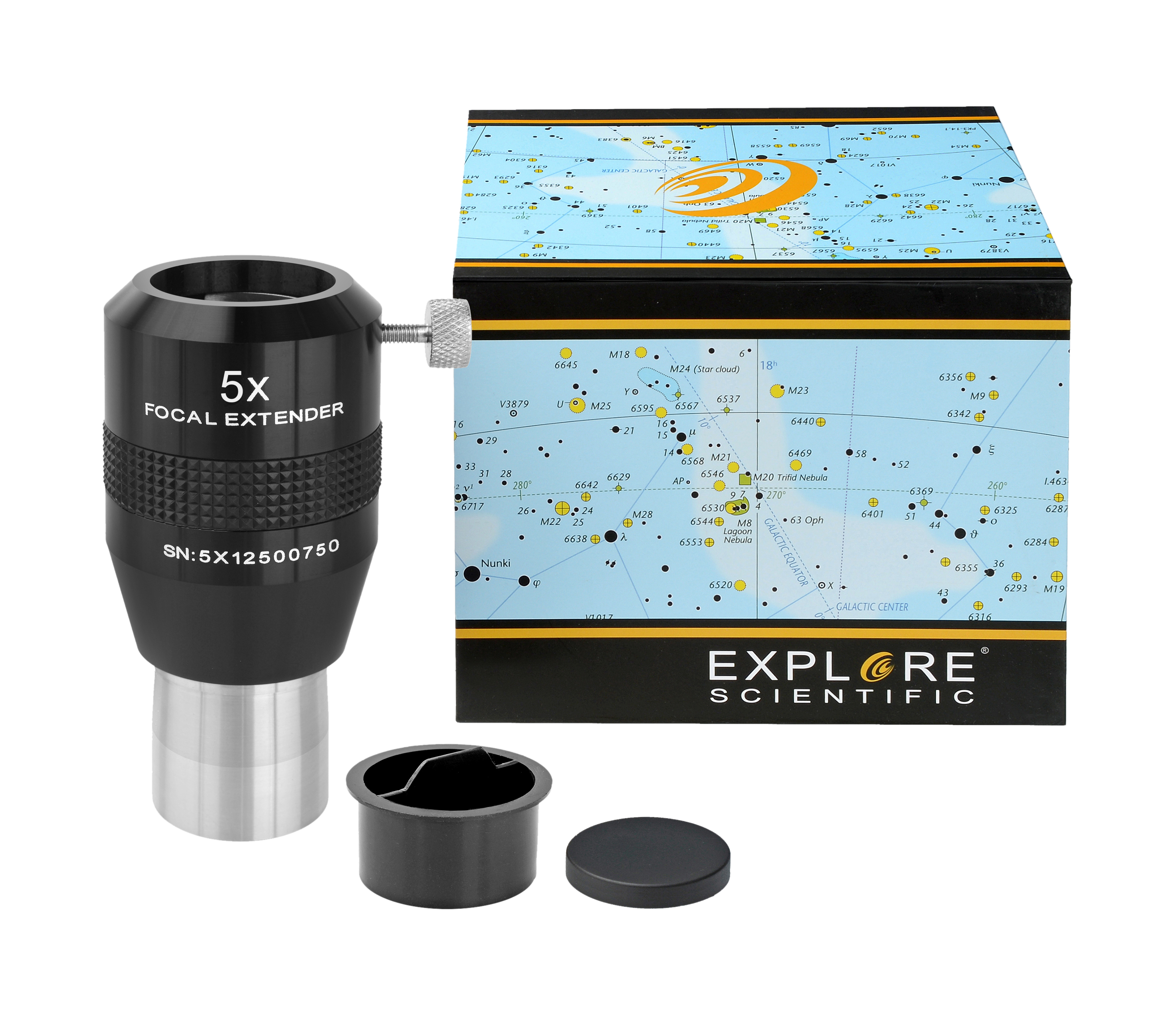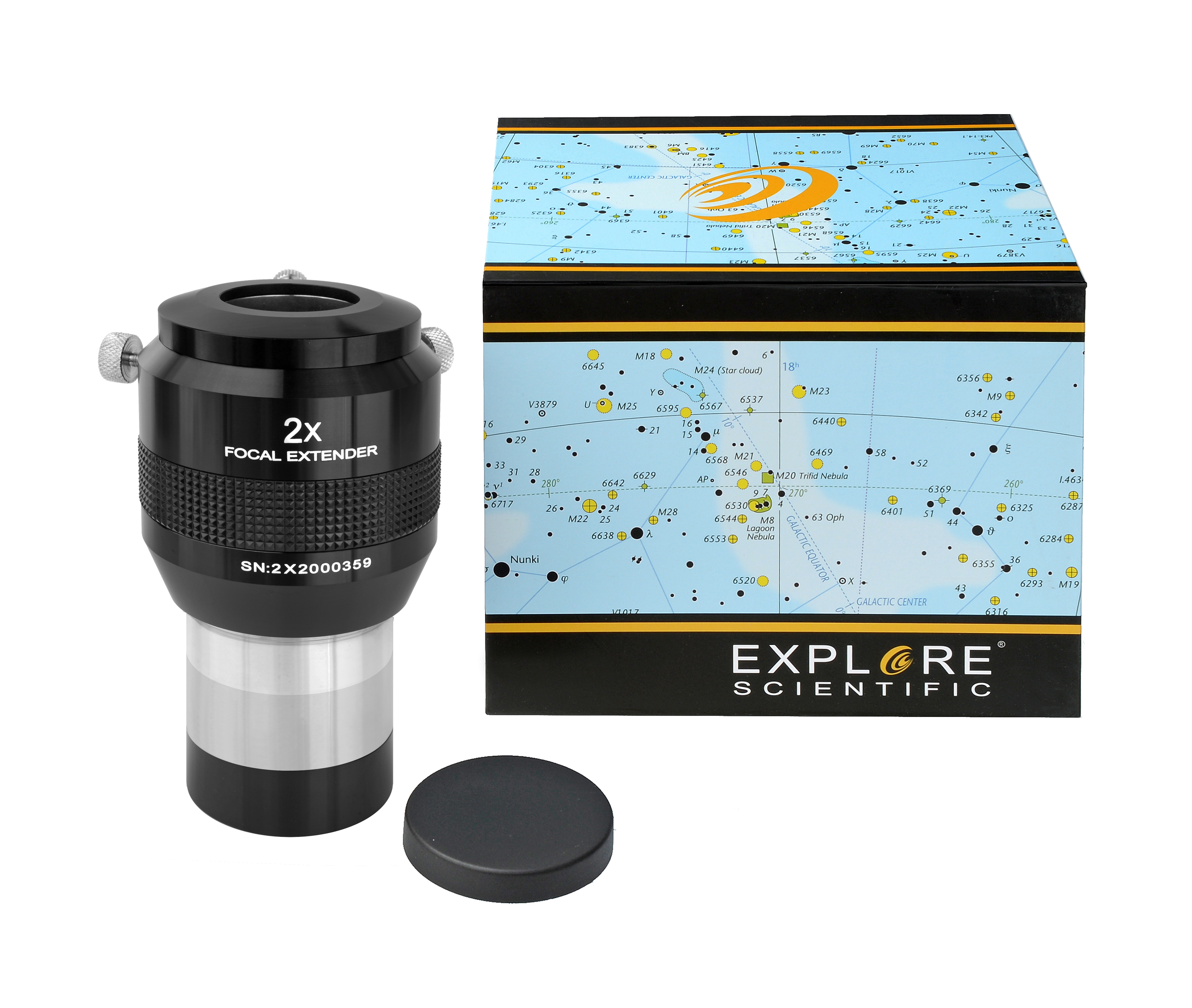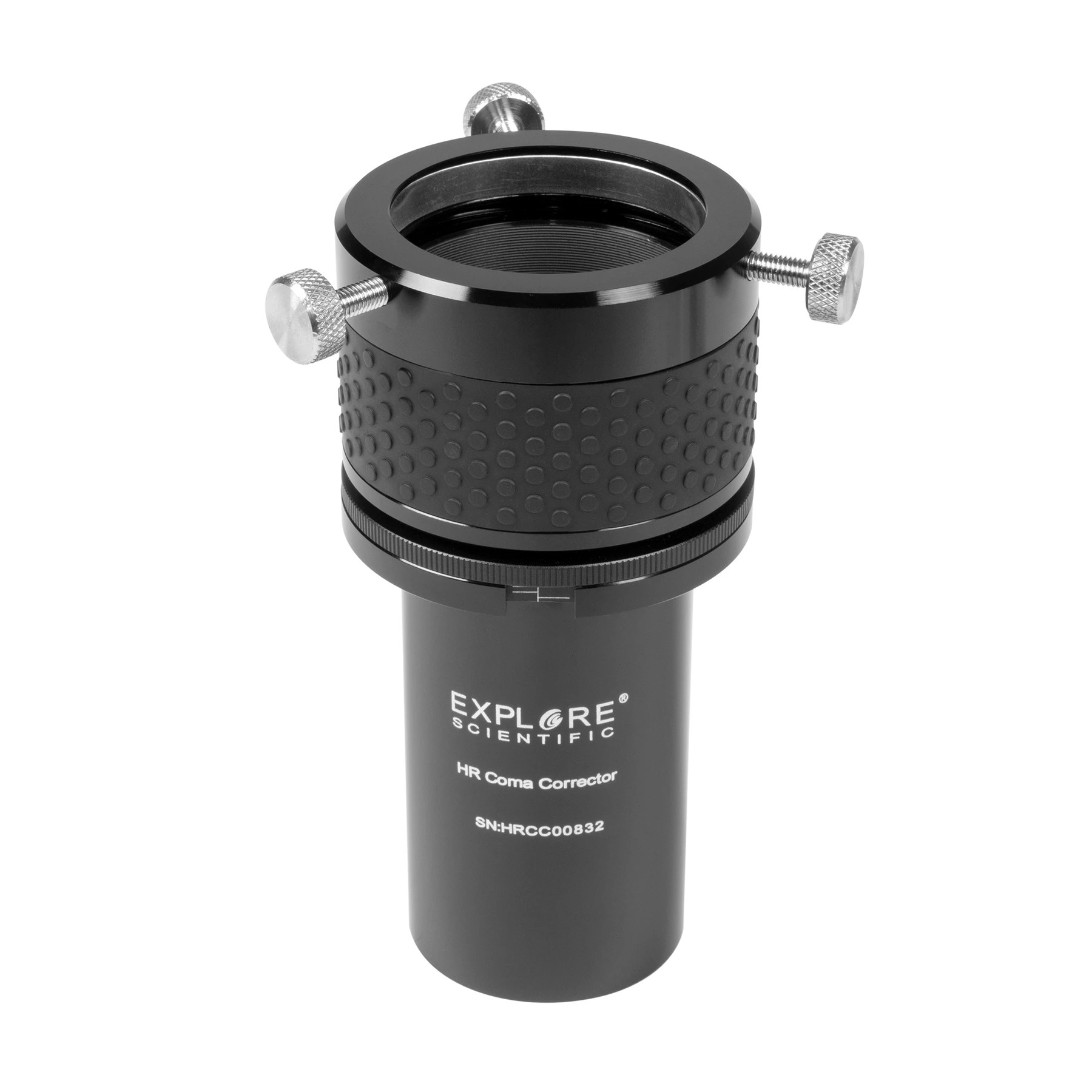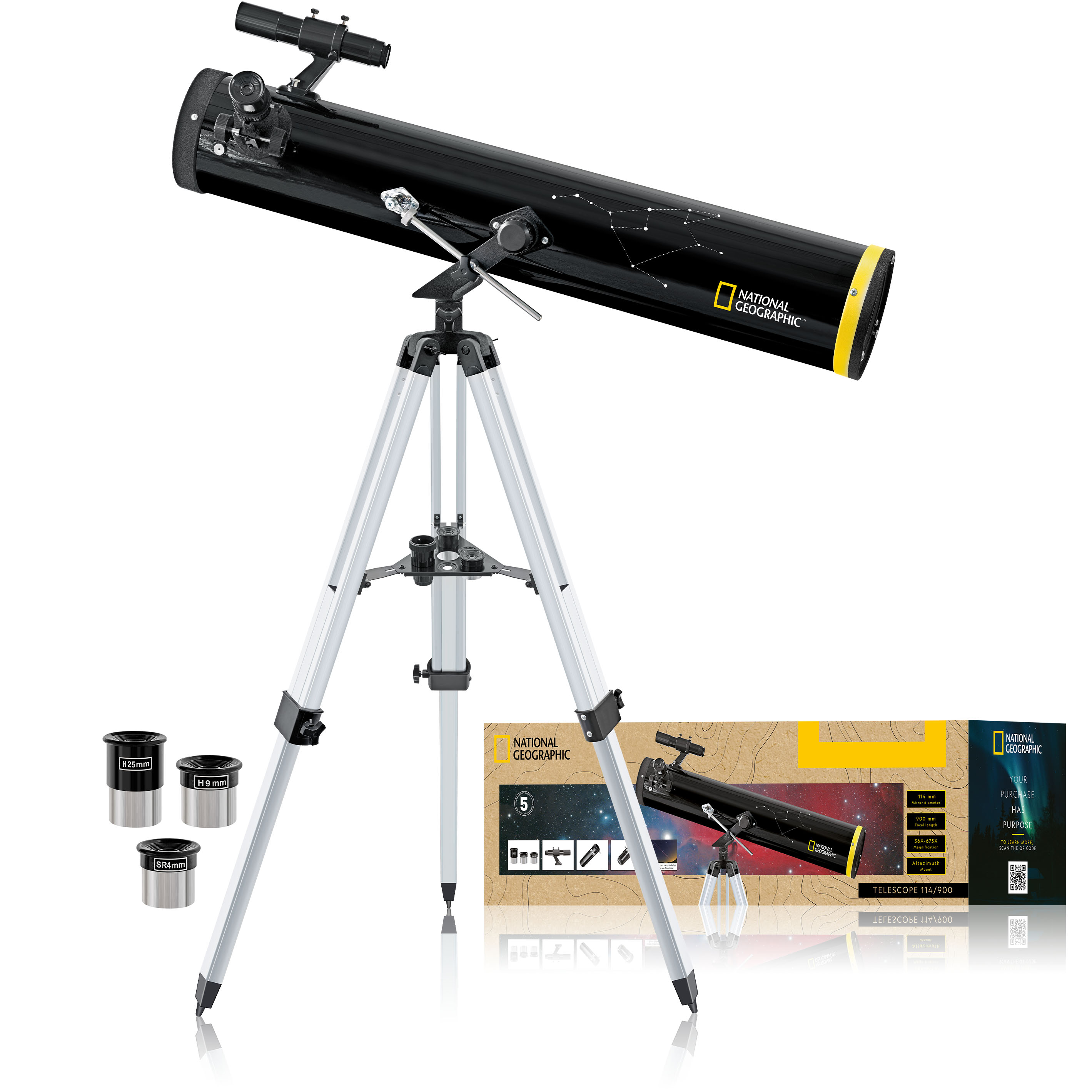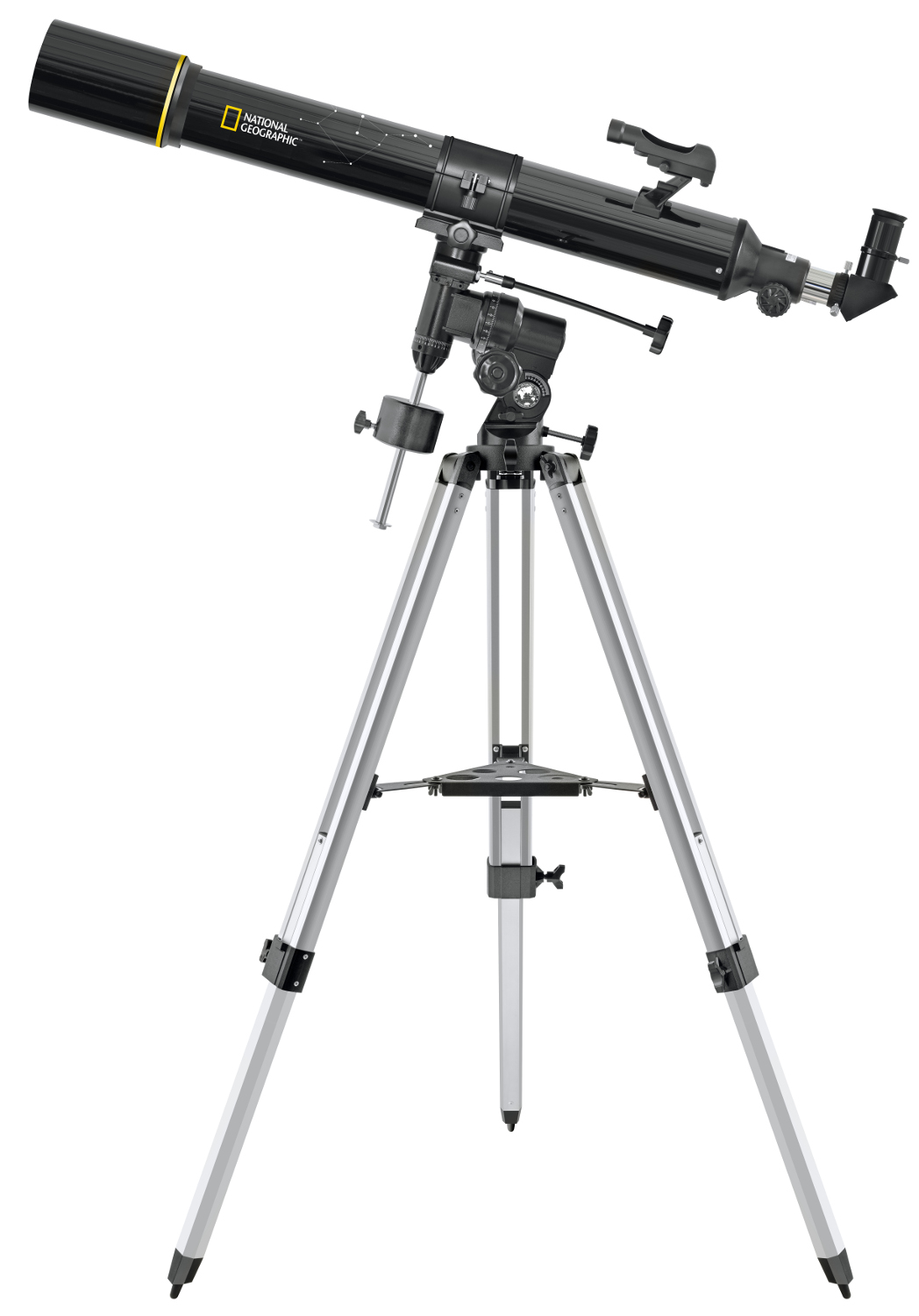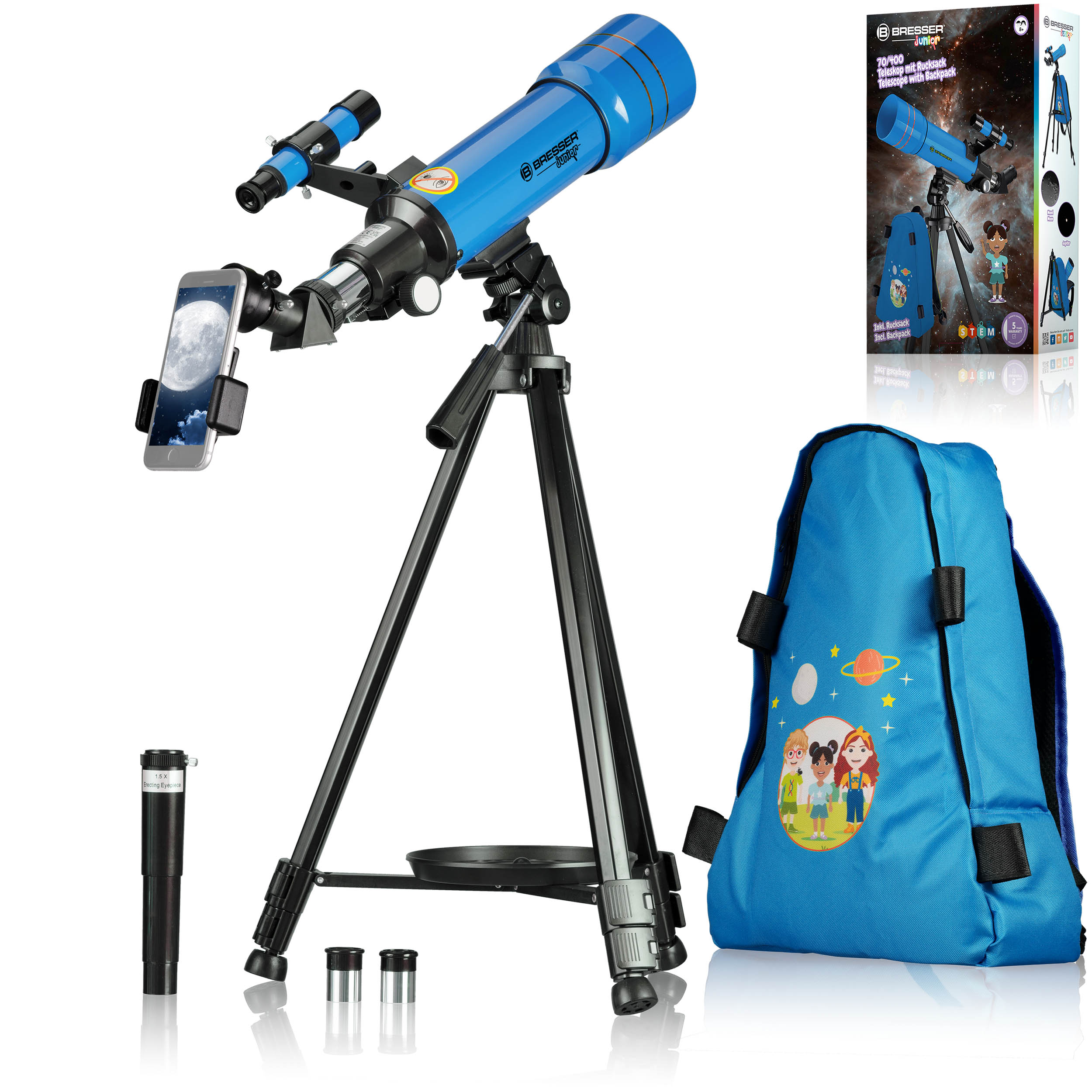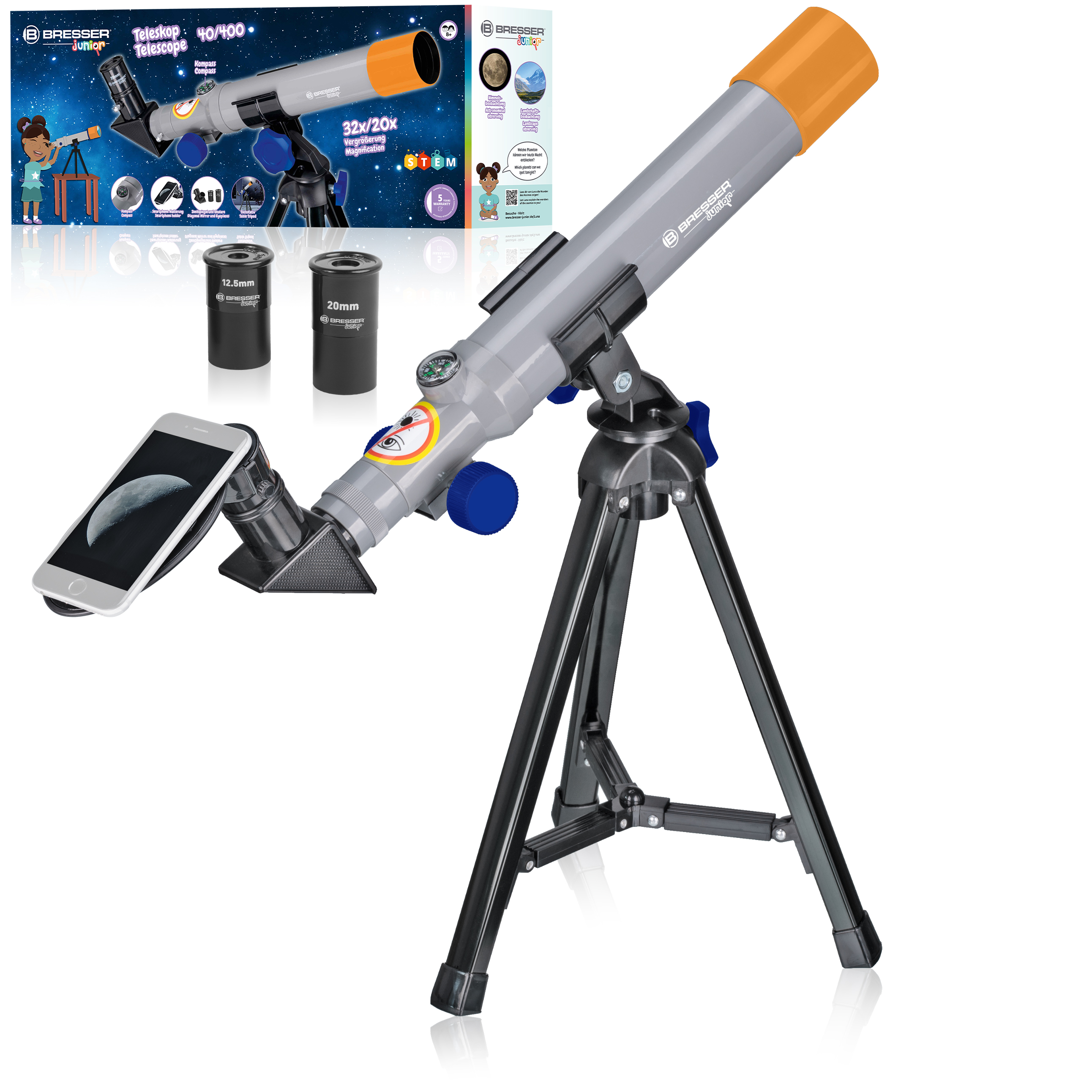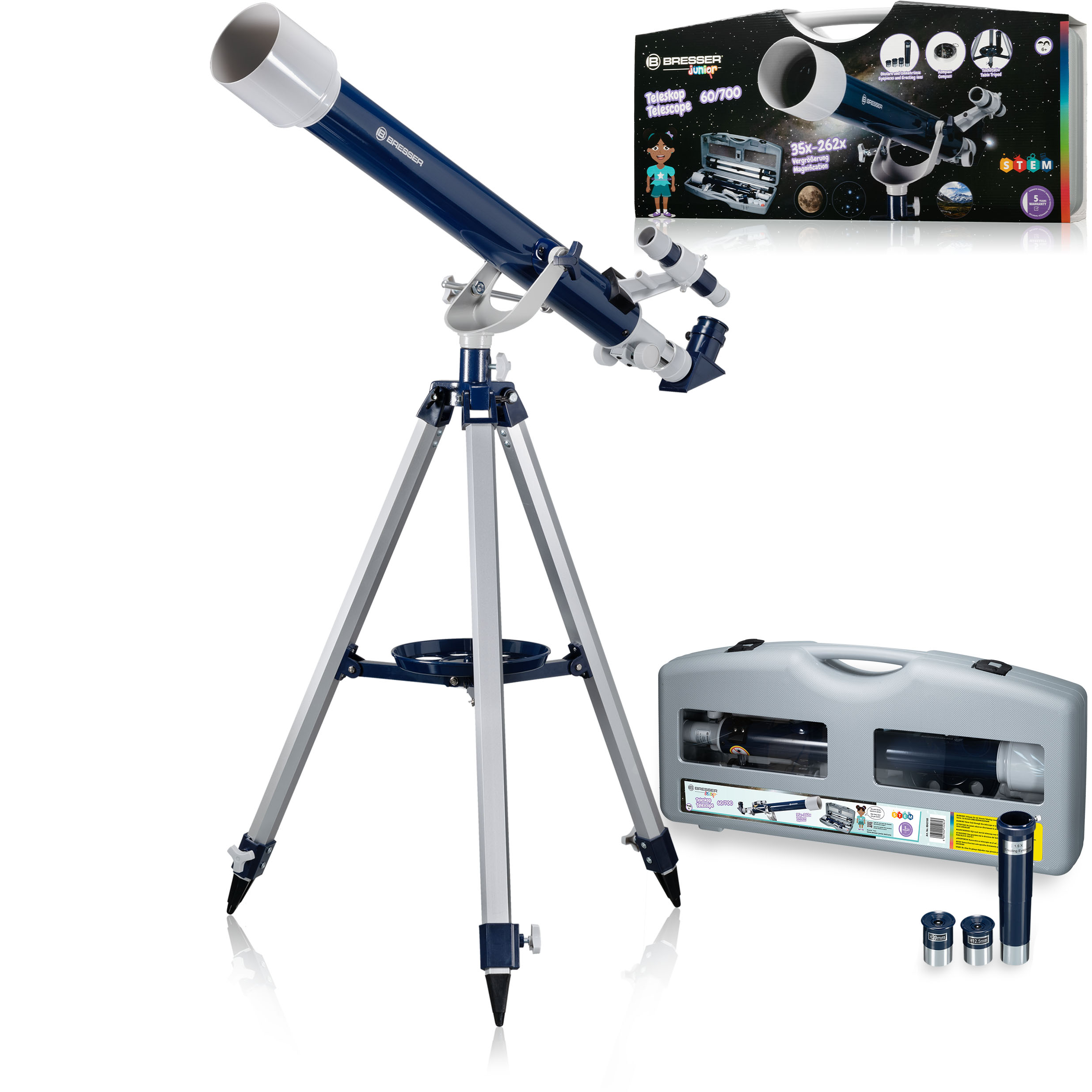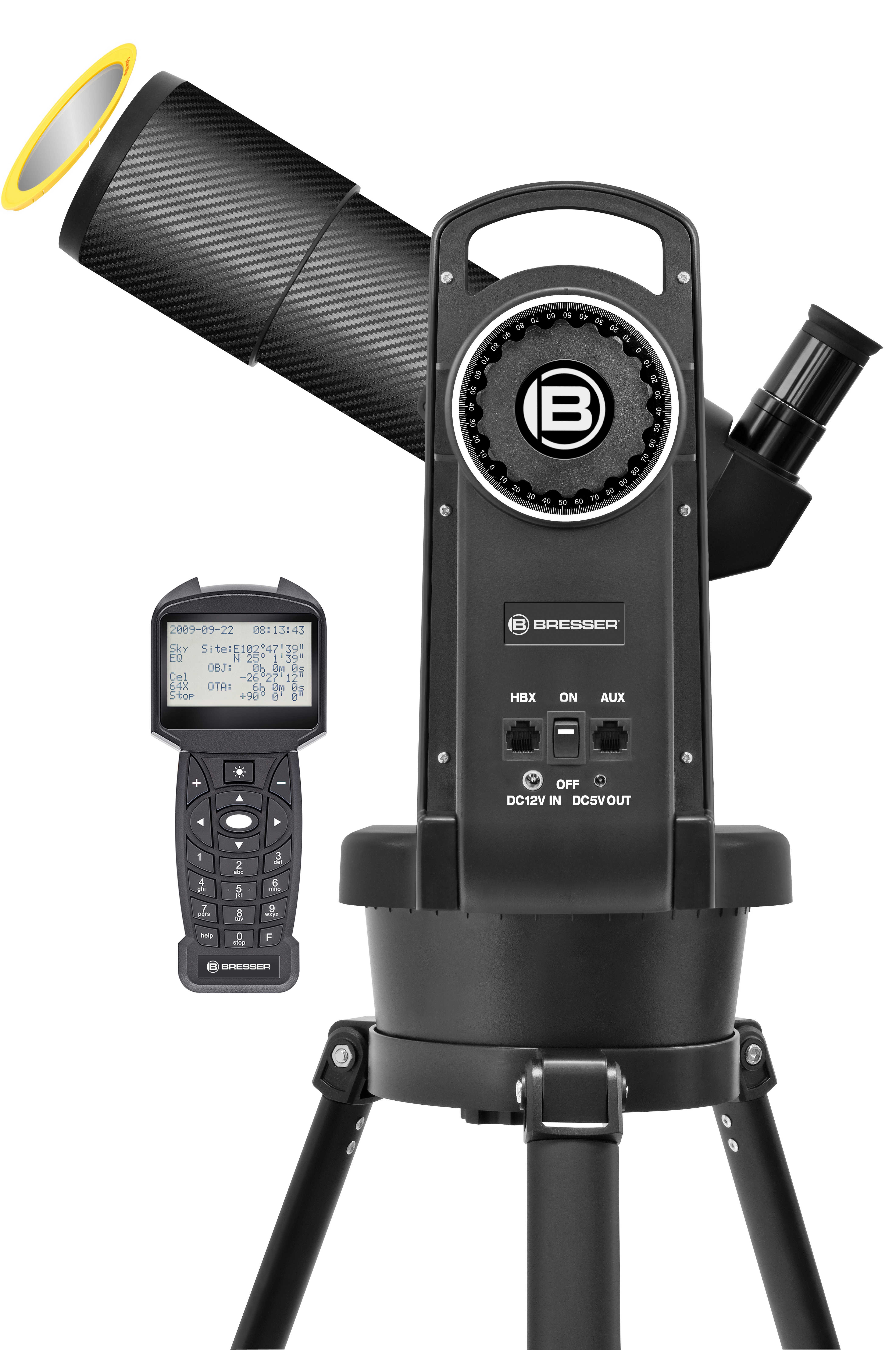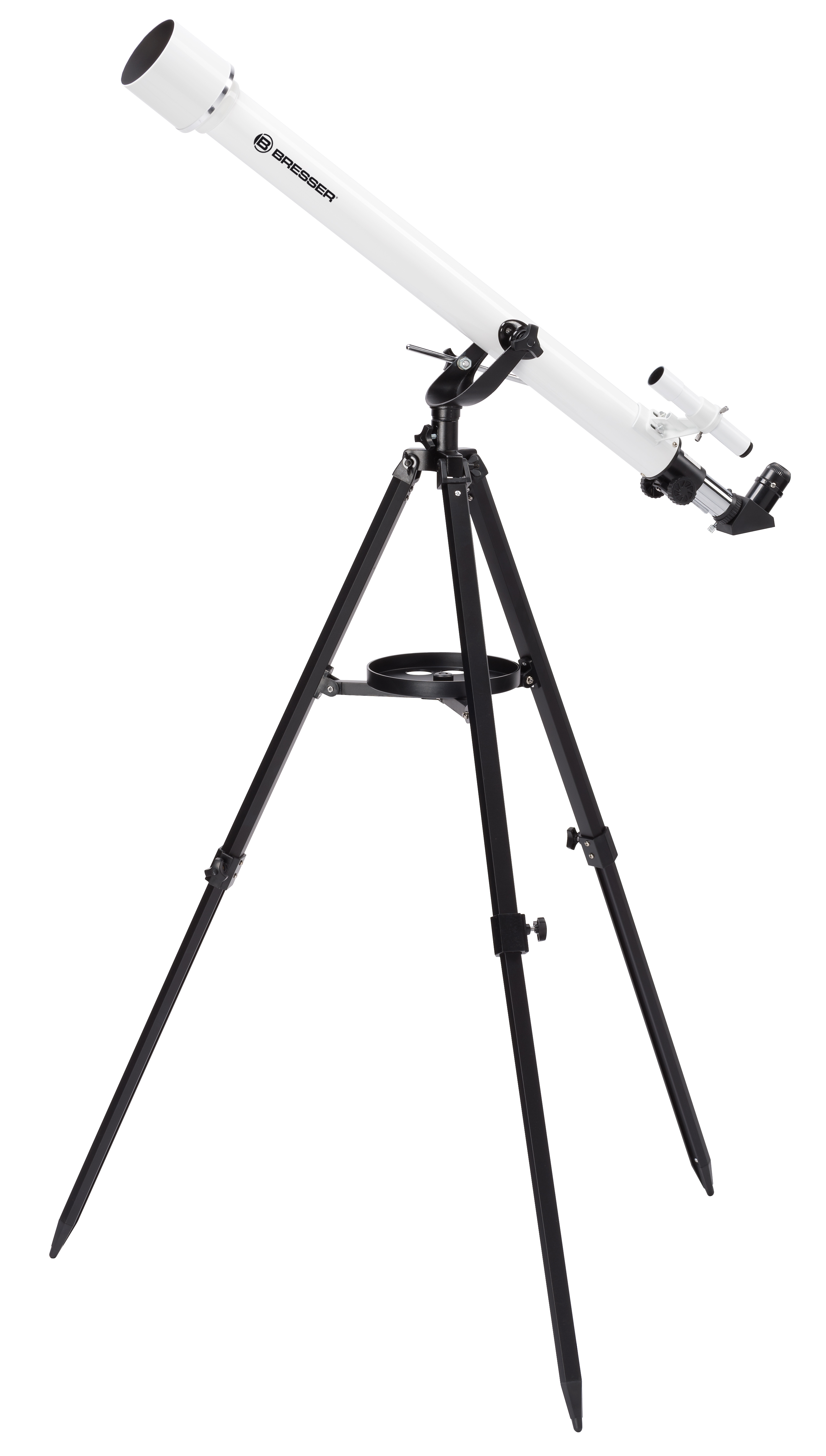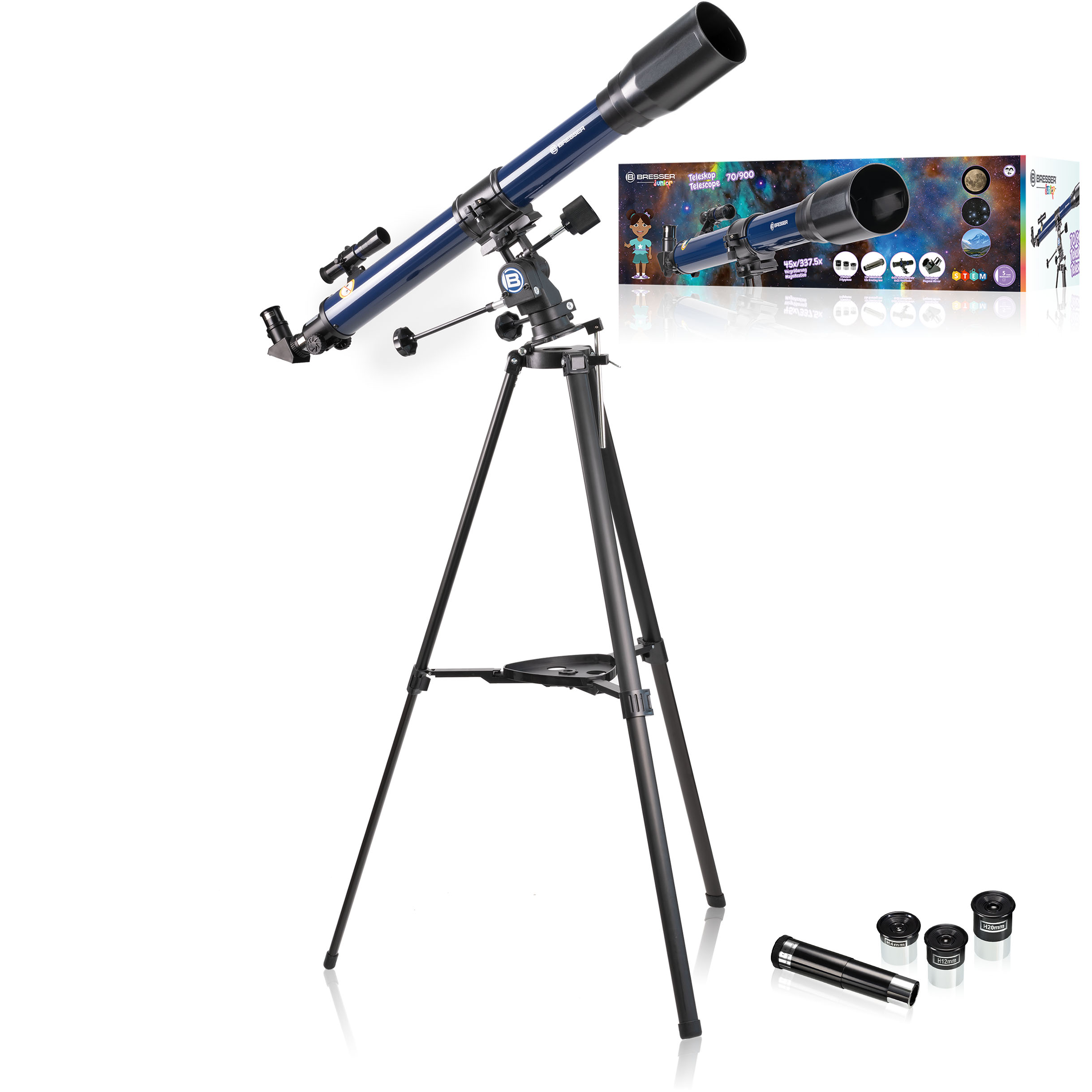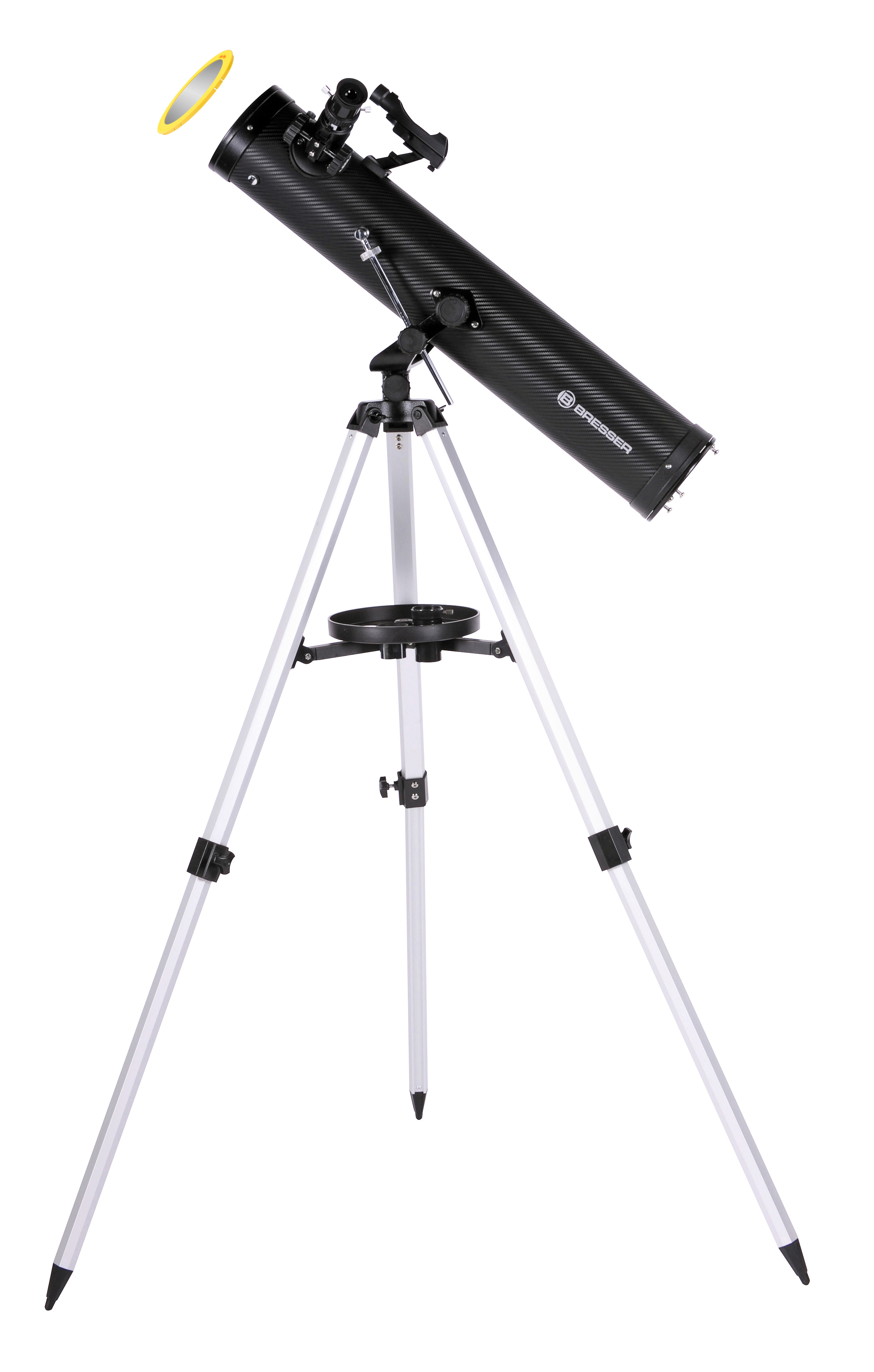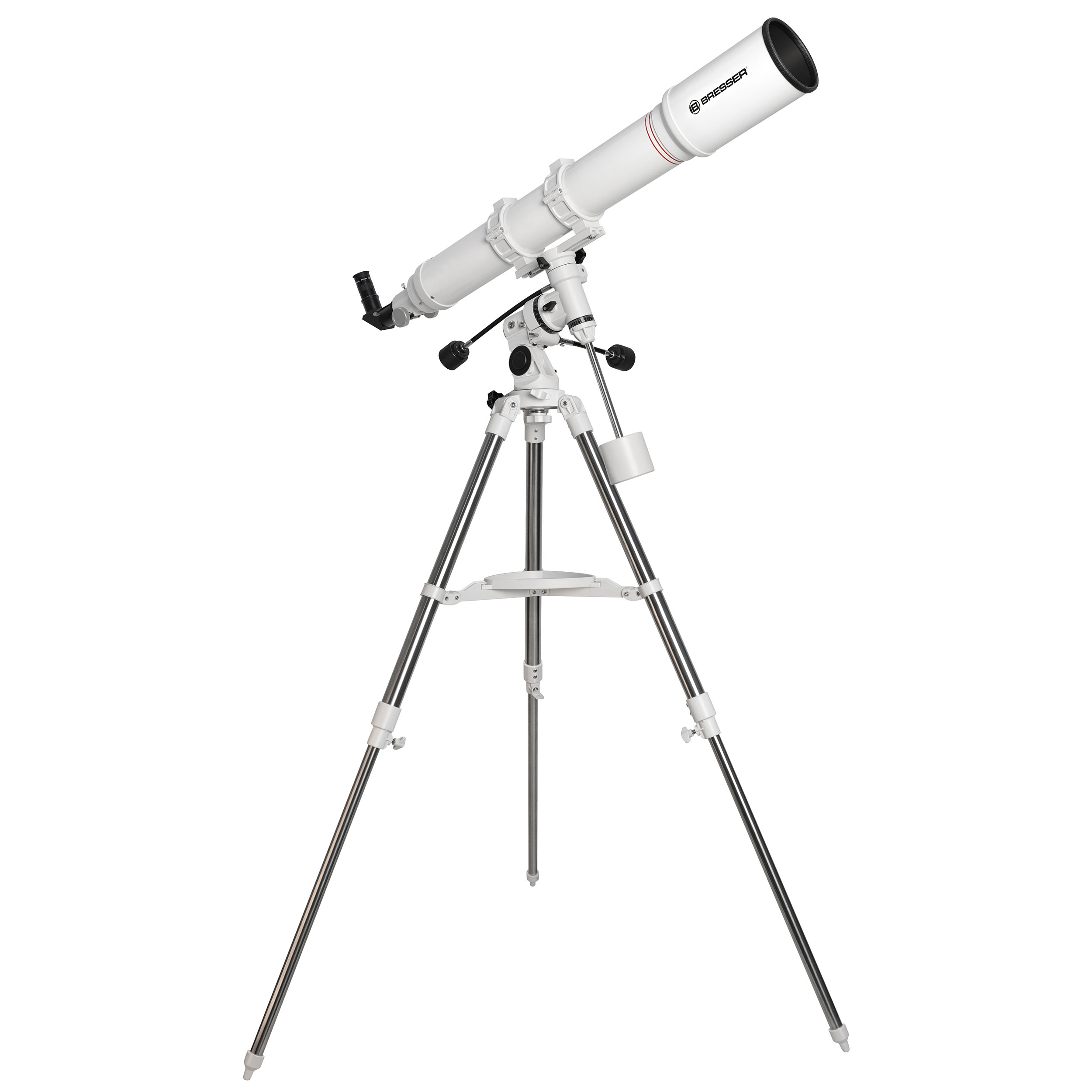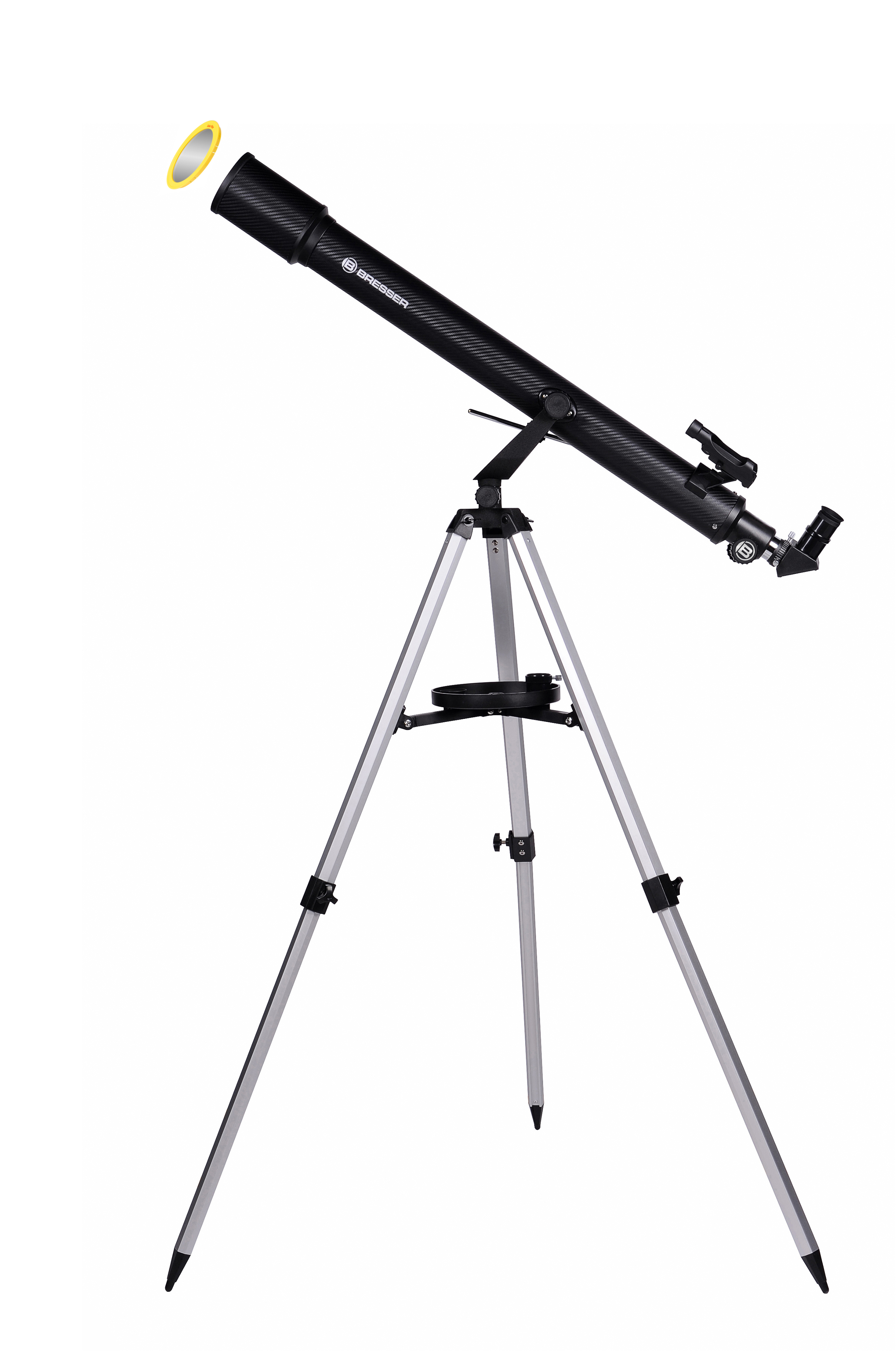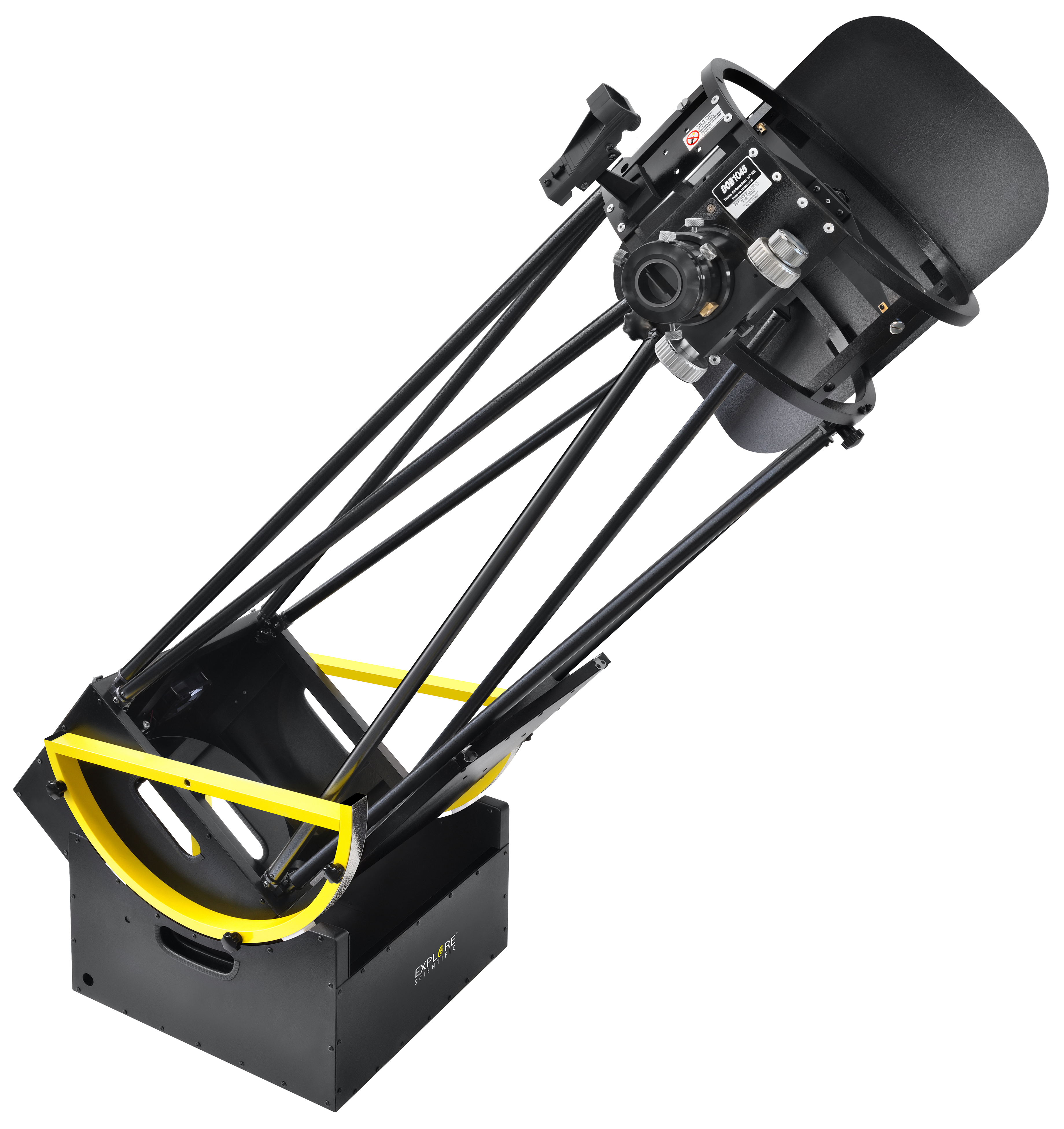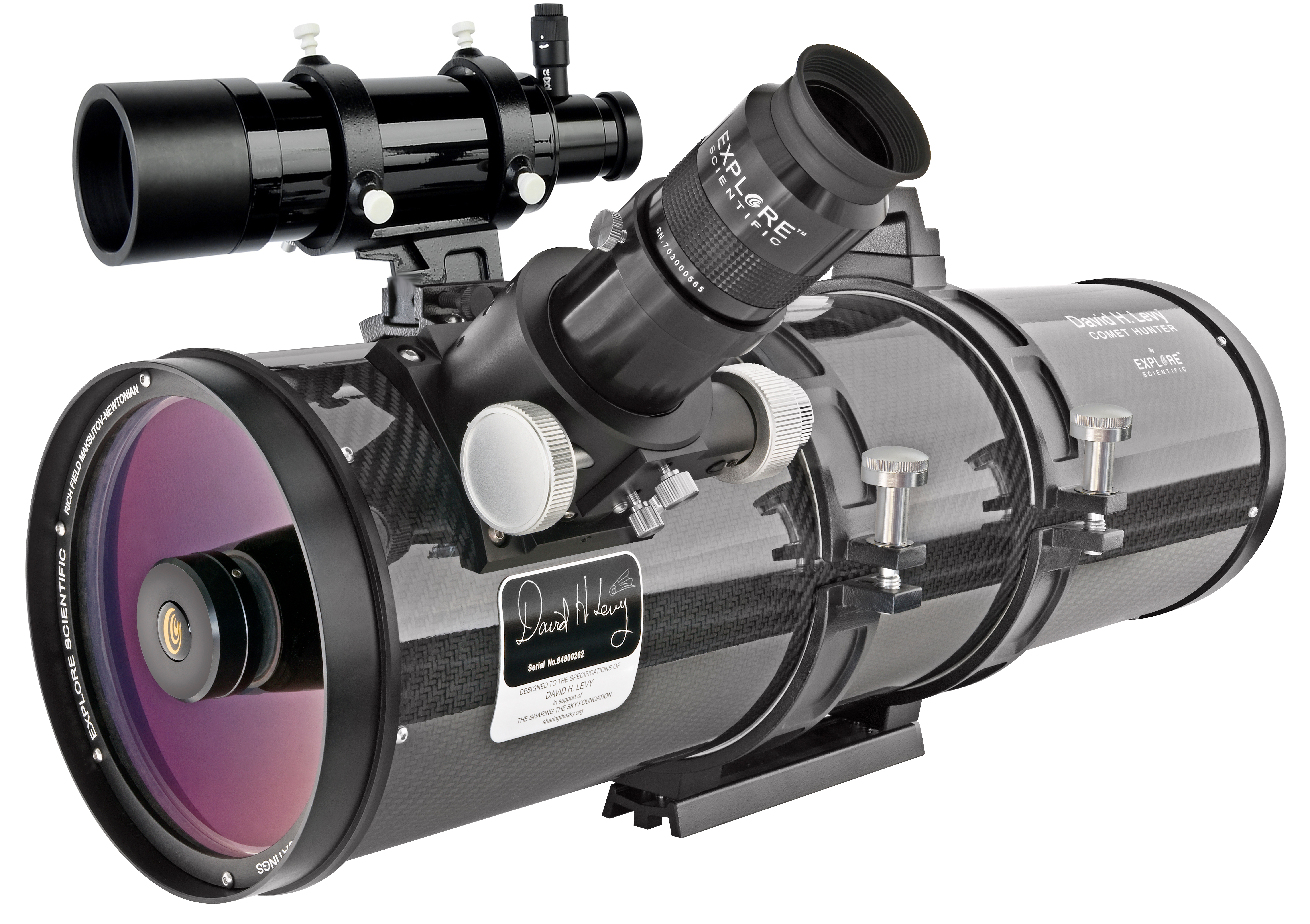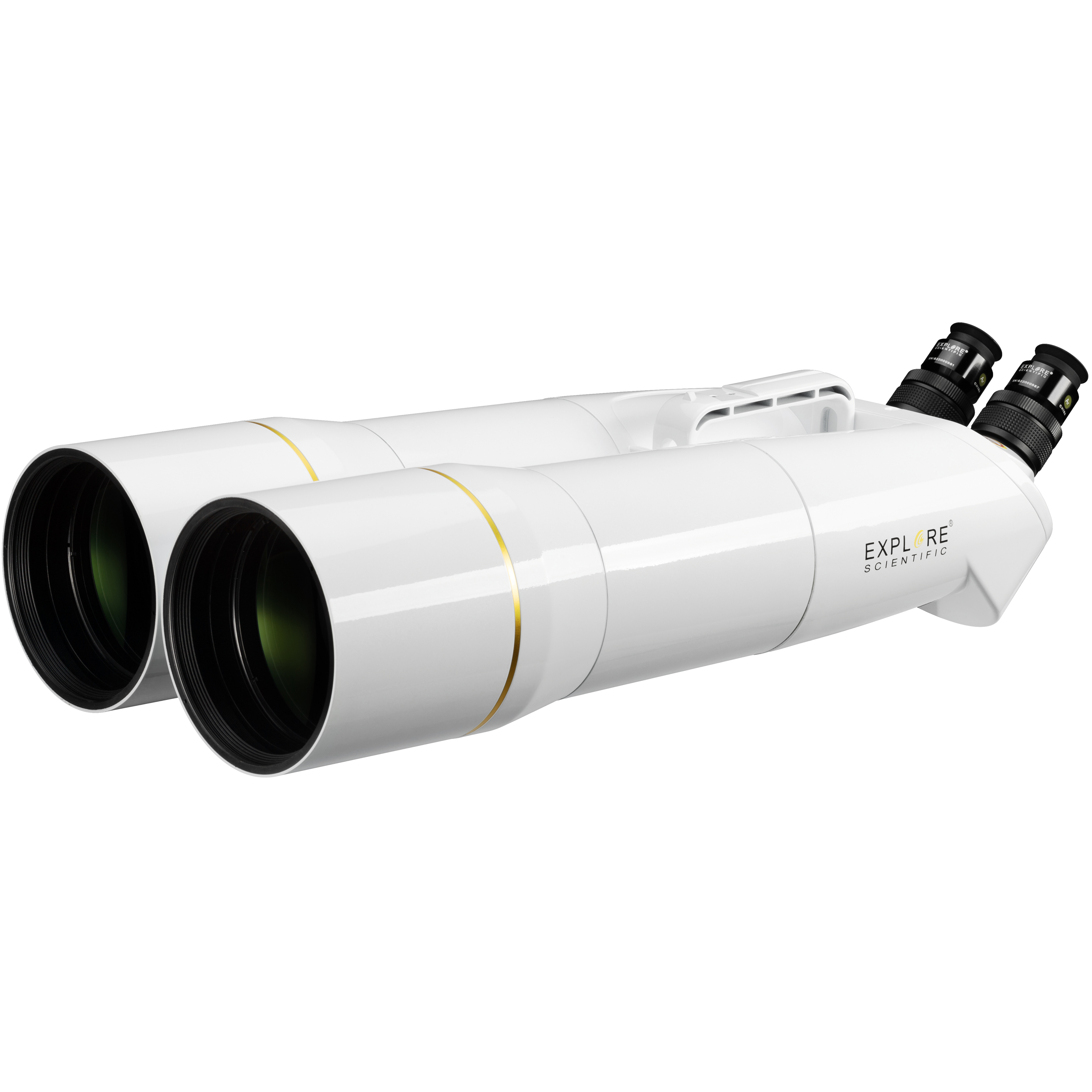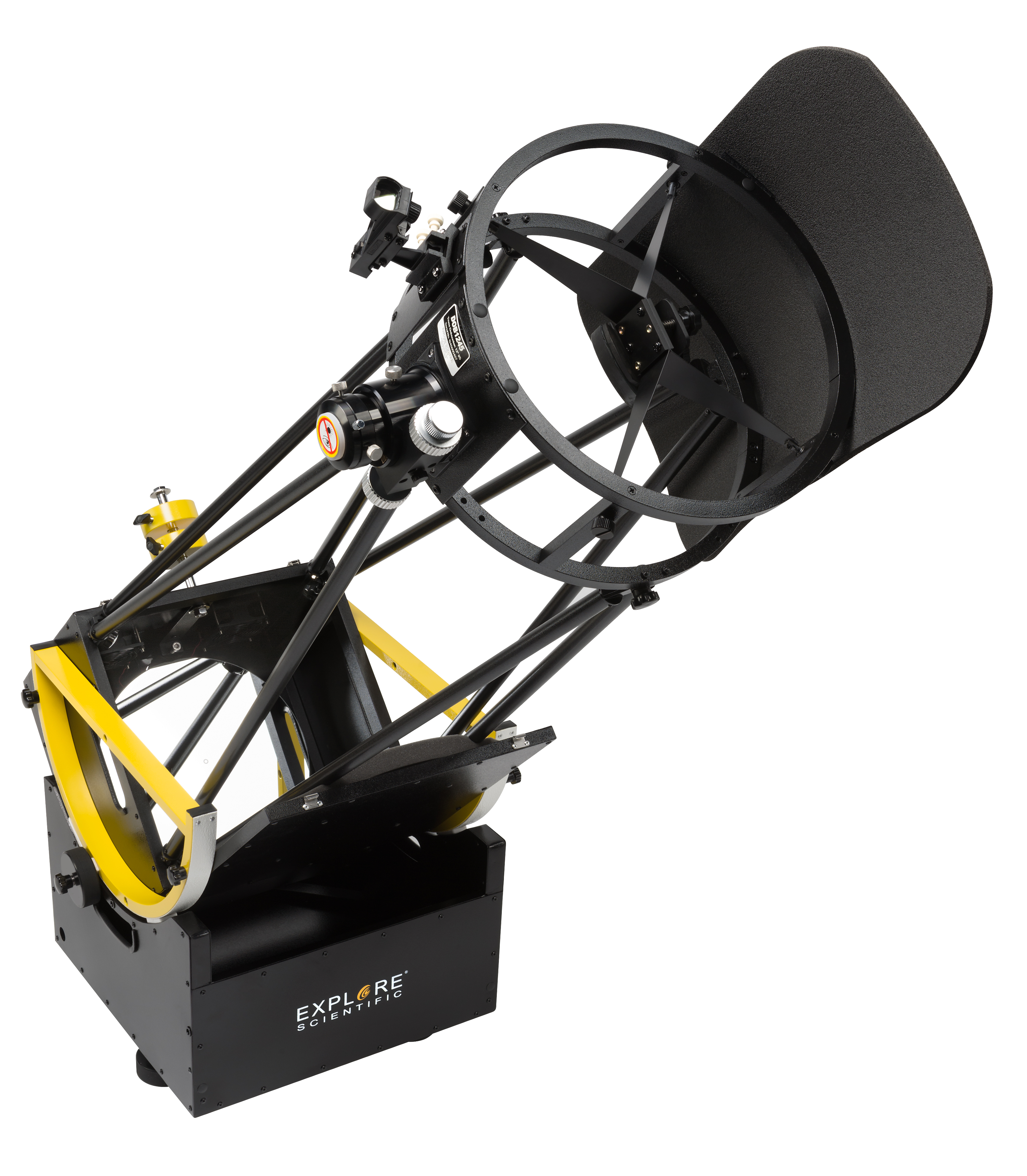Da gab es nicht viel zu Überlegen. Das Angebot von der Firma EXPLORE SCIENTIFIC, den großen 20“ Dobson für einige Nächte zu nutzen, war zu verführerisch. Und so wurde Ende Juli 2019 das Ausstellungsgerät aus den Hallen der Fa. BRESSER/EXPLORE SCIENTIFIC in das Auto verladen und ins benachbarte Borken transportiert. Verladen ist dabei der richtige Ausdruck. Das Teleskop ist wahrlich kein handliches Gerät mehr. Das Gesamtgewicht von 53 kg, wobei das schwerste Teil die Spiegelbox mit guten 35 kg darstellt, macht das Teleskop für den alleinigen Aufbau grenzwertig. Es ist eben kein Gerät, dass man mal schnell nach draußen stellt. Der Transport in einem Kleinwagen ist aber gut möglich. Die solide Gitterrohrkonstruktion in schwarz-gelb gehalten, sauste im Kofferraum meines Autos über die B67 in Richtung Heimat. In Erwartung einer klaren Nacht war ich neugierig auf das Bild, dass mir dieses Dobsongerät liefern würde. Bisher konnte ich „nur“ Teleskope bis 16 Zoll Öffnung nutzen. Ich selber besitze ein 10 Zoll Dobsonteleskop, das als Vergleichsgerät herhalten muss. Zugegeben, es ist ein ungleiches Duell - David gegen Goliath.
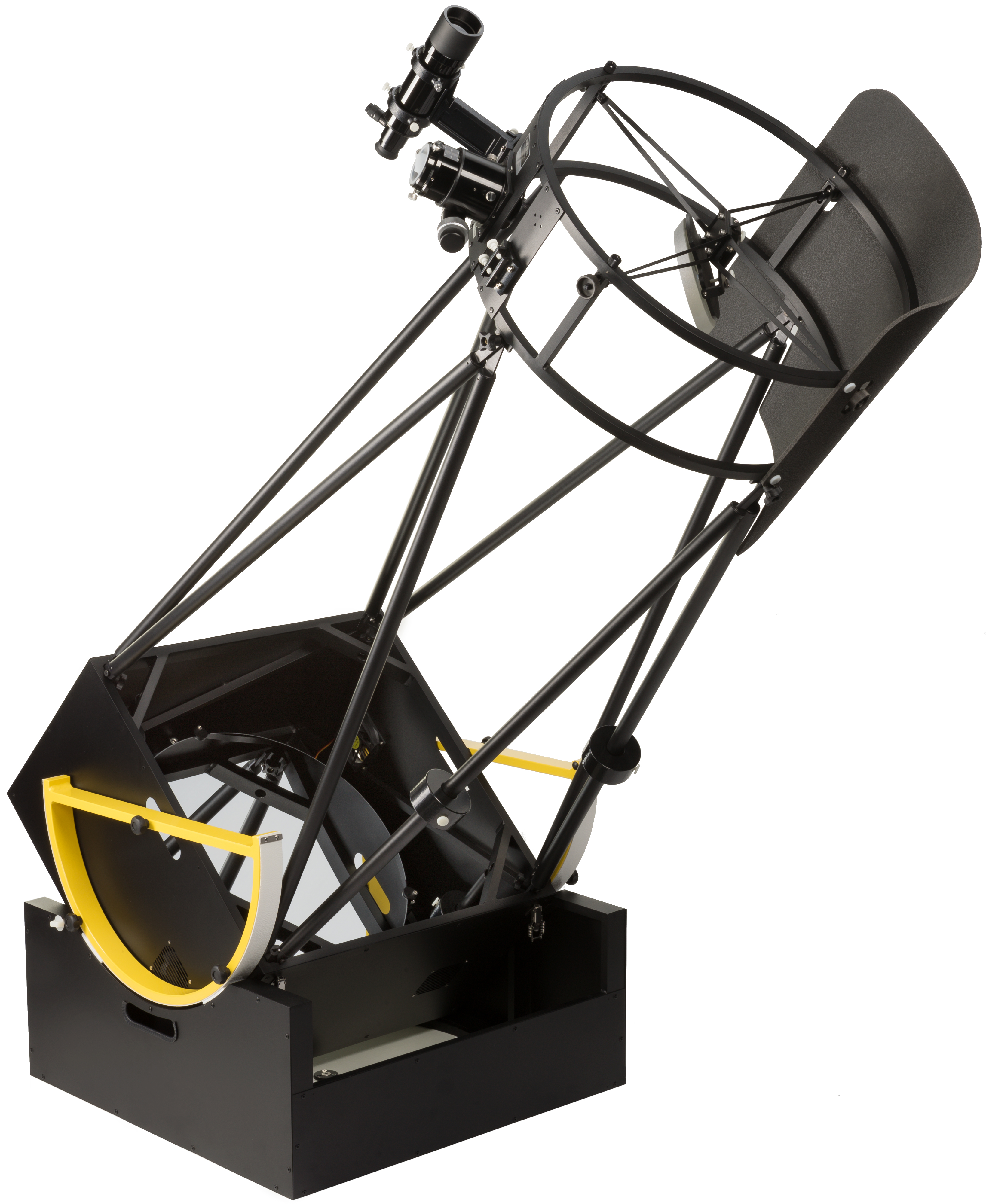
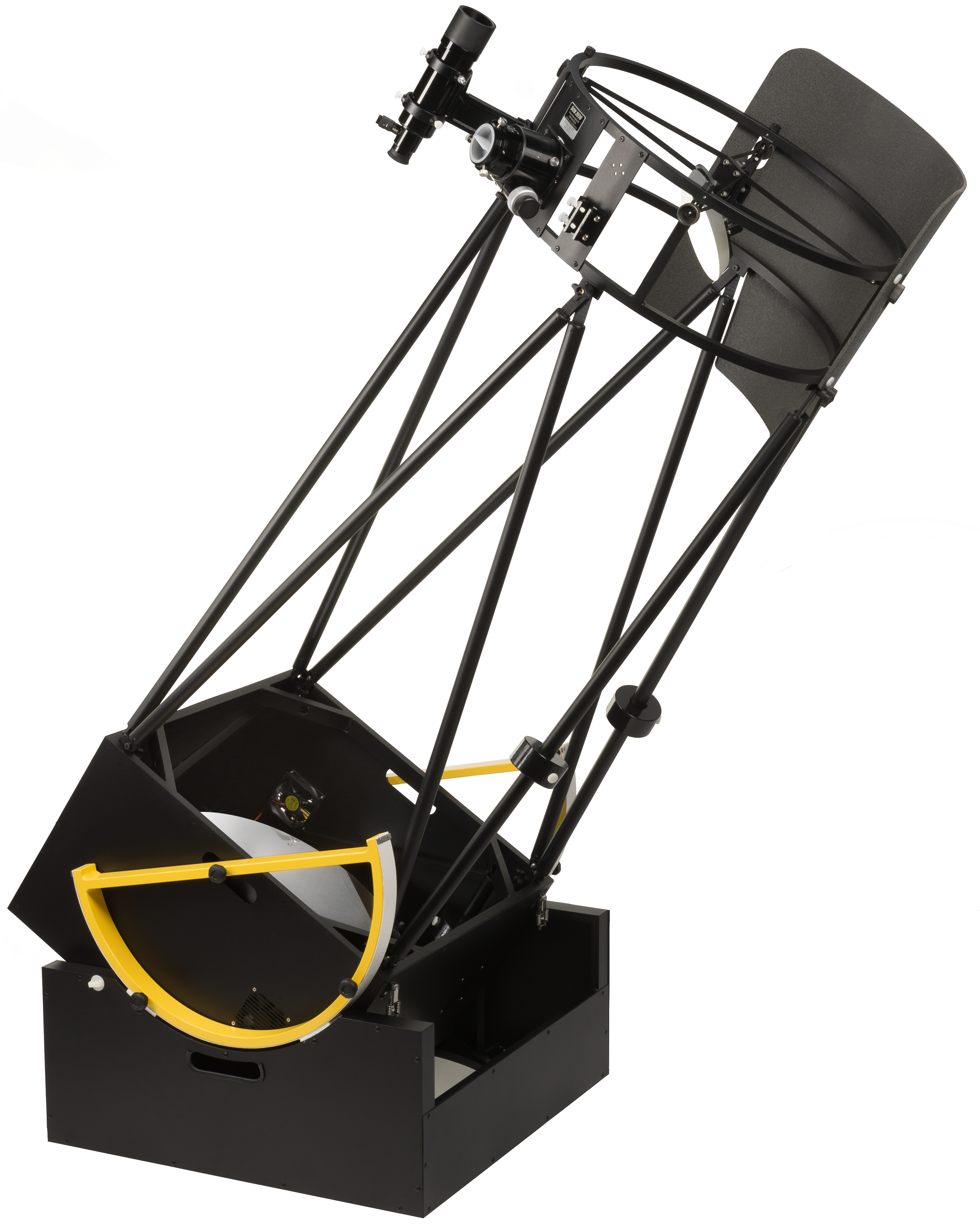
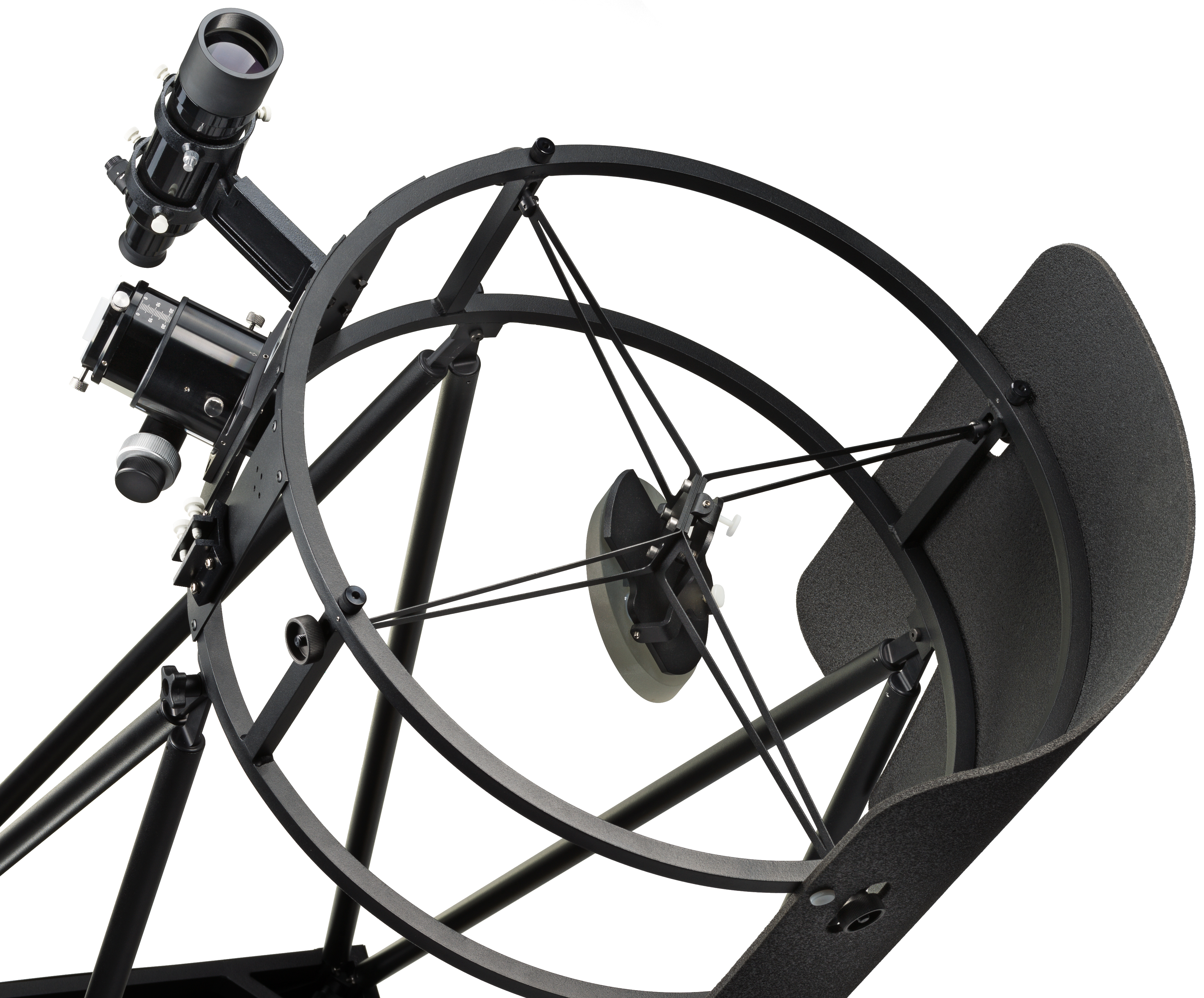
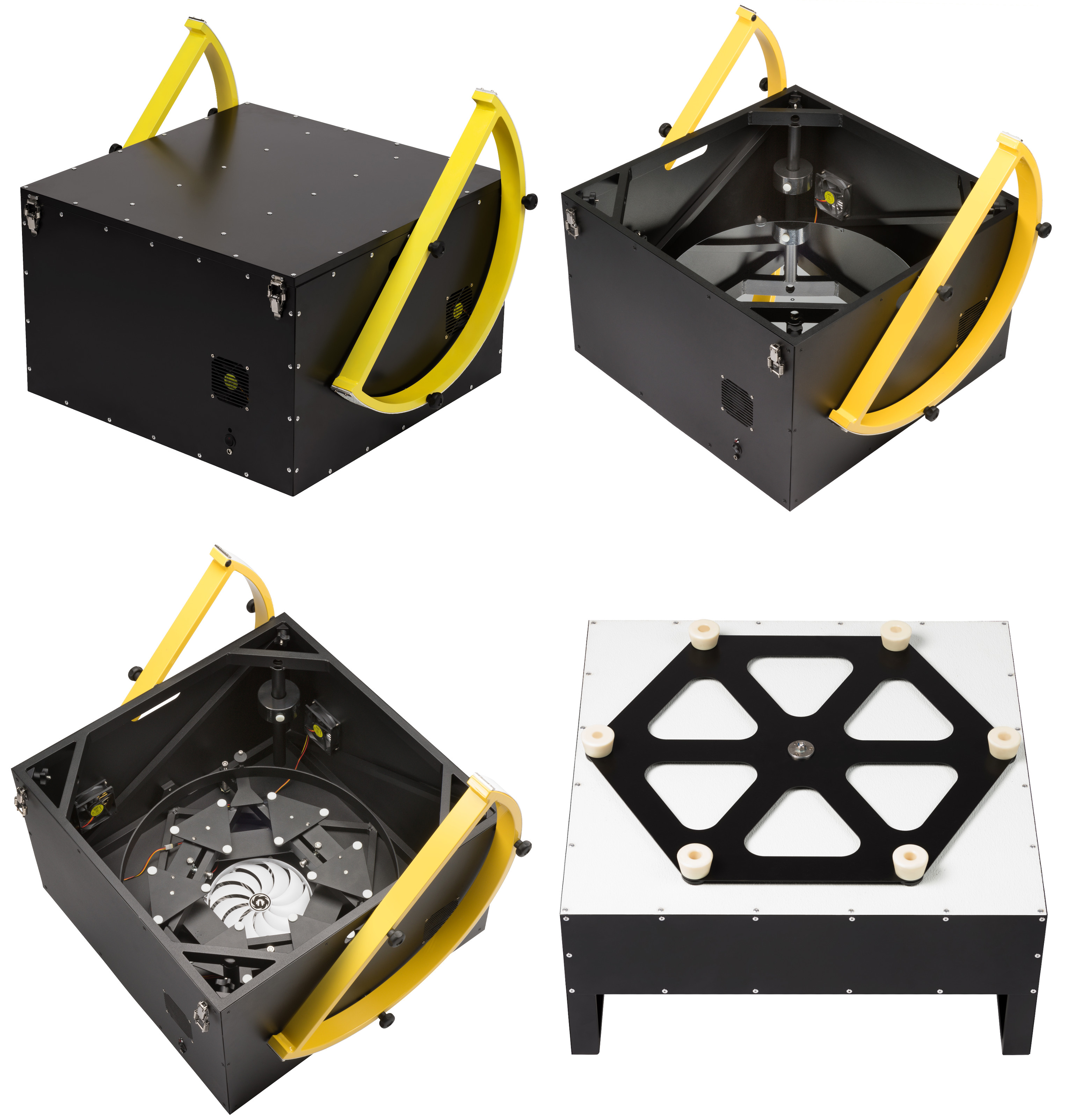
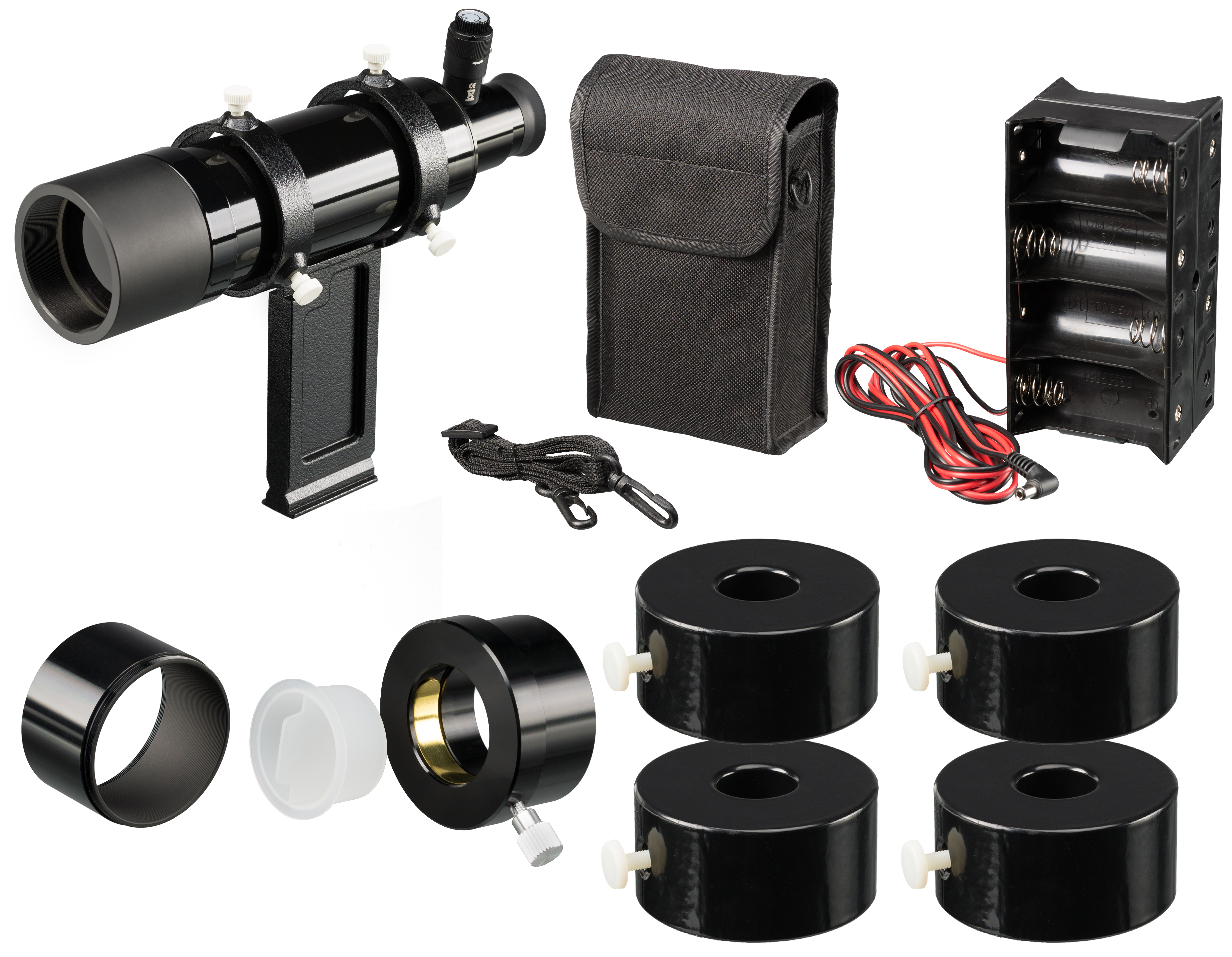
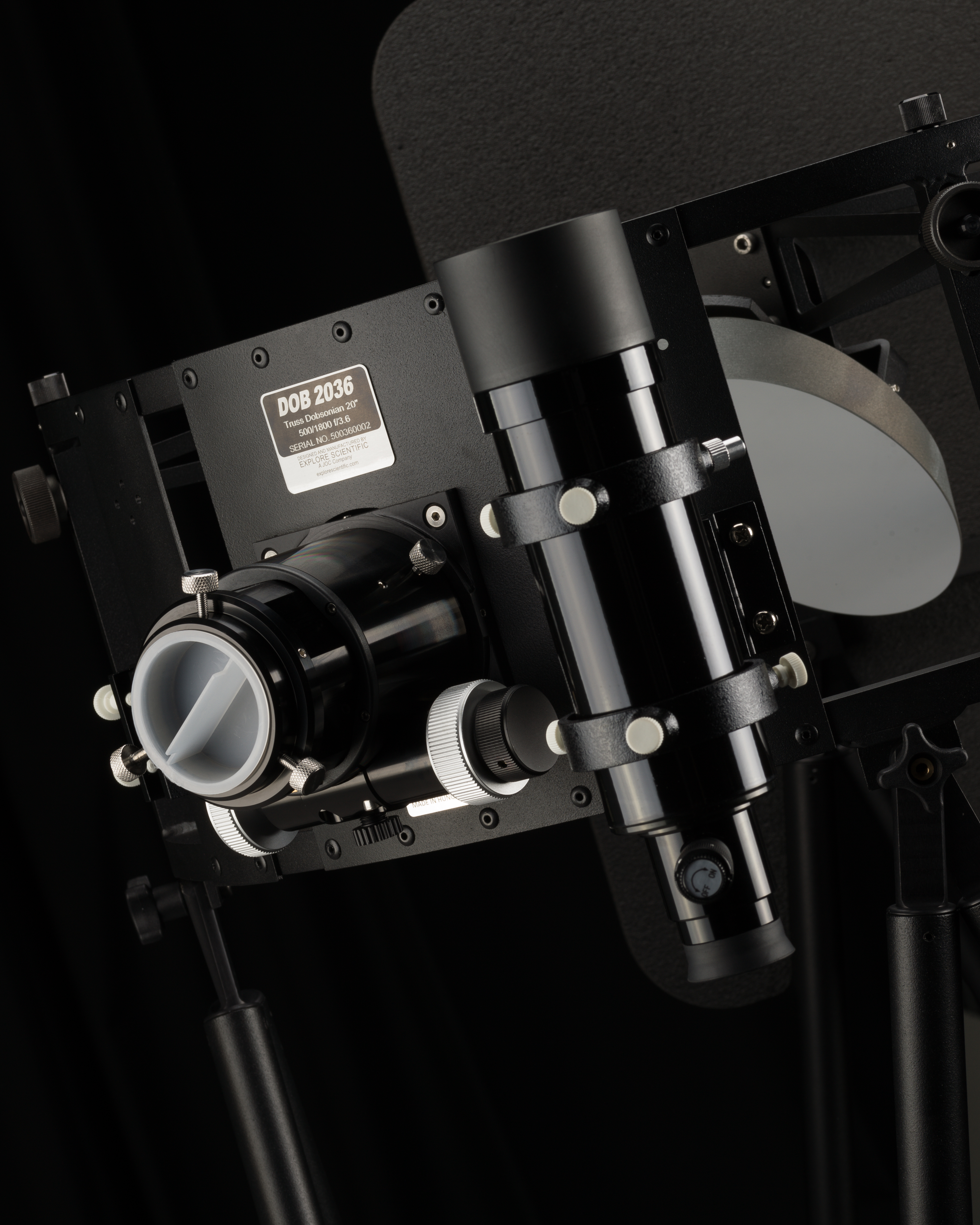


















Ultra Light Dobson 500mm f/3.6
- Truss-Dobson in full Aluminium construction
- Handcrafted in HUNGARY and GERMANY
- Quarz primary and secondary w. optical certificate
- Eyepiece height while pointing at zenith is 1,63 m
- Full welded rigid telescope structure - no rivets
- Collimation while observing with the delivered tooling
- Compacts dims for easy transportation
- DeLuxe 2,5" HEXAFOC focuser with 1:10 gear-reduction
- Large powder-coated yellow altitude wheels for smooth tracking
- 2 universal finder slots to enable an easy finder position
Testbericht zu EXPLORE SCIENTIFIC Ultra Light 20'' Dobson
von Christian Overhaus: Ein PRAXISTEST von Christian Overhaus aus Borken Westf. (Mitglied der Sternfreunde Borken e.V)
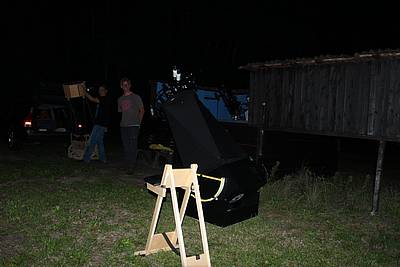
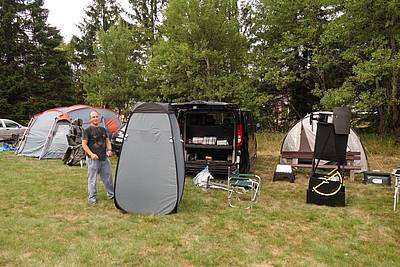
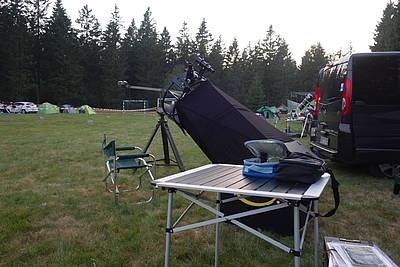
Zuhause angekommen lud ich die schwere Spiegelbox und das Unterteil der Rockerbox aus. Ich platzierte das Gerät auf den Aufbauplatz für die Nacht. Ein nachträglicher Standortwechsel war wegen des Gewichtes und der Größe nicht denkbar. Es ist ratsam, das Gerät zu zweit aufzubauen. Die Tubusstreben und den Hut mit der Fangspiegelhalterung mit dem Rest des Gerätes zu vereinen, ist allein nicht ganz einfach. Zwei Hände waren da nicht genug.
Ich suchte den anderen Weg und schraubte die Streben zunächst an den Hut, was überhaupt kein Problem darstellte. Dann ließ sich die ganze Konstruktion schön auf die Spiegelbox setzen und verschrauben. Fünf Minuten später stand die Konstruktion. Nun noch schnell den Blendschutz und das schwarze Tubustuch angebracht, fertig war das Teleskop. Es ist schon ein beeindruckendes Gerät. Der Hauptspiegel mit einem Durchmesser von 50 cm lässt den 10 Zöller daneben wie ein Spielzeug aussehen. Wenn ich daran denke, dass mein erster Blick in die Tiefen des Kosmos mit einem Teleskop geschah, dessen Spiegel gerade mal einen Durchmesser von 115 mm hatte!
Gespannt wartete ich auf die Nacht.
Nach Einbruch der Dunkelheit begann ich mit dem Justierlaser, die beiden Spiegel des Teleskops aufeinander auszurichten. Der Fangspiegel lässt sich an zwei Rändelschrauben sehr leicht bewegen, so dass der Laserpunkt in Sekundenschnelle die Mittelmarkierung des Hauptspiegels erreicht. Der Hauptspiegel kann mit drei Justageschrauben von der Oberseite eingestellt werden. Ein ca. 90 cm langes spezielles Justage-Werkzeug (langer Imbusschlüssel) ist dafür im Lieferumfang enthalten. Der gleichzeitige Blick durch das Teleskop während der Justage ist so also möglich. Die Justage an sich ist kein Problem und ging sehr schnell. Ich bin darin aber auch schon mäßig geübt.
Wenn man das Gerät einige Male aufgebaut hat, könnte ich mir vorstellen, dass man es innerhalb einer viertel Stunde aus dem Kofferraum heraus zum Einsatz bringt. Eine zweite Person ist aber unabdingbar.
Die erste Nacht mit dem Teleskop am heimischen Himmel war ein großes Vergnügen. Am Rande einer Kleinstadt wohnend mit dem Ballungsraum Ruhrgebiet im Süden, ist der Himmel hier am Standort nicht überragend gut. SQM-Messungen erreichen im Zenit Himmelshelligkeiten von 20,8 bis 20,85 mag. So war es auch spät in der folgenden Nacht. Es war zunächst nicht ganz wolkenfrei und zu Beginn vielleicht auch etwas dunstig. Zumal war es Ende Juli erst spät dunkel. Das Gerät konnte seine volle Leistung nicht zeigen.
Der Jupiter war der erste, den ich mit dem Teleskop beäugen konnte. Zunächst im 7,5 mm Okular, später dann noch bei gleicher Vergrößerung in einem Binokularansatz (Bino). Trotz der tiefen Stellung des Planeten im Sternbild Skorpion und bei schlechtem Seeing, war der Anblick einfach toll. Der Dobson lieferte ein schönes helles Bild, die Wolkenstreifen zeigten schöne Strukturen und der Große Rote Fleck zeigte deutlich seine Farbe. Der kleine Zehnzöller zeigte im Prinzip das Gleiche, jedoch kleiner, wegen der geringeren Brennweite des Teleskops (1800 mm zu 1250 mm). Und das Bild war natürlich viel heller im 20 Zöller. Die lichtsammelnde Fläche ist ja viermal so groß. Der Ausspruch Dobsonauten, dass Öffnung nur durch mehr Öffnung zu ersetzen ist, bewahrheitete sich an dieser Stelle eindrucksvoll. Bis zur richtigen Dunkelheit, genoss ich den Blick auf den fernen Planeten, der an diesem Abend 690 Millionen Kilometer Sicherheitsabstand zu mir hielt. Mit dem Teleskop kam ich bis auf zweieinhalb Millionen Kilometer an ihn heran.
Das Beobachtungsvergnügen mit einem Dobson-Teleskop ist nicht ausschließlich von der Öffnung abhängig. Mindestens genauso wichtig sind die gute Nachführbarkeit und die Stabilität des Gerätes. Der 20“ Dobson, ein Highend-Gerät aus ungarischer/deutscher Herstellung, ist in dieser Hinsicht über jeden Zweifel erhaben. Der technische Anspruch ist wegen der Größe des Teleskops und der höheren Vergrößerung ungleich höher. Der kleine 10“ Dobson lagert auf Teflonpads, die über eine Ebony-Star-Fläche gleiten. Diese Kombination hat sich bei den Dobsonauten als ideal erwiesen. Leider ist das Ebony-Star–Material nur noch begrenzt verfügbar, weil der Hersteller die Produktion einstellte. EXPLORE SCIENTIFIC setzt stattdessen auf eine Art GFK-Riffelblech. In der Praxis ist es beim 20 Zöller etwas schwergängiger, dass man mehr Kraft aufwenden muss als beim kleineren Gerät. Jedoch ist es von der Steifigkeit und Stabilität in jeder Lage des Gerätes erstaunlich gut. Die Nachführung bei 260-facher Vergrößerung mit dem Bino-Ansatz war überhaupt kein Problem. Trotz der großen Masse, die dort bewegt werden musste, war die Nachführung feinfühlig hinzubekommen. Ich hatte dabei noch nicht einmal die angebrachten Gegengewichte zum Ausgleichen von Überlasten benutzen müssen.
Das Aufsuchen der Objekte gelingt übrigens mit einem Telrad oder Sucherfernglas. Beides war am 20 Zöller montiert. Hinweis: Der Telrad Sucher ist ein optional erhältliches Zubehörteil und nicht im regulären Lieferumfang enthalten. Ich bin geübter Telradsucher und kam damit recht gut zurecht. Die Suche ist im Zehnzöller etwas leichter, weil Gewicht und Gleitfähigkeit der Montierung weniger Kraftaufwand erfordern, aber auch der Große kann ganz gut ans Ziel geführt werden.
Der Mehraufwand gegenüber des 10 Zöllers wird mit einem deutlich helleren Bild belohnt. Eines der ersten Ziele an diesem Abend ist der Kugelsternhaufen Messier 13 im Herkules. Dieser ist im 10 Zöller schon eine Augenweide. Im 20 Zöller ist er atemberaubend. Das 7er Okular zeigt ihn formatfüllend, tausende Sterne, haarnadelfein. Auch hier kann der Bino-Ansatz das Beobachtungserlebnis nochmalig steigern. Zwei Augen sehen eben mehr. Und die schöne schwebende Sternenkugel in 25000 Lichtjahren Entfernung ist nun mal eines der schönsten Ansichten des Nordsternhimmels. Eines meiner Lieblingsreiseziele am Sommerhimmel ist der Cirrusnebel im Schwan. Zu später Stunde, als es ausreichend dunkel war, griff ich zum Übersichtsokular. Den nötigen Kontrast zum Himmelshintergrund erreichte ich durch einen UHC-Filter. Die schön strukturierten Nebelreste einer Supernovaexplosion kamen auch unter Kleinstadthimmel sehr gut zum Vorschein. Der Zehnzöller, der praktischerweise ein integriertes Filterrad mit UHC und OIII-Filter besitzt, machte auch keine schlechte Figur, muss man sagen. Die Sichtbarkeit derartiger Objekte ist durchaus genauso stark an die Himmelsqualität gebunden, wie an die verwendete Optik.
Ganz klar im Vorteil war der 20 Zöller beim Planetarischen Nebel Messier 76. So schön strukturiert sah ich das Nebelwölkchen noch nie zuvor. Auch die vielen kleinen Sterne drum herum beeindruckten. Im Vergleich zum ]10 Zöller ist es wohl so, als ob man die Sonnenbrille abnähme. Sehr schick, würde ich sagen.
An diesem Abend konnte ich noch den Saturn beobachten, der ebenfalls tief im Sternbild des Schützen zu sehen war. Der hinterlassene Eindruck entspricht der Beobachtung von Jupiter. Die Cassiniteilung im Saturnring war sehr deutlich zu sehen, auch der Schatten des Planeten auf das Ringsystem zeigte sich deutlich.
Ein weiteres Highlight, wie ich finde, war der Doppelsternhaufen Hi und Chi Persei im Sternbild Perseus. Im verwendeten 30mm-Okular passen beide Haufen soeben ins Gesichtsfeld. Die vielen Sterne sind schon ein himmlischer Anblick, ausgesprochen schön…
Ende August durfte das Teleskop mit in den Harz zum St. Andreasberger Teleskoptreffen reisen. Dort, in 700 m Höhe über dem Meeresspiegel bei ausgezeichnetem Himmel, konnte das Gerät dann zeigen, was es leistete. Einen Sportwagen testet man schließlich auch nicht auf Feldwegen. Der Himmel über St. Andreasberg erreichte eine Dunkelheit von 21,56 mag/arcs. Es ist dort also nur halb so hell, wie im heimatlichen Borken. Für den Sternfreund ist der Anblick der prachtvollen Milchstraße mit dem bloßen Auge bereits ein Genuss. Das große 20 Zoll-Teleskop aber machte kosmische Landschaften sichtbar, die das Herz des Sternguckers höher schlagen lassen. Der schon begutachtete Cirrus-Nebel wirkte wie ein Gemälde. Die Optik des Teleskops konnte dabei auch die Bildqualität eines hochwertigen Okulars mit 82 Grad Gesichtsfeld wiedergeben. Besonders beeindruckend fand ich den Crescent-Nebel NGC 6888. Ist es zu Hause schon fast mühsam, die hellsten Filamente zu sichten, sprang einem die volle Sichel förmlich ins Auge. Die Galaxien um NGC 7331 und Stephans Quintett wurden auch zu leichter Beute. Unter diesen Bedingungen war die Beobachtung mit einem großen Teleskop eine faszinierende Angelegenheit. Kein Wunder, dass Großteleskope bei den Teleskoptreffen auf großes Interesse stoßen.
Lohnt sich ein so großes Gerät? Ich war ja skeptisch, um ehrlich zu sein. Der Aufwand, ein 20 Zoll Gitterrohr aufzubauen ist schon größer, als den 10 Zöller auf die Schnelle nach draußen zu stellen. Da geht die Tendenz zum Zweitgerät. Ist aber eine lohnenswerte Nacht in Aussicht, wird die Mühe sehr belohnt. Das Handling des Geräts ist etwas schwerer als beim Kleingerät, was natürlich nicht überrascht. Die Brennweite von 1,8 m ist für kleine Menschen vielleicht ein Problem. Ich bemesse 1,85 m und kann mit langem Hals und auf Zehenspitzen Sterne im Zenit beobachten. Die Einblickhöhe beträgt ja nur 1,63 m – im Vergleich zu anderen Geräten ist dies angenehm niedrig. Ein kleiner Tritt ist aber schon sehr hilfreich. Aber das liegt in der Natur der Dinge. Akrobatik von einer 3 m Stehleiter ist also nicht nötig.
Gibt es etwas zu verbessern an dem Gerät? Klar, würde es das. Die Integration eines Filterrades zum Beispiel ist sehr praktisch. Das Nachrüsten ist leider nicht so einfach, weil der Okularauszug weit in den Tubus hereinragt. Das Teleskop verfügt über eine aktive Spiegelkühlung. Ich kann nicht abschätzen, wie effektiv diese ist. Interessant wäre aber meines Erachtens die Möglichkeit einer Fangspiegelbeheizung zum Schutz vor Tau. Das sind aber Zubehörteile, die man selber anbringen könnte. Interessant wäre auch eine Art Schutzhülle als Garage für den Tag oder die Nacht, für den Fall, dass das Gerät einige Tage im Garten verbringen darf. Klar darf so etwas optional angeboten werden. Im Harz nutzten wir eine Campingumkleide, um das Teleskop außerhalb der Nutzungszeit vor Umwelteinflüssen zu schützen.
Die Sternbeobachtung mit dem Gerät ist ein großes Vergnügen, um es zusammenfassend zu sagen. Auch unter mäßigem Himmel, den man als Sterngucker in den meisten Fällen über sich hat, ist die Öffnung ein Zugewinn an visuellem Eindruck. Es ist aber schon ein Gerät, das man Fortgeschrittenen oder Vereinen empfehlen würde, also Menschen, die etwas Erfahrung mit dem Umgang mit derartigen Geräten haben. Den schnellen Zehnzöller ersetzt es nicht. Es ist ein „Dazu“-Gerät für besondere Abende. Es stellt sich schnell die Frage, ob der Preis für ein derartiges Gerät gerechtfertigt ist. Teleskope dieser Größe waren noch nie so günstig zu haben, wie jetzt. Zumindest nicht auf dem deutschen Markt. Die Langlebigkeit der optischen und mechanischen Teile sollten dem Beobachter viele schöne Stunden bescheren. Sicherlich sollte man die persönlichen Rahmenbedingungen abstecken: Wo lagere ich das Gerät? Wie und wo kann ich es nutzen? Bin ich auf Hilfe angewiesen?
Hat man auf diese Fragen Antworten gefunden, wird man viel Freude an dem EXPLORE SCIENTIFIC 20“ Dobson Teleskop haben.
Clear Skies,
Christian Overhaus
No telescope type has influenced amateur astronomy as radically as the dobsonian telescope. Before the introduction of this telescope type by John Dobson the vast majority of amateur telescopes were small inadequate refractors on shaky mounts - just good enough to show the polar regions on mars or the rings of Saturn. Bigger telescopes, like the Schmidt-Cassegrain telescopes, were restricted to the relatively small group of amateurs that could afford them.The brilliant combination of simple - but effective - mechanics and the largest aperture available led to a worldwide triumph of this concept. No other telescope type offers you so much light for your money as a good dobson. We have taken the motto held together by gravity and driven by yoghurt power and offer a modern version of the classic - designed by amateur astronomers for amateur astronomers. Despite its large aperture the telescope can be transported easily even in small cars and is assembled within minutes without tools. The construction was optimized for maximum rigidity with a minimum of mass. The combination of big altitude wheels and a optimized aluminium-sandwich construction allows for small movements even at high magnifications. The focus position is already positioned to accept our coma-corrector (part No. 0510330) . The ideal workhorse for the deep-sky enthusiast. A telescope with 500mm aperture gathers more than 5100-times more light than the naked eye. Details on planetary surfaces stand out even to unexperienced observers, and countless deep-sky objects show details and some color. Bright globular clusters are resolved down to the core and the view of the lunar terminator will provide a unforgettable experience.
The fast 20’’ f3.6 main mirror as well as the large 120mm secondary mirror are made of high quality quartz material, so the cooling time is reduced to a minimum and the Dobson is quickly ready for use. Every main mirror is delivered with an individual optical test certificate, which guarantees the highest capacity. A laser engraved center mark of the main mirror allows easy adjustment. The optical surface has a high-quality aluminum silvering with 94% reflectivity and an extremely resistant quartz protection layer. The mirror overcomes frequently occurring dew fogging and cleanups without any damages and guarantees a long service life.
A complete redesign of this Dobson was necessary to ensure the significantly increased requirements to stiffness and load bearing capacity of the optical components. All connections of the tube structure were made in the TIG welding process and no rivets and screws were used. This has made it possible for us to produce this 20’’ light weight Dobson so unbelievably stiff in spite of the low weight - a noticeably good quality which is searching for its match. The production of almost all mechanical components is carried out by our partners in Hungary and the final assembly of the optics and subsequent quality control takes place in Rhede, Germany.
The equipment details of the smaller Dobson models, which have been popular for years, have been taken over and even extended considerably. First of all, of course, the very good decomposability and transportability should be mentioned. Set-up and dismantling can be carried out without tools. The main and secondary mirrors are adjustable during the observation and only two adjusting screws have to be moved. Thanks to the use of precision ball-heads in the main mirror cell and a precision hinge for secondary mirror suppport, the adjustment is absolutely easy and guarantees excellent stability. All connecting parts of the tube trusses now consist of CNC machined aluminum and are attached by stainless steel dowel screws. The secondary mirror can now also be adjusted by the adjusting screws in the direction of the optical axis. The tried and tested 2.5’’ HEXAFOC focuser with 1:10 fine adjustment has been used for years - this allows vignetting-free observation despite the fast aperture ratio. A second 40° displaced installed mounting plate with a viewfinder shoe allows the rotation of the tube top in combination with a favorable position of the viewfinder tube or the mounting of an additional TELRAD viewfinder. The 6 supporting feet underneath the rockerbox offer a perfect stability and guarantee a smooth tracking in azimuth. Four smaller fans are installed in the side of the mirror box as well as a large fan is installed under the main mirror. This allows an even quicker adaptation to the ambient temperature and reduces the tube seeing (boundary layer removal). The lateral altitude wheels can now be stowed comfortably in the foam layers of the mirror box.
Last but not least another gimmick: The optical tube and the mirror cell are designed to use also on heavy equatorial mounts.
Dimensions for mobile use:
DIMS total: 680x680x1790mm; Rockerbox 678mmx678mmx347mm; Mirrorbox 590mmx590mmx361mm; Trusses approx. 1084mm; Truss diameter: 25mm; Eyepiece height while pointing at zenith approximately 1,63m; 20’’ Total net weight: 53 kg; 20’’ Mirror Box + Altitude wheels: 35,8kg; 20’’ Secondary Cage: 3,8kg; Rockerbox: 10,6 kg; 20’’ 4 Truss pairs: 2,8kg; 20’’ Primary mirror: 20kg
SPECIFICATIONS
- Truss-Dobsonian telescope in full Aluminium construction
- Handcrafted in HUNGARY and GERMANY
- Fast 20’’ f3.6 optics with 1800mm focal length
- Large 120mm secondary mirror (short axis)
- Quarz primary- and secondary mirror set
- Laser engraved central mark on primary mirror
- Eyepiece height while pointing at zenith approximately 1,63m
- Full welded rigid telescope structure - no rivets and no screws
- Telescope tube and rockerbox powder-coated
- Collimation while observing with the delivered tooling
- DeLuxe 2,5’’ HEXAFOC focuser with 1:10 gear-reduction
- 8x50 finder scope with red illuminated reticle
- Slider bearings made from TEFLON und GRP for smooth and precise movement
- Improved primary mirror cell with completely redesigned mechanics
- High precision hinge system for secondary mirror holder
- Secondary mirror holder with adjustment mechnism along the optical axis
- 6 larger feet to improve stability
- Counter-weights (4 x 1.0 kg) included
- 2 universal finder slots to enable an easy finder position
- Quick-lock fasteners with new springloaded design for comfortable use
- Large powder-coated yellow altitude wheels for smooth tracking
- Altitude wheels can be stored in the mirror box
- 5 cooling fans are speeding up the cool-down time
- Truss Dobsonian Telescope
- Individual optical test report for primary mirror
- 8x50 finder with red illuminated reticle
- Stray light shield for secondary cage
- Primary mirror collimation tool
- Battery compartment with bag for fans
- Extension tube for focuser
- Reducer 2’’/1.25’’
- Manual
BOX1: 600x600x380 approx. 44 kg ; BOX2: 690x690x330 approx. 17 kg ; BOX3: 150x150x1150 approx. 4 kg
| Bearing in alt-azimuth / RA: | Teflon |
|---|---|
| Bearing in elevation / DEC: | Teflon |
| Colour: | black |
| Finderscope: | 8 x 50 mm - illuminated |
| Focus Group [Telescopes]: | Advanced Amateurs, Specialists and Research, Visual enthusiasts |
| Focusing system: | 2.5" Hexafoc DeLuxe with 10:1 |
| Material: | Aluminium, Quartz |
| Material Primary mirror: | Quartz |
| Material Secondary mirror: | Quartz |
| Mount Type [Telescopes]: | Dobson |
| Optical design: | Newtonian Reflector |
| Product Family [Telescopes]: | Reflector telescope |
| Typ [Batteries]: | LR41 |
Accessories
Similar products
Customers also viewed



